List of cities in Bassaridia Vaeringheim
 f f
| |
| Map of major cities around Lake Morovia and the Strait of Haifa. | |
| City network overview | |
|---|---|
| Realm | * |
| Capital and largest city | * |
| Cities on canonical list |
|
| Core major cities (Vaeringheim proper) |
|
| Core minor cities | |
| Alperkin cities | |
| New South Jangsong – major | |
| New South Jangsong – minor | |
| Haifan Bassaridia – major | |
| Haifan Bassaridia – minor | |
| Bassaridian Normark | |
| Ouriana Province | |
| Ourianian dependency | |
| Caledonian dependencies | |
| Core geography |
|
| National rail operator | |
| Main rail corridor |
|
| Trade and ritual hub |
|
| Rolling stock and heavy industry |
|
The following is a list of cities in Bassaridia Vaeringheim, including all major and minor cities.
Overview
The urban system of Bassaridia Vaeringheim is organized around the littoral of Lake Morovia and the corridors of the Strait of Haifa, with cities grouped on the canonical list into core settlements of Vaeringheim proper, the Alperkin regions, the annexed Normarkian north, and the coastal Haifan belt. The national capital Vaeringheim anchors the network; other major nodes include Luminaria, Serena, Pyralis, Symphonara, Aurelia, Somniumpolis, Nexa, Lunalis Sancta, and Sylvapolis. Complementing the core are minor and frontier centres—such as Saluria, Aetherium, Ferrum Citadel, Acheron, Erythros, Catonis Atrium, Delphica, Koinonía, and Aureum—together with the Alperkin cities The Alpazkigz and Odiferia, the Normarkian pair Ardclach and Riddersborg, and the Haifan urban belt led by Keybir-Aviv, Tel-Amin, Diamandis, Jogi, and Lewisburg. The list also recognizes New South Jangsong’s cities—Skýrophos, Bjornopolis, Aegirheim, Norsolyra, Thorsalon—and their minors Pelagia, Myrene, Thyrea, Ephyra, Halicarn, as well as the Haifan minors Thermosalem, Akróstadium, Sufriya, and Lykopolis, and the Dependencies Bashkim, Ourid, and Tonar.
Geography and settlement pattern
Urban growth follows distinct physical belts: the intensively farmed Plains of Vaeringheim around Vaeringheim, the marsh and wetland arc to the south associated with Odiferia and the Haifan coast, the forested Gloom region that frames places such as Erythros, and the northern–western highlands that grade toward Aegirheim and Ardclach. Climatic diversity—from Mediterranean conditions in Aurelia and Tel‑Amin to oceanic zones in Luminaria and Symphonara, subarctic regimes at altitude in Aetherium and Aegirheim, and desert margins near Ferrum Citadel—shapes local economies and building traditions across the city network.
Transport and corridors
The national rail-and-ferry grid is operated by the Trans-Morovian Express (TME), headquartered in Lewisburg. The TME mainline runs from Lykopolis north through Somniumpolis, Erythros, Vaeringheim, Symphonara, and Skýrophos to Riddersborg, with ferry spurs linking Jogi across the Strait of Haifa and connecting Riddersborg to Ardclach. Rolling stock for both passenger and freight services is manufactured domestically by the Eosphorus Motor Company in Luminaria, tying heavy industry directly to the performance and expansion of the urban network.
Urban economy and roles
The economy is coordinated through the General Port of Lake Morovia in Vaeringheim, a centralized commercial complex that functions as the logistical and ritual epicenter for national trade and stipend distribution. High‑value flows include temple granite, timber and marine products from Ardclach and Riddersborg, coffee cultivated around Tel‑Amin, and advanced rolling stock and armaments associated with Somniumpolis and Luminaria’s factories. The port’s investor structure and integration with the TME make city growth strongly path‑dependent along rail and ferry corridors, with Diamandis’ diamond trade and Jogi’s agro‑processing among the best‑known specializations on the Haifan littoral.
Religion and civic culture
Public space across the cities reflects Bassaridian religious life. Temples and cult precincts of the Stripping Path sit alongside Hostian “Dream Spaces,” which are present in every major city and frame civic calendars and urban design. In Alperkin‑adjacent centres such as Erythros, Odiferia, Somniumpolis, and Acheron, the sacred plant Noctic-Rabrev—ritually regulated and widely used in cuisine and ceremony—shapes markets, guild life, and neighborhood identities. Together these practices contribute to a shared urban culture that remains visibly varied from Lunalis Sancta to Norsolyra.
Historical development and security integration
Urbanization around Lake Morovia began under Normarkian influence—traces still visible in Vaeringheim—and accelerated as Haifan and Alperkin trade deepened. In the contemporary era the Bassaridian War League’s campaigns re‑shaped the map: the Southern Lake Morovia Campaign brought Lewisburg into the state and enabled nationalization of the TME; the Haifan Bassaridia Campaign secured and integrated Keybir‑Aviv, Tel‑Amin, Diamandis, and Jogi; and the Lower Jangsong Campaign and subsequent operations consolidated Riddersborg and Ardclach as the keystones of Bassaridian Normark. These events, coupled with port‑centric economic governance, explain why new growth has clustered along secured rail, ferry, and port axes rather than sprawling uniformly.
Governance and the city network
Municipal development is coordinated within a national framework led by the Council of Kings—the Commander General of the Bassaridian War League, the Merchant General of the General Port of Lake Morovia, and the High Priestess of the Bassarid Temple of Vaeringheim—whose decisions link port investment, transport priorities, and cultic calendars to city planning. This centralized, port‑anchored model has made urban fortunes highly sensitive to investor confidence and security conditions along the Strait of Haifa and the Normarkian seaways, while providing the resources to maintain civic stipends and public works across both major and minor cities.
Cross‑regional snapshots
Core Vaeringheim cities concentrate administration, education, and temple finance—Vaeringheim with the General Port; Delphica with its university tradition; Luminaria with vehicle and locomotive manufacture—while the Alperkin belt around Pyralis, Nexa, Acheron, and Erythros supplies metals, ritual botanicals, and agrarian surpluses to the port. The Haifan cities—Tel‑Amin, Diamandis, Jogi, Lewisburg—are the hinges between inland and maritime trade, while New South Jangsong’s Skýrophos and Norsolyra and Normark’s Riddersborg and Ardclach project the network into northern seas and connect to the wider Keltian rail grid.
Major Cities in Bassaridia Vaeringheim
Vaeringheim

Vaeringheim’s story begins in the late 24th PSSC as a distant colonial outpost of the Kingdom of Normark, founded in 24.22 PSSC during the golden age of Keltian exploration. Perched on the timber-rich northern shore of Lake Morovia in central Keltia, the settlement served as a fort and trading post amid ancient forests. Normark’s rule was short-lived – by 24.53 PSSC, the collapse of Normark’s Keltian holdings left Vaeringheim abandoned and in ruins. In the ensuing decades, enterprising settlers from Haifa arrived (around the establishment of the Free State of Haifa), drawn by the region’s resources and strategic position. These early Haifan homesteaders carved out independent farmsteads, harvesting timber and mining minerals to trade with merchants from Haifa, Hamland, and Passio-Corum. According to local legend, it was during this era that the lake’s guardian spirits – the nymph Calypso and the storm-bringer Triton – were said to watch over the settlers, blessing fishermen with bountiful catches and calming the fiercest lake storms. Such mythic tales aside, Vaeringheim soon prospered as a frontier entrepôt, its humble Normarkian fortifications giving way to a bustling trade town.
History
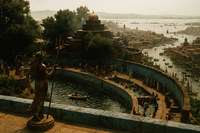
By the mid-35th PSSC, however, the lure of piracy on the Strait of Haifa transformed Vaeringheim’s trajectory. The town, initially resistant to the rising tide of buccaneers, ultimately fell under the sway of the notorious pirate Captain Ismael Hatch. Hatch established a foothold in Vaeringheim in the 35.50’s PSSC, operating from nearby Black Hatch Island and turning the settlement into an informal pirate haven. During this Maritime Markets period, Vaeringheim evolved from a sleepy trading post into a booming den of commerce – both legal and illicit. Merchant sailors, smugglers, and adventurers of all stripes flooded the city, and a thriving black market sprang up alongside legitimate trade. Vaeringheim’s reputation as a hub for contraband grew, even as its defenses were strengthened to protect the burgeoning wealth. It is said the city’s fortune at this time walked a fine line between mortal enterprise and divine chaos; many locals worshipped Dionysus in secret Bacchanals, attributing the wild prosperity to the god of wine and madness (a cultural undercurrent that would later blend into Bassarid religious life). Ultimately, the pirate-infested boom years cemented Vaeringheim’s importance on Lake Morovia, setting the stage for its incorporation into a greater empire.
With the rise of the Haifo-Pallisican Imperial Trade Union (the Bassarid Empire), Vaeringheim’s role shifted from rogue port to loyal imperial bastion. During the brutal Strait of Haifa Campaign – a theater of the larger War of Lost Brothers – Vaeringheim served as a crucial Bassarid stronghold and military operations center. Its strategic position at the crossroads of lake and strait made it the primary base for Bassarid forces, who fortified the city’s walls and canals against foreign navies and rival powers. Following these campaigns, Vaeringheim was formally integrated into the Bassarid Empire’s trade network, shedding its pirate anarchy for a new identity as a provincial capital of commerce. In the aftermath of war, waves of cultural change swept the city. The once purely Haifan and Normarkian character of Vaeringheim gave way to the influences of the nomadic Alperkin people, who inhabited the surrounding lands. Folded into the empire’s frontier known as the Bassarid Periphery, Vaeringheim became a melting pot of spiritual traditions. The Alperkin – renowned for their deep bond with nature – introduced their rites and beliefs, which intermingled with Pallisican (Bassarid) and older Hostian traditions. This synthesis birthed the Reformed Stripping Path, a unique religious movement emphasizing divine protection, communal spirituality, and rich ritual practice. Under Bassarid rule, the late 30s PSSC saw Vaeringheim thrive as a cosmopolitan city where Normarkian fort architecture stood alongside Alperkin yurts and Haifan bazaars, and where new cults and sects flourished under the aegis of the empire’s Temple authority.
The early 40s PSSC tested Vaeringheim’s resilience. The Hammish Civil War to the south sent refugees streaming into the city and disrupted regional trade, but Vaeringheim’s leaders managed to maintain stability by offering humanitarian aid while fortifying their borders. Soon after, the Bassarid Empire itself was plunged into the Haifan Civil War – a conflict between imperial forces and the rebellious state of Jezeraah – and Vaeringheim became the primary base of operations for Bassarid campaigns in the region. Throughout this brutal war, which raged around Lake Morovia and the Abeisan coast, the city had to perform a delicate balancing act. Bassarid generals marshaled troops from Vaeringheim’s garrison to fight Jezerite insurgents, and the city’s harbors teemed with warships and supply flotillas. Yet the local authorities also strove to keep the peace at home, leveraging diplomacy and alliances to prevent any one faction from seizing total control of Vaeringheim. Miraculously, when the Haifan Civil War ended in a stalemate, Vaeringheim emerged relatively intact – its autonomy preserved and its influence, if anything, enhanced by its role in the conflict. The city took a lead in post-war reconstruction and in re-establishing shattered trade routes, further bolstering its reputation as the economic heart of Lake Morovia. However, victory came at a spiritual cost. In the war’s aftermath, the empire was gripped by a period of disillusionment and strife remembered as the Leaving of the Host. Across the Bassarid realm – including Vaeringheim – people whispered that the guiding Host Spirit had abandoned them in anger at Empress Bréidle’s unorthodox rule. This sense of divine absence fueled unrest: opportunistic factions in Vaeringheim’s orbit took advantage of imperial weakness, and Alperkin chieftains and Noctic-Rabrev smugglers grew bolder. During this chaotic time, the city was infiltrated by a powerful Noctic-Rabrev cartel, which turned Vaeringheim into its headquarters for the black trade in a hallucinogenic flower and its associated occult practices. A series of gruesome outbreaks of Noctic Vampirism (a fatal affliction spread by the cult’s toxins) struck Vaeringheim in the late 42.80’s PSSC. Imperial officials failed to contain the vampiric plague and the accompanying wave of crime, undermining public trust. As imperial control crumbled, local Alperkin war-chiefs – guided by the Council of Saint Mothers of their faith – stepped in to fill the power vacuum, asserting authority over the city and its surrounds. For a time, it seemed the Bassarid era of Vaeringheim had ended in blood and darkness, with ancestral Alperkin leadership reclaiming the Plains of Vaeringheim amidst the empire’s spiritual exile.
The turning point came with a Bassarid resurgence in the mid-47th era PSSC. Determined to restore order and Bassarid rule, loyalist forces of the Bassaridian War League – many of them rogue units that refused to accept the Empire’s collapse – launched a decisive campaign in the Lake Morovia region. A local independence movement known as the Greater Morovian Independence Initiative, which had arisen to champion Morovian autonomy free of all outside powers, found itself in the crosshairs. In 47.58 PSSC (2023 AD), Bassarid War League troops seized Vaeringheim’s vital harbor – then known as the Independent Port of Lake Morovia – from the Alperkin and rebel holdouts. This victory was followed by the Morovian Frontier Campaign, a series of sweeping military operations that crushed remaining resistance and reasserted control over the plains and coasts around Vaeringheim. By capturing the port and securing the countryside, the Bassarid forces effectively ended the independence initiative. In the aftermath, the War League expelled the local Alperkin chieftains from power and re-organized the territory as a new nation: Bassaridia Vaeringheim. Declared formally in 47.58 PSSC, this associate domain reestablished Vaeringheim as its capital city. The reborn state was a hybrid of all its past influences – its capital built with Normark’s stone ramparts and mead halls, ringed by Alperkin tent-camps and sacred groves, graced with Haifan-style bazaars and canal districts, and overlaid with modern infrastructure and industry. In the five decades since, Bassaridia Vaeringheim has aggressively expanded its frontiers – for example, through the New South Jangsong Campaign that annexed lands all the way to Normark’s former coastline – and cemented itself as a dominant regional power. Today, Vaeringheim stands proudly as the capital of Bassaridia Vaeringheim and the crown jewel of Lake Morovia. Once more under Bassarid rule (now in a reformed, federated guise), the city enjoys peace and prosperity. Its General Port hums with activity as central Keltia’s largest trading hub, its people unite in reverence of a renewed faith, and its leaders sit at the helm of a constitutional stratocracy that blends military prowess, mercantile acumen, and spiritual authority. Vaeringheim’s saga – from Normark colony to pirate haven, imperial citadel, rebel prize, and finally capital of a rejuvenated Bassarid state – is a tale as epic and complex as any myth, one where gods and mortals together have shaped the destiny of the “City of the Lake.”.
Geography
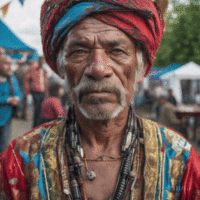
These plains, ideal for agriculture, have been the breadbasket of the region and contribute greatly to Vaeringheim’s prosperity. The climate here is humid subtropical (Cfa), with warm, humid summers and mild, wet winters that bring high rainfall. Seasonal storms sweeping off Lake Morovia are common, often causing lake-driven floods that have shaped the city’s architecture and urban planning. In response, Vaeringheim has developed a network of canals, levees, and hydraulic infrastructure to channel floodwaters – features which double as transport canals for commerce. The city’s streets are thus intercut with waterways, giving Vaeringheim a distinctive look: part fortress-settlement, part lakeport Venice. Many buildings near the waterfront are raised on sturdy foundations or stilts, and stone quays line the major canals, both to mitigate flood damage and to facilitate the unloading of cargo from barges. The natural harbor at Vaeringheim opens onto the Abeisan Inlet, where Lake Morovia’s swampy expanse narrows toward the Strait of Haifa. This inlet’s calm, brackish waters have historically been the city’s lifeline to the sea – and a strategic chokepoint guarded by lighthouse-temples and signal towers. Geography thus dictated Vaeringheim’s role as a gateway: whoever controls its port and inlet controls trade between the inland lake and the ocean beyond.
The surrounding environment profoundly influences Vaeringheim’s culture and cityscape. To the west sprawls the legendary Gloom Forest of Perpetual Autumn, a dense primeval forest where the foliage burns gold and red year-round. Sacred to the indigenous Alperkin tribes, this forest is steeped in spiritual aura – it is the spiritual center of the Alperkin religion, home to ancient shrines and burial grounds hidden among its shadowy groves. The Gloom Forest’s most famous inhabitant is the Archigós, a mythical golden-furred adlet revered as a manifestation of the Host Spirit itself. Travelers in the forest often encounter moss-covered statues of the Archigós along the woodland roads, particularly near the pilgrimage site of Erythros. Local folklore holds that the Archigós watches over the land, and stories tell of lost wanderers guided out of the fog by a flash of golden fur. The presence of this enchanted forest has influenced Vaeringheim’s urban design and spiritual practices. The city’s layout purposefully preserves corridors of green parkland that align with the forest beyond, creating “spirit paths” believed to let the blessings of the wilderness flow into the urban space. In some districts, great oak and ironwood trees (transplanted as saplings from the Gloom Forest) stand in communal squares, treated as living shrines where citizens leave offerings for the Host Spirit and nature divinities. Just south of the city, the coastline along the Abeisan Inlet gives way to marshy Coastal Woodlands and reed-filled wetlands, where the lake’s fresh waters mix with the strait’s tides. This liminal zone of marshes and small islands is rich in wildlife and is used by fisher-folk and Azure Sect mystics alike for solitary retreats. Not far to the south stretch the Southern Odiferae Wetlands, dense swamp jungles traditionally inhabited by Odiferian Alperkin tribes. North and west of Vaeringheim rise the Northern and Western Highlands, low mountains marking the historical frontiers of the realm. These highlands, once a barrier to invasion, are laced with old Normarkian watchtowers and Bassarid signal fires, and contain rich iron and coal deposits. The highlands’ mineral wealth spurred mining villages that supply Vaeringheim’s industries, while their snowy peaks are dotted with remote monasteries where hermitic priestesses observe the stars. Thus, in every direction, Vaeringheim is encircled by distinct natural regions – lake and swamp, forest and highland – each contributing to the city’s character. The fertile plains feed its people, the lake and inlet connect it to distant markets, and the mystical forest and hills inspire its art and faith. Even the architecture reflects geography: sturdy Normarkian stone keeps (built on high ground) protect against flood and foe, Haifan-style houses with courtyards catch cool lake breezes, and Alperkin yurts appear in seasonal encampments on the outskirts during tribal gatherings. In Vaeringheim, the urban and natural environments coexist in a carefully maintained balance. The cityscape is at once practical – adapting to climate and terrain – and profoundly symbolic, aligning with sacred geography. From the autumn-hued fringes of the Gloom Forest to the canals glinting with reflected sunlight, Vaeringheim’s geography is inseparable from its identity, providing not just a setting but a living framework for the city’s spiritual and civic life.
Economy
Vaeringheim’s economy is the powerhouse of central Keltia, rooted in its role as the General Port of Lake Morovia – the largest and most prosperous trading center of the region. The city’s lakeside port links the extensive inland waterways of Lake Morovia to global maritime routes via the Strait of Haifa, making Vaeringheim a pivotal junction for commerce. All manner of goods flow through its docks: timber and furs from the northern highlands, grain and livestock from the Plains of Vaeringheim, fish and pearls from the lake’s marshes, and exotic spices, wines, and ores imported from far-flung Micrasian markets. The General Port itself is more than a harbor – it is an integrated marketplace and financial institution in the Bassarid tradition. Trade in Vaeringheim operates on a unique investment guild system: wealthy patrons known as Regional Investors fund the port’s operations and, in return, receive dividends that they use to provide stipends to the populace. In essence, every citizen is tied to an investor or guild that ensures they receive a share of the nation’s wealth – be it food, goods, or services – as a social stipend. This cultic finance system has its roots in Bassarid economic philosophy, where commerce is interwoven with communal welfare and even spiritual duty. Profits from trade are distributed across society in a tiered manner: citizens represented by the largest, most successful investors enjoy higher stipends, but even the humblest laborer is guaranteed basic provisions through this system. The port’s council (headed by the Merchant General) manages trade policy, negotiates international agreements, and regulates the flow of high-value commodities, all while ensuring that commerce aligns with religious and ethical norms. It is said that in Vaeringheim’s markets, every transaction is watched over by both the merchants’ guild and the city’s patron divinities – a deal is not sealed until coin has changed hands and a small offering has been set aside for the gods.
Agriculture remains the foundation of Vaeringheim’s wealth behind the scenes, and the fertile hinterlands are dominated by powerful trade guilds and cooperatives. The Gladseed Farmers’ Union, for example, oversees vast rice paddies and wheat fields irrigated by the lake’s tributaries. Similarly, the Bulhanu Ranchers’ Association manages herds of Morovian water buffalo and hearty cattle that graze on the plains. Another major player, the Plains of Jogi Cooperative, cultivates staple grains (rice, oats) as well as specialty crops like Wisp Rice and Queen’s Garlic – delicacies famed across the empire. These agrarian guilds export foodstuffs in enormous quantities through Vaeringheim’s port, feeding not only Bassaridia Vaeringheim’s urban populations but also generating surplus for export. The bounty of the lake and land also supports thriving fisheries and artisan goods industries: Suncliff Fisheries sends boatloads of smoked eel and dried fish to market, while the Grand Cave Bee Meadery in the highlands supplies the city with prized honey mead. The Salurian Temple of Sacred Horehound brews medicinal tonics and spirits from local herbs, blending enterprise with ritual craft. In the markets of Vaeringheim, one can find everything from velvet worm meat (a local delicacy) to textiles dyed in the deep reds of Morovian mud, to high-grade steel weapons forged from highland ore. Manufacturing and services have grown as well – the city boasts shipyards that construct river junks and lake galleys, textile mills spinning both coarse hemp and fine haifa-silk, and a burgeoning financial sector where temples double as banks. Notably, Vaeringheim has embraced innovative technologies in recent years: the Roving Wind Farm Corporation operates floating wind turbines on Lake Morovia’s waters to generate clean energy, a project blessed by the Temple as harnessing Atos’ divine breath. Economic policy encourages competition between guilds and companies while preventing monopolies, in order to keep the marketplace vibrant and fair. Trade outposts from foreign partners – like traders from [[Moorland] or Ralgon – maintain a presence in the port, adding to the cosmopolitan bustle.
While most of Vaeringheim’s economy is state-sanctioned and publicly shared, the city has not entirely shed its shadow economy. A legacy of the pirate era lingers in secret: smuggling rings and black-market exchanges operate in the underbelly of the port. During the turbulent 40s PSSC, the Noctic-Rabrev cartel entrenched itself, trafficking the eponymous hallucinogenic flowers and other contraband. Although the Bassarid authorities have since cracked down (the cartel was weakened after the restoration of order), traces of the illicit trade remain in the form of hidden Noctic markets in back alleys, where one can discreetly buy narcotic blooms or esoteric artifacts. The government combats such activities through the Lake Morovia Blockade Fund, a regulatory fleet that patrols for pirates and smugglers, timing its operations with seasonal storm patterns to catch criminals off-guard. Moreover, the Baratar Corporation – a decentralized civilian militia – helps police commerce by registering independent traders and arming trusted merchant convoys. Through these measures, Vaeringheim attempts to integrate even the fringes of its economy into the fold, turning former privateers into licensed privateers and outlaw traders into legitimate entrepreneurs where possible. Today, the city’s economy is a study in contrasts and integration: communal yet capitalistic, devout yet pragmatic. Banks and counting-houses occupy former temples; guild halls host both prayer services and stockpile ledgers. Coins bear the images of both kings and gods. And always, the lifeblood of Vaeringheim’s wealth is the General Port – a living economic organism that not only fuels the city’s material needs but also funds its social services, military defense, and religious patronage through its all-encompassing investment system. This synergy of commerce, community, and cult has made Vaeringheim one of the most prosperous and stable cities in Keltia, a place where, as locals boast, “every exchange honors the polis and the divine alike.”.
Politics
Vaeringheim’s political culture is dominated by the great institutions clustered around the General Port and the central shrines of the Reformed Stripping Path. The Councilist Unity Front is usually the largest party, presenting itself as the natural steward of the Council of Kings and the General Port bureaucracy. It governs in close partnership with the Free Investors & Merchants League, which represents Port investors, shipping magnates, and financial houses, and with the Civic Reform Covenant, which speaks for jurists and temple legal scholars. The Morovian Social Cooperative has a strong base among dock workers and porters, while the Diaspora Bridges Movement channels the influence of citizens whose fortunes are tied to the vast Bassaridian diaspora in Keltia and beyond. Cults linked to Thalassa, Chrysos, and Micras itself tend to reinforce establishment parties that promise procedural stability, doctrinal orthodoxy, and uninterrupted Port revenues.
Culture
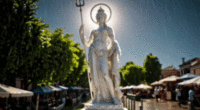
A fusion of Normarkian, Haifan, Bassarid, and Alperkin influences makes Vaeringheim a cultural crossroads. Art galleries, performance halls, and public installations flourish under guild and cult patronage. Religious life centers on the Stripping Path and the Reformed Stripping Path.
Vaeringheim’s culture is a rich blend woven from Normarkian, Haifan, Alperkin, and Bassarid threads, all shot through with mythic symbolism. At its heart lies the Reformed Stripping Path, the syncretic religion that dominates spiritual life in the city. This faith blends ancient Hostian teachings (worship of the cosmic Host Spirit) with the frenzied ecstasies of Pallisican (Bassarid) Dionysian rites, the nature-centered shamanism of the Alperkin, and the structured liturgy of the Bassarid Temple tradition. As a result, Vaeringheimis are profoundly devout yet religiously diverse in expression. The city hosts numerous cults and sacred orders, each devoted to different divine aspects. Two of the most prominent are the Azure Sentinel Sect and the Ordo Solis Invicti, which between them embody the dual maritime and solar pillars of Bassarid belief..
The Azure Sentinel Sect is the holy order dedicated to Thalassa, goddess of the seas and war, who is revered as Queen of the Planetary Divines. Based in Vaeringheim’s harbor districts, this sect is composed of elite mariners, warriors, and mystics sworn to protect the waters and uphold ancient maritime traditions. Its members – called Sentinels – are masters of seamanship and weather-witchery, known to harness the winds and waves through sacred magic. They act as guardians of coastal communities around Lake Morovia, ensuring safe passage for travelers and defending against supernatural threats from the deep. The Azure Sentinels exemplify Thalassa’s values of protection, skill, and courage. In Vaeringheim, one can often see blue-cloaked Sentinel priests performing dawn ceremonies at the docks, pouring libations of salt and wine into the water to honor Thalassa. Their main sanctuary is a seaside shrine carved into a cliffside cave, where the sound of waves echoes during prayer. Public rituals of the sect include the Rite of the Tidal Communion, in which followers gather by the lake under a full moon to immerse blades in water as a blessing for protection in battle. The Azure Sentinels also coordinate the city’s naval blessings: before Bassarid warships or trading vessels depart the General Port, Sentinel priestesses anoint the hulls with consecrated oil and bind charms to the masts to invite Thalassa’s favor. This sect’s influence extends into governance, as the Admiral of the Azure Sect often advises the Merchant General on matters like harbor safety and naval defense, blurring lines between religious duty and civic responsibility.
Complementing the sea’s cult is the Ordo Solis Invicti, the major cult devoted to Atos, god of the sun and creation. Centered in Vaeringheim alongside Thalassa’s worship, this order venerates Atos as the supreme source of light, life, and enlightenment. The Ordo Solis Invicti is famed for its splendid solar temples – architectural marvels built to capture and channel sunlight in intricate patterns across their sanctuaries. Many of the city’s grandest structures are Atosian temples with open-air atriums and mirrored domes that flood the interiors with cascades of reflected light at sunrise. These designs symbolize Atos’ radiance and the illumination of wisdom. High priests of the Ordo Solis are regarded as living conduits of Atos’ will, leading congregations with guidance said to be inspired directly by the sun’s rays. The cult plays a central role in community life, organizing annual festivals and rites that mark the turning of seasons and the new year. Every winter solstice, the Ordo performs the Rite of the Solar Transference, in which select initiates known as Solar Vessels undergo a week-long fast and then stand in a circle of specially angled mirrors at the Temple of Radiance as the noon sun streams down. This dramatic ritual is believed to infuse them with Atos’ wisdom and energy, which they then distribute as blessings to the people. The Ordo’s priests also serve on the city’s ruling Council of Elders: under Vaeringheim’s stratocratic system, the High Priestess of the Bassarid Temple of Vaeringheim (usually an Atosian or Dionysian arch-priestess) is one of the three heads of state alongside the military and mercantile leaders. This High Priestess mediates between the cults, ensures laws align with religious customs, and effectively makes Vaeringheim a sacralist city where temple and government work hand in hand. The Ordo Solis Invicti’s influence can be felt in policy decisions too – for instance, civic projects often begin with a solar blessing ceremony, and education programs emphasize enlightenment ideals drawn from Atos’ teachings. Thus, through both spiritual guidance and formal political power, the sun-cult shapes Vaeringheim’s society.
Though Thalassa and Atos dominate, the city’s spiritual life is multifaceted. The older Bassarid worship of Dionysus (known locally as Bassaridis, the vine-god) still thrives, especially during festivals. The Dionysian influence can be seen in Vaeringheim’s arts and nightlife: theatrical pageants reenact the god’s myths, wineries and taverns are decorated with ivy and panther motifs, and ecstatic dances sometimes fill the streets during certain holy days. Statues of Dionysus and related divine figures adorn public buildings, depicting scenes of revelry and divine madness alongside more sober religious art. This reflects the Bassarid cultural heritage – the acknowledgment that joy, wine, and even chaos are part of the sacred balance. The clergy of Vaeringheim include wild-eyed Maenads and Bacchantes (titles for female and male devotees of Dionysus) who lead seasonal rites to ensure fertility and communal bonding. They often operate in concert (and sometimes in tension) with the more austere Atosian priests, creating a dynamic religious scene where piety takes both solemn and celebratory forms.
The city’s calendar of festivals is packed with events that blend civic pride with mythological significance. Major holidays and observances include:.
- Bayram al-Nur – The Festival of Light: Celebrated on the 6th day of the New Year, this Atosian festival heralds the year’s fresh dawn. At sunrise, the High Priest of Ordo Solis Invicti ignites the First Flame using a polished mirror to focus the sun’s rays. This flame is carried to light thousands of lanterns and bonfires across Vaeringheim, illuminating the city in a golden glow. During Bayram al-Nur, the streets are hung with mirrors and radiant sun emblems. Come evening, processions of citizens wind through the canals carrying lanterns, so that the light of Atos literally dances on the waters. The day ends with a solemn Solar Invocation – a mass meditation by candlelight, in which the populace gathers in plazas to reflect on enlightenment and unity in Atos’ guiding light. Bayram al-Nur reinforces themes of renewal and hope, marking Vaeringheim’s collective recommitment to wisdom and prosperity each year.
- Mehtap Dalgası – The Moonlit Tide: Held on Thalassiel 19 (a date in the Thalassan lunar month), Mehtap Dalgası is a grand nocturnal festival devoted to Thalassa. At night, Vaeringheim’s beachfront and lake shore are transformed into an otherworldly scene lit by bonfires and the full moon. Participants – particularly mariners and Azure Sentinels – gather on the shore for tidal rituals. They sculpt effigies and offerings in wet sand as the waves recede, and as the tide comes in under the moon’s silver light, these creations are swept away as offerings to the sea goddess. Chanted hymns and the sound of conch shell trumpets echo over the water. Processions of robed mystics carry banners emblazoned with sea-blue and silver sigils through the city’s harbor quarter, reenacting Thalassa’s mythical journey across the heavens. The festival concludes with the release of hundreds of floating lanterns onto the lake – each carrying a whispered prayer or wish – a moving spectacle of tiny lights drifting on the dark water, symbolizing the goddess’s watchful presence over sailors in the night. Mehtap Dalgası celebrates Thalassa’s lunar aspect and the intimate connection between the city’s people and the rhythms of the lake and sea..
- Amáenarion – The Starlit Storytellers’ Night: Observed on Thalassiel 30, Amáenarion is a cultural festival unique to Vaeringheim that honors the Host Stars associated with Thalassa’s dominion. On this night, citizens gather around bonfires by the water’s edge – whether on lakebeaches or on barges afloat – and recount ancient legends of the stars Amáenu and Pythe. These two celestial figures, considered guiding stars in Bassarid lore, are said to be lovers or siblings (the tales vary) who sail eternally through the night sky. Storytellers, often from the Fellowship of the Crosswinds (a local bardic order), take turns narrating epic sagas and local myths, each tale highlighting a moral of courage, humility, or respect for the sea’s power. Families picnic under the open sky, children act out mythic scenes with costumes, and musicians play gentle tunes that sync with the crackling of fire and lapping of water. Amáenarion blends piety with art, reinforcing the community’s shared heritage through oral tradition. It is a time when even the most hardened sailor might shed a tear at a well-told tragedy of the sea, or a cynical merchant might find inspiration in a hero’s constellations. By dawn, as the last story is told, the city feels a renewed kinship – bound by narrative as much as by faith.
In addition to these, Vaeringheim observes numerous other holy days and civic festivals: the Rite of the Vernal Equinox (when farmers parade first sprouts to be blessed at the Temple), the Feast of Dionysus (a midsummer carnival of wine and music), and memorial days commemorating historical battles or the city’s founding. All festivals in Vaeringheim, whether solemn or joyous, tend to be spectacular public events – featuring processions, costumes, music, and often the consumption of sacred wines or foods. Wild processions with colorful costumes, reflecting both Bassarid and Alperkin styles, wind through the streets in many celebrations. It’s not uncommon to see rituals where participants enter trance-like states, a tradition carried from the Bassarid Dionysian rites, yet these are intermingled with the structured prayers of the Temple. The effect is a culturally vibrant atmosphere: Vaeringheim is known across Micras for its vibrant festivals that unite reverence with revelry, affirming the community’s faith and shared identity..
Religious influence permeates art, architecture, and daily life. Temples and public buildings are adorned with intricate carvings and mosaics depicting scenes from myth – whether it be Thalassa calming a tempest, Atos bestowing fire upon creation, or Dionysus dancing among satyrs. The city’s central forum sports a monumental statue of Thalassa rising from waves, while the Palace of Kings features stained-glass skylights that cast rainbow patterns (symbolizing the seven planets of Bassarid cosmology) onto its floors at certain hours. Civic symbols often carry mythic resonance: Vaeringheim’s coat of arms bears an image of a golden wolf (the Archigós of the Gloom Forest) and a rising sun, flanked by grapevines – encapsulating the Host Spirit, Atos’ light, and Dionysian bounty in one emblem. Education in Vaeringheim includes both scholarly subjects and instruction in the Epics; children learn to recite hymns and identify constellations as part of their schooling. The social structure is also touched by faith – a council of elder priestesses (sometimes called the Saint Mothers) holds significant moral authority, advising on matters from marriage rituals to dispute mediation. These women, representing various cults, have historically helped maintain harmony between the different religious communities.
Despite the heavy spiritual atmosphere, Vaeringheim’s culture maintains a balance between the sacred and the civic. Guilds and cults frequently collaborate; for instance, the Fishers’ Guild might sponsor an offering at a Thalassa temple before the start of fishing season, or the Armorers’ Guild may donate a finely wrought mirror to the next Bayram al-Nur ceremony. The stratocratic government, being a constitutional sacralist stratocracy, explicitly integrates religion: one of the three co-rulers is the High Priestess, and the legislature’s upper house (the Senate of Elders) reserves seats for representatives of each major Reformed Stripping Path cult. This ensures laws are reviewed for spiritual congruence, and that major cults like the Ordo Solis and Azure Sect have formal input in governance. Far from causing conflict, this integration has created a mythic-civic balance unique to Vaeringheim. When a new canal is dug, a priest of Thalassa leads the groundbreaking, and when taxes are levied, part is funneled to temple upkeep and charity. Public monuments often serve dual roles: the great lighthouse at the Abeisan Inlet is also a Temple of Thalassa, and the busy Grand Bazaar has at its center a shrine to Avaya (a local fortune goddess) where merchants pray for luck each morning.
In summary, Vaeringheim’s culture is one of piety, pluralism, and pageantry. The city’s people see no divide between their daily lives and the divine. A dockworker might whisper a prayer to the water at dawn, a merchant might consult an astrologer-priest before sealing a contract, and a soldier might undergo a blessing of the sun and sea before marching to war. Art and architecture celebrate the gods at every turn, from the smallest household altar to the grandest cathedral. Festivals and rituals fill the calendar, ensuring that communal faith remains strong and joyous. Yet this devout spirit coexists with worldly creativity – music, theater, poetry, and craftsmanship thrive under the inspiration of myth. Vaeringheim’s citizens are as proud of their city’s magnificent temples and lively festivals as they are of its libraries, bathhouses, and marketplaces. It is this seamless blending of the mythic and the civic that gives Vaeringheim its soul – a city guided by the stars and the sun, protected by the sea and the sword, and united by a heritage that is half history, half legend.
Important Citizens
Throughout its long history, Vaeringheim has been shaped by figures both legendary and mortal, whose deeds and influence still echo in the city’s identity:.
- Early Governors and Founders: From the outset, Vaeringheim’s fate was guided by pioneering leaders. The first Normarkian commander who established the fort in 24.22 PSSC is remembered as a hardy explorer who laid the city’s foundations under the guidance of Norse omens. Later, Haifan merchant-princes and governors took the helm, such as the Haifan free settler chieftains who organized the timber trade and kept the town alive after Normark’s fall. These early governors – whether Norse jarls, Haifan trade councilors, or Alperkin war-chiefs – each left a mark. They built the earliest defenses, negotiated the first trade pacts, and set cultural norms (for instance, it’s said a Haifan governor instituted the custom of offering a portion of each trade profit to the temple, beginning Vaeringheim’s tradition of blending commerce with piety). Though their names may be lost to time or known only in old chronicles, these founders are collectively honored as the Patrons of Vaeringheim. A frieze in the Council Hall depicts them in a line, passing a torch from one to the next, symbolizing the continuity of leadership.
- Calypso: In Vaeringheim’s mythology, Calypso is a revered nymph of Lake Morovia whose legend has transcended into civic lore. Described as a beautiful, immortal maiden of the waters, Calypso is said to have guided the earliest sailors on the lake, including Normarkian explorers, safely to shore. Many credit her with enchanting the site of Vaeringheim itself – a tale goes that Calypso lured the Normark settlers to the lakeshore by singing under moonlight, indicating a safe harbor. She embodies the gentler aspect of Thalassa’s domain: where Thalassa can be a wrathful sea queen, Calypso is the benevolent inland muse. In local art, Calypso is often depicted seated on a stone by the lake, playing a lyre or singing, with fish and birds gathered to her voice. The Azure Sentinel Sect holds that Calypso occasionally appears on foggy nights to give blessings or warnings to fishermen. Culturally, Calypso has become a symbol of Vaeringheim’s spirit of hospitality and guidance – the idea that the city, like the nymph, welcomes wayfarers and protects its own. A popular Vaeringheim lullaby about Calypso’s song is still sung to children, and the city’s main music academy is named the Calypso Conservatory in her honor.
- Triton: Another figure of lore, Triton is venerated as a guardian deity of Lake Morovia, often portrayed as a mighty merman or lake-dwelling god armed with a conch and trident. Where Calypso represents the lake’s calm, Triton represents its storms and martial fury. Legends hold that Triton dwells in the deepest parts of Morovia’s swamps and rises in times of peril to defend Vaeringheim. In one popular myth, when a great pirate fleet (some say led by Captain Hatch’s rivals) tried to sack Vaeringheim in the 36.00’s PSSC, Triton unleashed a thunderous storm that tore the pirates’ ships to splinters, saving the city. The Bassarid Temple syncretizes Triton as an aspect or lieutenant of Thalassa – a sort of divine general of inland waters. Statuettes of Triton can be found at Vaeringheim’s docks and on the prows of many local ships, as a token of protection. The city’s naval militia call themselves the “Sons of Triton” in ceremonial functions, and blow conch horns during military processions in emulation of him. Through the ages, many a Vaeringheim leader claimed the “favor of Triton” to bolster their legitimacy in protecting the city. Whether regarded as a literal deity or a symbolic guardian, Triton personifies the city’s resilience and martial readiness against any who threaten its shores.
- Captain Ismael Hatch: A historical figure turned folk hero (or villain), Captain Hatch was the infamous privateer who dominated Vaeringheim in the mid-35th era PSSC. A cunning and charismatic leader, he is remembered for transforming Vaeringheim into his pirate enclave during the height of the Maritime Markets of Haifa. Hatch’s legacy in the city is complex. On one hand, he introduced an era of lawlessness – the “Hatch Years” – marked by smuggling, duels in the streets, and pirate flags flying brazenly over the harbor. On the other hand, local lore also credits him with a certain rough justice and prosperity; he repaired the crumbling Normark fortifications to secure his base, and some say he spent lavishly in the markets, enriching locals with pirate gold. In Bassarid lore, Ismael Hatch is practically legendary: the Strait of Haifa narratives often mention him as a figure whose adventures inspired generations of pirates. In Vaeringheim, sites like the so-called “Hatch’s Cove” (a hidden inlet supposedly where he hid treasure) and an old tavern that claims to be his former headquarters keep his memory alive. After Hatch’s disappearance from history, many myths sprang up – some say he was an incarnation of a trickster god testing Vaeringheim, others claim he sailed off to become one of the immortal Host Stars. Modern Vaeringheim views Captain Hatch with a mixture of infamy and affection, often featuring him as an antihero in local plays and songs. The annual Market Faire even has a tradition where a performer dressed as Hatch “raids” the festival in a playful reenactment, only to be driven off by a personification of the city’s Guard. This encapsulates how the city has made peace with that chapter of history, turning a once-dark figure into a character of its enduring legend.
- Council of Saint Mothers: While not a single individual, the Council of Saint Mothers is a historically important assembly of elder priestesses and wise women who have guided Vaeringheim’s spiritual and social life from the shadows. During the anarchic times of the Leaving of the Host and the Noctic plagues, it was the Saint Mothers (representing various Alperkin clans and Bassarid temples) who stepped up to organize relief and defense when official governance faltered. They appointed war-chiefs to defend holy sites and villages, coordinated cures and containment for the vampirism outbreaks, and preserved a semblance of order steeped in moral authority. Even after Bassarid rule was restored, the Saint Mothers remained influential mediators between the indigenous Alperkin population and the Bassarid state. They are credited with negotiating terms that spared many local communities from harsh reprisals. In modern times, the Council of Saint Mothers works closely with the High Priestess, and its members often hold honorary seats in the Senate of Elders for their role in religious affairs. Respected by commoners and elites alike, these matriarchs are seen as the conscience of Vaeringheim. They remind the Council of Kings of the people’s needs, arbitrate disputes that secular courts cannot resolve, and ensure that ancient traditions (like burial rites in the Gloom Forest tar-pits or seasonal fertility dances) continue unbroken. An example of their quiet influence: it was the Saint Mothers who advocated for the preservation of the Gloom Forest as protected sacred land, an effort that succeeded in law and saved the forest from over-exploitation. The inclusion of their legacy in “Important Citizens” underscores that in Vaeringheim, leadership isn’t only about warriors and politicians – it’s also about the guardians of culture and faith.
- High Priestess Suriyana al-Bashir (current): In the present day, one individual stands out as a defining figure in Vaeringheim’s character – the current High Priestess of the Bassarid Temple, Suriyana al-Bashir. As High Priestess and a member of the ruling Council of Kings, Suriyana wields tremendous influence over both religious and civic matters. A scholar-priestess of mixed Haifan and Alperkin heritage, she is renowned for her eloquent sermons and her firm but compassionate leadership. It was Suriyana who spearheaded the recent revival of classical Bassarid arts in the city – she commissioned new murals and statuary depicting not just gods but also heroes of Bassarid history, thereby bridging secular and sacred storytelling. She also initiated a program where the Temple’s coffers fund public schools and hospitals, reflecting the Bassarid ideal of unity between spiritual and public welfare. Politically, Suriyana is seen as a moderating force on the Council; she often mediates between the Commander General’s militaristic faction and the Merchant General’s capitalist faction, invoking religious principles of balance and justice. Under her guidance, public festivals have become more inclusive, incorporating both the high ceremonies of the Temple and the folkloric performances of common folk. Though a relatively young High Priestess, Suriyana al-Bashir has quickly become the soul of modern Vaeringheim – a living symbol of the city’s union of piety, wisdom, and governance.
- Noctic-Rabrev Cartel Leaders: Not all influential figures are celebrated. The leaders of the Noctic-Rabrev cartel (whose names remain shadowy, known only in whispered alias like “The Red Masque” or “Silent Alp”) hold a dark sway in Vaeringheim’s recent history. In the 42.80’s PSSC, as Bassarid control waned, these clandestine figures exploited the chaos to build a narcotics empire, pushing the toxic Noctic-Rabrev leaves and fostering the spread of Noctic vampirism. They operated through a network of corrupted officials and fanatical cultists, nearly turning Vaeringheim into a city of night. Their reign of terror – marked by midnight assassinations and plague-like outbreaks – was a pivotal challenge that the city had to overcome. Ultimately, their power was broken by joint efforts of the Bassaridian War League and Alperkin shamans (with lore crediting the intervention of the Host Spirit’s fury to cleanse the vampiric taint). Nonetheless, the legacy of the cartel is a cautionary tale etched into Vaeringheim’s collective memory. Plays and novels now depict the “vampire kings” as villainous archetypes, representing the consequences of straying from the righteous path. In a perverse way, even these dark characters have shaped Vaeringheim’s identity – the city emerged from their shadow with a renewed commitment to unity and vigilance. Annual memorials are quietly held for the victims of the vampirism outbreaks, and the phrase “to remember the Noctic night” has entered local parlance as a call to remain watchful against internal rot and external corruption.
Each of these citizens – be they legendary nymphs and gods, historical pirates and priests, or anonymous councils and villains – contribute to the grand narrative of Vaeringheim. They are immortalized in the city’s songs, statues, and stories. Wander through the Plaza of Heroes, and you will see Calypso and Triton depicted in mosaic underfoot. Visit the Great Library, and you will find Captain Hatch’s exploits recorded alongside the deeds of ancient kings. Attend a Temple court, and you may hear Suriyana invoke the wisdom of the Saint Mothers or the cautionary tales of the Noctic fall. In Vaeringheim’s living culture, past and present converse constantly. This interplay of mythic and mortal influences ensures that the city’s identity remains as robust and dynamic as the figures who shaped it – truly a place where history and legend walk hand in hand through the marketplace of modern life.
Luminaria
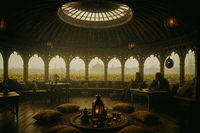
Luminaria is a Bassaridian city in central Keltia, east of Lake Morovia on the rolling Plains of Vaeringheim. Founded as an Alperkin nomad camp in the 24th era PSSC, it grew into a permanent settlement after Bassarid migrants arrived during the rise of the Haifo‑Pallisican Imperial Trade Union. Today the city is renowned for its devotion to the dawn goddess Eos, for hosting the influential Order of Aurora Mystica, and for its serene atmosphere—a marked contrast to the bustling port of Vaeringheim.
History
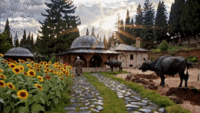
Laid out around natural springs by early Alperkin clans, Luminaria became a waypoint for caravans crossing the Plains of Vaeringheim. In the mid‑30th era PSSC, settlers aligned with the Haifo‑Pallisican Imperial Trade Union introduced Pallisican commerce and temple architecture. Piracy in the nearby Strait of Haifa and trade with Vaeringheim accelerated growth.
The 35.50s PSSC saw the town drawn into the orbit of the Maritime Markets of the Strait of Haifa when privateer Ismael Hatch used it as an inland provisioning post. With the demise of the pirate confederation and the subsequent Strait of Haifa Campaign of the War of Lost Brothers, Bassarid rule solidified.
In the 42nd era PSSC the Leaving of the Host crisis reached Luminaria: outbreaks of Noctic Vampirism linked to a Noctic‑Rabrev cartel coincided with rebellion by the Greater Morovian Independence Initiative. Nearby caves and tunnels became insurgent redoubts until the Bassaridian War League crushed the revolt in the Morovian Frontier Campaign of 47.58 PSSC. The fall of the break‑away Independent Port of Lake Morovia and its reorganisation as the General Port of Lake Morovia aligned Luminaria firmly with the new state of Bassaridia Vaeringheim.
The city remained peaceful during later expansions—such as the New South Jangsong Campaign and the Lower Jangsong Campaign—and became a centre of the Reformed Stripping Path. Modern Luminaria is administered through the Council of Kings and represented nationally by High‑Priestess Selene Amaranth.
Geography
Luminaria stands amid gentle wheat‑and‑sunflower prairies a day’s ride east of Lake Morovia. Small seasonal rivers feed the town’s wells and irrigate surrounding farms before draining toward the Abeisan Inlet. The climate is humid‑oceanic: long mild summers punctuated by thunderstorms, cool rainy winters, and frequent dawn mists that give the city its name.
Below ground lies a labyrinth of limestone caverns once used as nomad shelters, later as supply depots during the Morovian Frontier Campaign, and now converted into meditation halls, reliquaries, and archives. The skyline is low: circular Alperkin yurts and adobe shrines mingle with domed Bassarid basilicas. At the centre rises the terraced “Cathedral of Dawn”, mother‑temple of the Order of Aurora Mystica.
Economy

Agriculture—grain, legumes, medicinal herbs, and heliotropic sunflowers—remains the economic mainstay. Produce and hand‑looms travel west to Vaeringheim or south via caravan to the General Port of Lake Morovia. Two regional agrarian cooperatives dominate trade: the Gladeseed Farmers’ Union (cereal export) and the Atterian Cattle Drivers Company (dairy and hides).
Local craft industries thrive. The Onceanic Boot Company fashions durable footwear from ethically sourced Oceanic Armored Rhino hide; its wares fetch high prices across Keltia. Modern light‑industry is led by the Eosphorus Motor Company, Bassaridia’s chief manufacturer of wagons and automobile chassis. Hospitality and pilgrimage complete the economy: tea‑houses and inns operated by the Conclave Illuminara cater to scholars and devotees who flock to seasonal festivals.
Politics
Politics in Luminaria is heavily shaped by dawn rituals, underground shrines, and the city’s reputation as a centre of contemplative mysticism and Hostian Dream practice. The Path of Renewal Party is the dominant force, positioning itself as guardian of ethical governance, spiritual care, and doctrinally grounded reforms drawn from cults such as the Order of Aurora Mystica and the Conclave Illuminara. The Civic Reform Covenant finds support among temple jurists, archivists, and those who fear ecstatic excess without legal restraint, while the Councilist Unity Front remains important as the party that can translate Luminaria’s mystical concerns into the language of national policy. The Morovian Social Cooperative and Diaspora Bridges Movement build smaller but meaningful constituencies among shrine workers, students, and families connected to external study and pilgrimage routes.
Culture
Spirituality defines civic life. Dawn bells summon citizens to greet Eos with hymns; sunset sees lantern vigils dedicated to Tarsica through the Conclave Illuminara. The annual Dawnrise Festival celebrates the synchronous blooming of the sunflower plains, followed by spring’s Chag Or Hadash, midsummer’s lunar rite Mehtap Dalgası, late‑summer storytelling of Amáenarion honouring Host Star Amáenu and Host Star Pythe, and autumn’s art‑driven Häparion beneath Host Star Häpi. Even sombre fasts like the Day of Abandonment draw large, candle‑lit processions through the plaza.
Education is inseparable from faith: the Order of Aurora Mystica runs libraries teaching astronomy, herbal medicine, and poetry as paths to enlightenment. Wall mosaics depict sunrise deities; philosophers debate in open‑air courtyards; flute‑led dances at dawn weave devotion with art. Visitors describe Luminaria as a city where the physical and the metaphysical greet the sun together.
Important Citizens
Legend credits the city’s founding enlightenment to Aurora—mortal daughter of Eos—who guided early Alperkin and Bassarid settlers toward coexistence. Her contemporary, the philosopher‑sage Lux, authored commentaries still studied in shrine schools; an obelisk of Lux stands at the forum’s centre. Myth also names Eosphorus (“Bringer of Light”), son of Glinos and Eos, as Luminaria’s celestial guardian, inspiring the branding of the Eosphorus Motor Company. Another local demigod, Aether, reputedly pacified disputes with a calming aura and remains patron of scholars seeking clarity. In recorded history, settler‑chief Marcellus Soran mediated the first mixed council in the 35th era, while modern leadership rests with High‑Priestess Selene Amaranth alongside the national Commander General and Merchant General in the Council of Kings. Yet in the hearts of citizens, the eternal luminaries—Aurora, Lux, Eosphorus, and Aether—shine brightest, embodying the city’s enduring mission to welcome each new dawn in wisdom and peace.
Serena
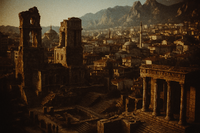
Serena is a city in far northeastern Bassaridia Vaeringheim, built atop the ruins of an ancient Normarkian military outpost. Nestled high in the Ismaelean Mountains of the Northern Highlands, it has evolved from a strategic garrison into a renowned spiritual center. Today, Serena is home to the Harmony Sanctum, a Reformed Bassarid sect devoted to Micras, the Lady Divine of Balance and Wisdom. The city’s ethos centers on harmony and equilibrium, reflecting its transformation from a place of conflict to one of enlightenment.
History
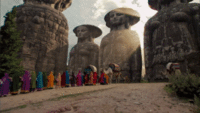
Serena’s history is defined by cycles of conquest and renewal. Founded during antiquity as a Normarkian frontier outpost, the settlement guarded a key mountain pass and asserted Normarkian influence in the highlands. In later eras, as Bassarid power expanded into the region, Serena became a critical staging post for Bassarid military operations – notably during the tumultuous Strait of Haifa Campaign and the Haifan Civil War. Throughout these conflicts, the city’s strategic location made it a base for armies and even pirate contingents: contemporary accounts from the War of the Harpy describe Bassarid-allied pirate groups operating in nearby waterways, with Serena providing overland support and refuge. Following the collapse of the Haifo-Pallisican Imperial Trade Union, Serena and the surrounding highlands were absorbed into the new polity of Bassaridia Vaeringheim, blending Bassarid governance with local traditions. Under Bassarid rule, mercenaries of the Morovian-led Anti-Noctic League also used Serena as a headquarters in their campaign to eradicate the illicit Noctic-Rabrev trade that once plagued the region.
Over time, the city’s focus shifted from warfare to faith. By the 50th PSSC era, Serena emerged as a cradle of the Reformed Stripping Path movement, guided by the Harmony Sanctum cult. This spiritual movement – an offshoot of the Bassarid religion – preached balance and wisdom as an antidote to the strife of prior decades. The Harmony Sanctum gained influence over local governance, supplanting the old warrior leadership with a council of priestesses devoted to Micras. In this era of renewal, Serena became known as a city of peace, its tumultuous past symbolically cleansed. The juxtaposition of past conflicts and present harmony is central to Serena’s identity, embodying a journey of resilience and rebirth. Public memory still preserves echoes of earlier times: the ruins of Normarkian fortifications and temples (such as the crumbling Temple of Eos on the outskirts) stand as reminders of foreign rule, even as new shrines and institutions transform the city into a beacon of enlightenment. Serena’s history thus spans from tribal highland settlement and Normarkian colony to Bassarid stronghold and finally to a spiritual sanctuary, mirroring the broader historical tides of Bassarid and Alperkin influence in the region.
Geography
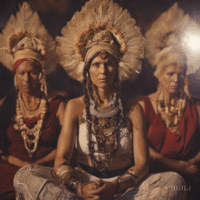
Situated in the rugged Ismaelean Mountains at the northern edge of Bassaridia Vaeringheim’s frontier, Serena is surrounded by dramatic highland scenery. Its landscape is characterized by rolling foothills, dense semi-autumnal forests, and winding rivers that cascade down from the mountain slopes. The area’s subpolar oceanic climate (Cfc) brings cool summers and cold, wet winters; steady precipitation year-round feeds the alpine forests, and snowfall is common at higher elevations. These natural features not only lend Serena defensive advantages – the high terrain historically protected it from invaders – but also imbue the city with serene beauty. On clear days, one can see distant peaks crowned with snow, while mist often gathers in the wooded valleys and sacred groves near the city.
Important natural and sacred landmarks dot the region. Just outside Serena, travelers encounter an ancient megalithic sculpture known as the Daughters of Micras. Believed to predate both Normarkian and Alperkin civilizations, this carved stone assembly is sacred to the Harmony Sanctum and serves as a pilgrimage stop for those seeking the blessings of Micras. Scattered around the hills are numerous Normarkian ruins – crumbling walls, weathered watchtowers, and the remnants of a Temple of Eos – all relics of the city’s time under Normarkian rule. These ruins have become part of the landscape, often overgrown by forest, and locals regard them with a mixture of reverence and curiosity. Within Serena itself lies the city’s sacred grove, a tranquil stand of ancient trees that the faithful consider a living temple. For centuries, this grove has been a site of meditation and prayer, symbolizing peace; even recent social unrest in Bassaridia Vaeringheim has targeted the grove’s sanctity, underscoring its importance to Serena’s identity.
Economy
Serena’s economy blends traditional highland livelihoods with Bassarid mercantile enterprise. The surrounding hills and valleys support agriculture adapted to the cool climate – hardy grains, root vegetables, and medicinal herbs are cultivated in terraced farms. Animal husbandry (notably mountain goats and sheep) also thrives, providing wool and dairy products for local use and trade. Residents are skilled in craftsmanship; the city’s artisans produce finely woven textiles, wood carvings, and metalwork that reflect both Normarkian and Alperkin influences. These goods, along with agricultural produce, are sold in Serena’s markets and find their way to the wider region via trade caravans. A winding caravan route connects Serena to the General Port of Lake Morovia, the great marketplace of the Bassarids, allowing local products to be exchanged for imported goods and luxuries. In recent years, improved mountain roads (and a spur connecting to the Trans-Bassaridia rail network) have further integrated Serena into continental trade routes, enabling swifter movement of goods and travelers to and from the once-isolated highlands.
Politics
Serena’s political life is that of a commercial satellite of Vaeringheim: pragmatic, Port-oriented, and focused on tariffs, warehouse contracts, and trade schedules more than on doctrinal disputes. The Free Investors & Merchants League and the Councilist Unity Front typically dominate, the former representing merchant guilds, the latter guaranteeing constitutional stability and good standing with the Council of Kings. The Morovian Social Cooperative picks up support in market wards and among casual labourers, particularly when freight rates rise faster than stipends, while the Civic Reform Covenant ensures that Port-linked contracts and zoning laws are not seen as nakedly exploitative. Shrine influence is present but secondary, usually expressed through demands that economic growth respect basic cult norms and festival calendars.
One of Serena’s most notable industries comes from an unusual source. The city is famously home to the Commune of the Garganid Apostles, a Bassarid merchant cult that specializes in producing a prized organic fertilizer. This fertilizer is made from the droppings of the native Garganram, a hardy highland beast endemic to the Northern Highlands. The Commune harvests and processes Garganram guano, which is rich in nutrients, and exports it as a valuable agricultural commodity across Bassaridia Vaeringheim. Their enterprise, part spiritual cooperative and part trade guild, exemplifies Serena’s ability to turn local natural resources into economic strength. In addition, the city hosts periodic highland fairs where neighboring settlements barter timber, furs, and ore for Serena’s crafts and fertilizers, reinforcing regional economic ties. Serena’s infrastructure reflects its layered history: ancient stone roads and foundations laid by Normarkian engineers are still in use, now supplemented by modern conveniences such as electric lighting and telecommunication relays. Many modern buildings are interwoven with ruins – for example, a bustling marketplace might occupy the former Normarkian barracks – creating a cityscape where old walls buttress new shops and temples. This blend of old and new infrastructure facilitates commerce while preserving the city’s heritage.
Culture
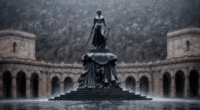
Serena’s culture is deeply rooted in the principles of balance, wisdom, and spiritual harmony. As the home of the Harmony Sanctum, the city serves as a major center of the Reformed Stripping Path, and daily life is suffused with religious devotion. The teachings of Micras – goddess of balance and wisdom – are celebrated through regular rituals, meditation circles, and public lectures that emphasize unity and enlightenment. High Priestesses in flowing ceremonial attire lead congregations in prayer at dawn and dusk, times believed to be especially sacred for seeking equilibrium between day and night. The city’s architecture embodies its syncretic heritage: Normarkian stone fortresses and pillars, remnants of old outposts, have been repurposed into foundations for Bassarid shrines and libraries. Meanwhile, carved wooden longhouses with intricate Alperkin motifs stand alongside classical Bassarid temples, creating an eclectic streetscape. These structures are often adorned with symbols of the Host Spirit and planetary divinities, blending Normarkian reverence for the sun and stars with Alperkin nature worship and Bassarid cosmology. Serena’s very layout, with its concentric circles of temples, gardens, and markets, is said to reflect a mandala of cosmic harmony – a design influenced by Bassarid spiritual geometry merged with local traditions.
The people of Serena express their culture through vibrant festivals and artistic traditions. One of the city’s most cherished celebrations is the Symposion Eirinis, held annually on Atosiel 30. During this festival of peace and knowledge, citizens gather in the central amphitheater to share wisdom through poetry recitations, philosophical debates, and a communal “harmony feast.” The tradition of the Symposion, with its open forum of ideas, hearkens back to both ancient Bassarid symposiums and Normarkian Thing assemblies, illustrating Serena’s fusion of cultural practices. Another major festival is Amaprion, observed on Thalassiel 50, when citywide processions wind through Serena’s streets adorned with floral wreaths and lanterns. These processions honor Host Star Amap, a celestial entity associated with peace and interconnectedness. During Amaprion, families decorate their doorways with symbols of the star, and choirs sing hymns that blend Alperkin folk melodies with Bassarid liturgical chants – a musical reflection of Serena’s mixed heritage. Artistic expression is likewise esteemed: Serena’s artisans produce devotional art such as tapestries depicting Micras and her daughter Harmonia, as well as carvings of local nature spirits. The statue of Harmonia at the heart of the city is a focal point for cultural life. Here, offerings of flowers and handwritten prayers are laid daily, and storytelling circles often form around the statue in the evenings, where elders recount the tales of Serena’s trials and triumphs. Through these festivals, arts, and communal traditions, Serena’s culture vividly illustrates the syncretism of Normarkian, Alperkin, and Bassarid influences, united by the city’s enduring pursuit of harmony.
Important Citizens
Serena’s lore is rich with figures—both mythical and historical—who have shaped its identity. Foremost among them is Harmonia, celebrated as the city’s patroness and guiding spirit. According to local legend, Harmonia was born of the goddess Micras and a mortal father, making her a demi-goddess who walked among the people of Serena in ancient times. As a High Priestess of the Harmony Sanctum, Harmonia was instrumental in teaching the early citizens how to balance the natural and social orders. She is credited with mediating conflicts between Normarkian settlers and Alperkin tribes, and with performing miracles that brought peace during times of great discord. Today, Harmonia’s legacy endures in Serena’s very fabric: a grand bronze statue of Harmonia stands in the central plaza, and the annual Symposion Eirinis festival is said to echo the first gatherings for peace she convened. Children learn of her deeds in school, and her name is invoked in blessings for conflict resolution. In architecture, the main hall of Serena’s council building is called the Hall of Harmonia, its walls inscribed with scenes from her life.
Another revered figure is Gaia, the daughter of Plateau in local mythology. Gaia is remembered as a nurturing presence – a demi-goddess of the earth who could commune with the land itself. Serena’s legends say that Gaia dwelt in the nearby forests and taught the inhabitants sustainable farming and herbal healing. She is often depicted as a gentle woman entwined with vines and flora, symbolizing her connection to nature. Though less central to city governance than Harmonia, Gaia’s influence is evident in Serena’s enduring respect for the environment. A sacred spring on the outskirts of Serena, known as Gaia’s Well, is fabled to be a spot where Gaia once caused water to flow during a drought. To this day, many farmers draw from that spring and say a prayer of thanks to Gaia for fertile soil and timely rains. During the spring planting season, the Harmony Sanctum holds a ritual in the sacred grove honoring Gaia’s gifts to the city, illustrating how a mythical heroine is woven into practical life.
Serena also honors historical figures, such as early leaders and defenders whose names live on in chronicles. One legendary founder is sometimes identified in oral tradition as a Normarkian captain – Captain Ismael – who supposedly established the original fort that became Serena (some say the Ismaelean Mountains are named after him). While historical records of Ismael are sparse, local storytellers credit him with forging an initial alliance with neighboring Alperkin nomads, a pact that allowed Serena to thrive peacefully in its infancy. In more documented times, figures like Kleisthenes of Serena, a noted Harmony Sanctum elder, are celebrated for their roles in guiding the city through adversity. Kleisthenes, for example, is remembered for brokering peace between feuding merchant guilds and sponsoring public welfare during an economic crisis – a period still recalled in Serena’s annals as the “Time of Rebalancing.” The city’s collective memory ensures that such citizens, whether semi-divine or mortal, are not forgotten. Monuments, place names, and annual observances in Serena all serve to celebrate their contributions: temples are dedicated to the divine figures like Harmonia and Gaia, while scholarly academies and halls bear the names of wise leaders from Serena’s past. Through these remembrances in architecture, festivals, and daily worship, Serena keeps alive the legacy of those who exemplify its values of wisdom, harmony, and perseverance.
Pyralis
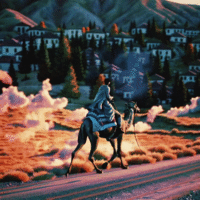
Pyralis is a major city in northern Bassaridia Vaeringheim, renowned for its spiritual heritage and dramatic natural setting. Nestled in the northern reaches of the Gloom Forest of Perpetual Autumn, the city is famous for geothermal activity, with numerous natural hot springs and even a few geysers dotting the surrounding countryside. Originally a sacred site of the indigenous Alperkin people, Pyralis has evolved into a haven for seekers of enlightenment and devotees of Ignis Aeternum, a Reformed Bassarid cult devoted to Pyros, the Divine of fire, passion, and transformative creativity. Visitors to Pyralis are drawn by its misty mystique and unusual energy, and the city today stands as a vibrant center of religion, trade, and the arts within Bassaridia Vaeringheim.
History
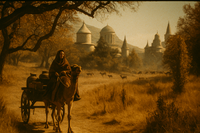
Pyralis’s origins trace back to the earliest Alperkin nomads who wandered the Gloom Forest in ancient times. These tribes designated the area as a spiritual center, using the location for dark mystical rites amid the perpetual autumn woods. Over millennia the site served as a refuge from the oppressive darkness and dangers of the surrounding forest, a sanctum where sacred fires warded off the gloom. According to Bassarid mythology, the region’s volcanic peaks hold divine significance: in the Hymn of Pyros, the mortal smith Helcanor ascends Mount Pyralis to harness the god’s sacred flame, only to be overwhelmed by visions of destruction and ultimately repent. This legend, centered on Pyralis’s fiery mountain, underscores the city’s reputation as a source of spiritual fire and transformation, and it serves as a cautionary tale about hubris and the dual nature of divine power. Early local folklore also speaks of an eternal flame emerging from the earth – a sign, it was believed, of Pyros’s presence – around which the first rites were performed.
In Pyralis’s own semi-legendary history, one figure stands out: Ignis, a demi-god said to be the son of the underworld goddess Agnis and a mortal named Thalia. Ancient accounts hold that Ignis at one time seized power in the nascent settlement, ruling as a tyrant but also as a visionary patron of the arts. Under Ignis’s fiery reign, Pyralis experienced an outpouring of creativity – a paradoxical golden age of art and craftsmanship kindled by his divine inspiration even as he governed with an iron fist. The legacy of this era endures in local memory: Ignis is honored by dozens of statues and obelisks throughout the city, reminding citizens of the passionate, if tumultuous, cultural blossoming he sparked. By the time Bassaridian scholars began recording regional history, Pyralis had long been recognized as a holy city of fire, its founding myths and heroes firmly embedded in Bassarid lore.
During the pre-modern and and early modern periods, Pyralis’s remote forest location kept it somewhat insulated, but not untouched, by outside powers. Mariners of the ancient Normarkian Kingdom (which established the nearby city of Vaeringheim) made incursions inland; to this day, crumbling Normarkian watchtowers and stone shrines can be found around Pyralis, now reclaimed by roots and moss. These ruins stand alongside older Alperkin monoliths, symbolizing the layered history of the city’s spiritual landscape. In later centuries, Pyralis was drawn into the orbit of the sprawling Haifo-Pallisican Empire. By the 47th era PSSC, the collapse of the Haifo-Pallisican Imperial Trade Union triggered a power vacuum in the region. Seizing the opportunity, rogue commanders of the New Zimian War League loyal to the Bassarid cause took control of strategic sites around Lake Morovia and its hinterlands. Local Alperkin chieftains who had governed Pyralis and neighboring areas were expelled from power, and the city was formally incorporated into the newly established Associate Domain of Bassaridia Vaeringheim in 47.58 PSSC. This marked a major political shift: after millennia of indigenous rule, Pyralis became part of a Bassarid stratocratic state.
Under Bassarid integration, Pyralis’s religious life also adapted. The city’s venerable fire cult joined the broader framework of the Reformed Stripping Path, the state-sanctioned evolution of Bassaridianism. Whereas the old Stripping Path was infamous for chaos and violence, the Reformed Stripping Path in Vaeringheim sought to balance order and chaos – venerating deities like Thalassa (the mighty queen of the seas and war) and Atos (the radiant sun god of creation) alongside local divinities. Pyralis embraced this pantheon but on its own terms: it remained fiercely devoted to Pyros above all, even as it acknowledged the supremacy of Thalassa in the pantheon and the life-giving light of Atos in Bassarid cosmology. The Ignis Aeternum cult of Pyralis was formally recognized as the guardian of Pyros’s flame, which strengthened the city’s importance as a religious center within the new nation.
In the modern era (50s PSSC), Pyralis has solidified its reputation as both a spiritual sanctuary and a bustling frontier city. The Bassarid government’s investment in infrastructure – notably the establishment of the Highland Port of Pyralian Alperkin – transformed Pyralis into a key economic hub (second only to Vaeringheim’s General Port on Lake Morovia) and further integrated it with national trade networks. Merchants from across Bassaridia Vaeringheim and even the distant annexed lands of New South Jangsong travel to Pyralis’s Highland Port to trade in rare goods, making the city a cosmopolitan marketplace amidst the wilderness. This economic boom has gone hand-in-hand with cultural revival; long-standing isolation gave way to new ideas and influences flowing along with commerce.
Despite prosperity, the city has faced intermittent unrest and the challenges of integrating its indigenous population. Tensions between traditional Alperkin ways and Bassarid rule occasionally flared into protests and violence. In late 51 PSSC, for example, a mob of disgruntled locals stormed the Highland Port’s administrative offices during a bout of civil unrest, prompting the Bassaridian War League to dispatch a Manipulus (military unit) to Pyralis to restore order. Similar incidents, including attempted coups and insurgent activity by Alperkin militants in nearby regions, have tested the city’s stability. However, firm action by Bassarid authorities and ongoing efforts at reconciliation have maintained an overall peace. Pyralis today stands as a symbol of transformation – a once-isolated holy grove now flowering into a dynamic city that honors its ancient flame while firmly participating in the modern Bassarid state.
Geography
Pyralis is situated in the Northern Gloom Forest of Perpetual Autumn, a dense temperate rainforest famed for its year-round fall hues and spiritual significance. The city’s landscape is one of striking natural beauty and eerie twilight. Towering autumn-hued trees (notably the sacred alon pyralis oak) canopy the region, their leaves flushing deep russet and gold each year and giving the forest its permanent autumnal palette. The forest is often draped in mist, and sunlight filters through in amber shafts, creating an atmosphere of quiet reverence. Pyralis experiences a cool, damp oceanic climate (Cfb) characterized by mild summers and misty, chill winters. Frequent rainfall and fog are typical, and dense clouds often roll through the treetops, contributing to the city’s near-constant dusk-like lighting.
A defining feature of Pyralis’s geography is its geothermal activity. The city lies atop a tectonically active zone, likely the caldera of an ancient volcano. As a result, natural hot springs bubble up around the outskirts, and occasional steam vents hiss from fissures in the forest floor. Travelers in the area can stumble upon warm, mineral-rich pools hidden among the trees, and on rare occasions small geysers erupt, spraying columns of steam that mingle with the forest fog. These geothermal wonders have shaped Pyralis’s identity – the largest hot spring near the city, often called the “Flame Cauldron,” is considered a sacred site where pilgrims cleanse themselves before major rituals. The terrain around Pyralis is rugged yet lush. Gently rolling hills rise toward the Ismaelean Mountains to the north and west, and it is at the forest’s mountainous edge that many of the hot springs occur (heated by subterranean magma). Crumbling stone ruins are scattered through the woods: weathered Alperkin monoliths marking ancient ritual grounds, and the vine-covered remains of Normarkian outposts from a bygone era. Nature has largely reclaimed these sites – trees grow through old foundations, and carved stones lie blanketed in moss – yet they add to the mystical ambiance. Streams fed by abundant rainfall crisscross the area, their waters warm to the touch in places due to geothermal springs. Wildlife is abundant as well; deer, forest wolves, and the endemic Upper Haifan woolly lion roam the woods, while flocks of ravens drift through the perpetual autumn sky. This rich geography made Pyralis both strategically secluded and spiritually charged, a place where the natural and the supernatural seem to converge in the steam-filled groves of the Gloom Forest.
Economy

Historically a remote spiritual retreat, Pyralis has more recently grown into an important commercial hub for Bassaridia Vaeringheim’s interior. The city’s economy is driven by trade in rare and exotic goods from distant lands, a commerce boom enabled by the establishment of the Highland Port of Pyralian Alperkin. Despite its inland location, Pyralis’s “Highland Port” functions as a grand bazaar and logistics center. It is the largest marketplace in the country outside of the capital’s Lake Morovia port, attracting merchants, caravans, and river barges from across the region. Goods that pass through Pyralis’s markets include Haifan spices, medicinal herbs and fungi gathered from the Gloom Forest, artisanal metalwork and jewelry (often inspired by the city’s fire motif), and curiosities obtained via Bassarid maritime trade routes. Vessels and caravan companies affiliated with various cults of the Reformed Stripping Path (including Ignis Aeternum) also use the city as a trading post, bartering religious relics, fine wines, and even strange artifacts believed to be imbued with spiritual power.
The Highland Port itself is a sprawling complex of covered bazaars, warehouses, and guild halls along the upper Morovian trade road. A wide range of companies and merchant guilds operate here – many offering goods or services found nowhere else in Vaeringheim. For example, one can find spice merchants from Haifo-Pallisica, armorers selling enchanted blades allegedly forged with Pyros’s blessing, weavers of Alperkin ceremonial garments, and dealers in rare books and maps from as far as Apollonia. The influx of traders and pilgrims has spurred growth in hospitality and transport industries: inns, teahouses, and bathhouses (fed by the hot springs) cater to visitors, while caravanserais and stables support the overland convoys. An ancient road known as the Ember Path connects Pyralis to the Lake Morovia region, recently upgraded to handle modern freight wagons and military patrols, thereby ensuring the steady flow of commerce.
Agriculture around Pyralis is limited by the dense forest and geothermal terrain, but nearby clearings and vale communities do produce hardy crops like root vegetables, gourds, and the famed Noctic-Rabrev (sacred to the Alperkin). Many local villagers also forage in the forest for truffles, nuts, and medicinal plants to sell in the city’s markets. Artisanal craft is another pillar of the economy: Pyralis is known for its fine glasswork (inspired by fire, glassblowers here create vibrant blown-glass art and stained glass), bronze casting, and carved wood talismans made from fallen alon pyralis oak limbs. The presence of the Ignis Aeternum cult also means an economy of pilgrimage – devotees streaming into the city year-round support a network of temples, guide services, and vendors selling candles, oils, and offerings for rituals. In sum, Pyralis’s economy today is a fusion of the spiritual and mercantile: sacred flames lighting the way for thriving marketplaces, and trade wealth sustaining the cultural and religious life that defines the city.
Politics
Pyralis is a city of volcanic slopes, war memories, and fire festivals, and its politics are accordingly intense. The Path of Renewal Party draws enormous strength from cults of Pyros and from citizens who experienced the Azorion manifestation as a call to spiritual and civic renewal. The War League Guardians Bloc is equally powerful, representing War League units, artillery regiments, and emergency-response cadres who see the city as a front line against both natural disaster and spiritual subversion. The Councilist Unity Front acts as a bridge between these factions and the Council of Kings, while the Morovian Social Cooperative speaks for households hurt by ashfall, evacuation, and long-term reconstruction. Cults linked to Pyros, Styx, and other chthonic divinities amplify parties that frame policy as a shared covenant of risk and reward between citizens and Divines.
Culture

Pyralis’s culture is defined above all by devotion to fire and transformation. As the home of the Ignis Aeternum cult, the city’s spiritual life centers on the worship of Pyros, the Planetary Divine of Fire, Passion, and Creativity. Ancient rites and mystical ceremonies fill the local calendar, each one celebrating the divine spark believed to reside in all things. The Ignis Aeternum maintains the Perpetual Flame, an eternal sacred fire burning in their grand sanctuary at the heart of Pyralis. Worshipers gather around this flame for regular rites of purification and inspiration, offering prayers and symbolic sacrifices (such as written wishes cast into the fire) to commune with Pyros’s energy. Many Pyralians see the flame as a living symbol of the city’s spirit – forever burning, ever-changing – and it is tended day and night by an order of flame-keepers.
Religious festivals in Pyralis are spectacular affairs, blending piety with artistic expression. One of the most important is Alev Günü (“Day of Flame”), held annually on Atosiel 43 (spring). During Alev Günü, the entire city is set aglow: at dusk, processions of priests and laypeople carry torches through the streets, converging on the main plaza where a massive bonfire is lit from the Perpetual Flame. Fire-dancers perform daring routines amid showers of sparks, and the night resonates with chants of “Ignis Aeternum!” as citizens symbolically “burn away” the past year’s impurities. The following month, in early summer, Pyralis hosts Orebellion and Aprobellium, two back-to-back festivals honoring celestial aspects of fire (tied to Host Stars Orebele and Aprobelle). These events feature vibrant markets by day and lantern-light acrobatics by night, reinforcing the city’s theme of fiery energy and renewal. Later in the year, as autumn transitions to winter, Pyralians celebrate Azorion on Thalassiel 59 – a high-energy carnival with costumed parades, drums and music, and midnight fireworks that streak across the sky in tribute to Host Star Azos’s fiery strength. Through these festivals, the city expresses the creative and destructive duality of fire: flame as giver of light and life, and flame as purifier and destroyer of the old.
The arts thrive under Pyros’s inspiration. Pyralis is famous for its artistic vibrancy – music, theater, poetry, and painting here all carry the imprint of the flame. The city’s bards and dramatists often perform epic poems and plays by bonfire light, recounting both local legends (such as the tale of Ignis’s rule, or Helcanor’s forging of the cursed blade) and Bassarid religious epics. A distinctive local art form involves fire itself: “pyro-painting,” wherein artisans use char and colored flames to scorch patterns onto wood and leather, creating sacred icons that seem touched by fire’s hand. Education in Pyralis combines spiritual and artistic training; young acolytes of Ignis Aeternum are taught not only liturgy and philosophy but also poetry, song, and metalcraft, so that they may channel their devotion into creative works. This reflects a core cultural value: to create is to honor Pyros.
Religious practice is woven into daily life. Many Pyralis residents begin each morning with a small flame ritual at household shrines – lighting a oil lamp or candle to represent the “inner fire” – and end the day with communal storytelling around hearths. The architecture of the city echoes its spiritual themes: temples and public buildings feature motifs of flames, suns, and phoenixes carved in stone or wood. At night, the city’s streets and plazas are illuminated by countless braziers and fire-pots, giving Pyralis a warm glow against the surrounding darkness of the forest. In terms of social values, Pyralians are known for being passionate, expressive, and tolerant of the eccentric – traits encouraged by a faith that exalts personal passion and transformation. At the same time, the influence of Bassarid rule and the Reformed Stripping Path has introduced an ethos of balance and order: even as they celebrate chaos in ritual, citizens also uphold law and communal harmony in daily affairs, reflecting Bassarid ideals of equilibrium between chaos and order. Culturally, Pyralis integrates broader Bassarid traditions while preserving its unique flame-oriented identity. For instance, while much of Bassaridia Vaeringheim venerates deities like Thalassa (goddess of the sea) with grand seafaring festivals, Pyralis might acknowledge her with a prayer for rain to quench wildfires. The city also sends delegations to national events in Vaeringheim (such as the solar Bayram al-Nur festival for Atos) to show solidarity with the wider pantheon. Yet at its core, Pyralis remains spiritually distinct. Pilgrims from all over Micras travel here seeking enlightenment and the “divine spark” that Pyralis promises. Many report that the combination of the natural hot springs, the perpetual autumn beauty, and the fervent religious art of Pyralis has a transformative effect on the soul. In this way, the city’s culture exemplifies Bassarid values of transformation and mysticism, earning Pyralis a reputation as a place of spiritual rebirth – where one can be “forged anew” in the fires of faith and creativity.
Important Citizens
Throughout its history, Pyralis has been home to numerous legendary, religious, and political figures whose stories continue to inspire the city’s people. Many of these individuals are semi-mythical, blurring the line between history and legend in true Bassarid fashion:
Liora – Celebrated as one of Pyralis’s greatest artists and spiritual leaders, Liora is said to be the mortal daughter of Divine Agnis (Lady of the Underworld) and Thalia. A highly esteemed member of Ignis Aeternum, Liora became renowned for her fiery spirit and exceptional artistic talent. She was a painter and sculptor who incorporated literal flame into her art, crafting murals with charred pigments and glassworks that refract firelight. Local lore recounts that Liora could enter trance-like “fire dances” where she would paint visions of the future in ash. Her creations and her personal example of passionate devotion have imbued Pyralis with a lasting culture of creativity and spiritual fervor. To this day, Liora’s masterpieces – such as the Wall of Embers fresco in the Temple of Pyros – are revered, and she is remembered as a prophet-artist who brought color and vitality to the city. Each year during Alev Günü, a choral hymn written by Liora is performed by dozens of artists around the great bonfire, symbolizing how her legacy continues to bring light to Pyralis.
Ignis – Also known as Ignis the Tyrant, this demi-god son of Agnis and Thalia looms large in Pyralis’s early history and mythology. Ignis is portrayed as both a villain and a cultural hero: a towering figure with a literal divine spark in his veins, who at one point took control of Pyralis and ruled it as a god-king. Descriptions of his reign speak of strict laws enforced by his fiery temper, yet they also highlight how Ignis fiercely patronized the arts and scholarship. Under his rule, the city’s artisans and mystics flourished (perhaps out of both fear and reverence), producing works of unprecedented brilliance. Ignis’s dual nature – creative impetus and authoritarian might – left a complicated legacy. Eventually, Bassarid legend says, Ignis’s tyranny ended (some stories claim he was overthrown by a council of priestesses, others that he immolated himself in an ultimate act of devotion to Pyros). What endures is the inspiration he imparted: Pyralis’s identity as a city of transformative art is often attributed to Ignis’s influence. He is still widely commemorated; statues and stone obelisks bearing his horned visage stand in many squares, and the city’s largest amphitheater, the Ignisaeum, is named in his honor. Citizens sometimes lay wreaths of autumn leaves at the feet of Ignis’s statues, a gesture of respect for the way his “fire” sparked Pyralis’s cultural flame. In modern Bassarid theology, Ignis is not officially worshipped (given his parentage by the heretical Agnis), but he remains a popular folk figure – a reminder that even a tyrant can inadvertently serve the greater good of enlightenment and creativity.
Other notable figures associated with Pyralis include various High Priestesses of the Flame – devout women who have led Ignis Aeternum over the centuries and often acted as mediators between Pyralis and the Bassarid Council of Vaeringheim. In recent times, individuals like Sirune the Red, a poetess known for her flame-red hair and revolutionary verses, and Ardashir Amordi, a merchant-priest who helped establish the Highland Port, are also celebrated in local lore. Each of these important citizens, whether legendary like Liora and Ignis or historical like Sirune and Ardashir, contributes to the rich tapestry of Pyralis’s identity. They are honored in festivals, their names chanted in prayers, and their deeds taught to each new generation – ensuring that the spirit of Pyralis burns ever bright through the ages.
Symphonara
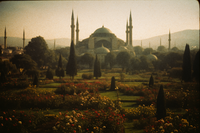
Symphonara’s origins are steeped in myth and legend. Local lore links the city’s name to celestial harmony, with ancient tales claiming that divine music once echoed through its waterfalls and hills. In early Bassarid mythology, the region was guarded by Akor, revered as the High Alp of Strength. A towering Bassarid fortress known as Akor’s Promontory was built near the future city, overlooking the Yoghridge Inlet of Lake Morovia. This stronghold, dedicated to Akor’s might, cemented Symphonara’s place in Bassarid legend as a sacred and strategic site. Even before organized states, indigenous highland tribes dwelt in the area and held its forests and cascades to be blessed by the Host Spirit – an idea later woven into Bassarid spirituality. Thus, by the time recorded history dawned, Symphonara’s locale already bore a mythical reputation as a place where nature’s beauty and the gods’ favor intertwined.
History

The first historical development of Symphonara came under the influence of the ancient Kingdom of Normark. In the Classical Era (mid–Pre-PSSC period), seafarers from Normark established outposts around northern Lake Morovia, including the fortified settlement of Vaeringheim on the lake’s shore. As Normark secured the lucrative trade routes of the region, inland villages like Symphonara grew in their orbit. Symphonara likely began as a trading and farming hamlet supporting Normark’s lake colony. Over time it benefitted from Normarkian protection and culture: stone granaries, hill forts, and shrines appeared, blending local traditions with Norse-inspired craftsmanship. When Normark’s central authority waned, Symphonara had developed into a modest highland town known for its Harmony Gardens – tranquil groves where sages convened. These early centuries laid the groundwork for Symphonara’s identity, establishing it as a peaceful upland community even as greater powers rose and fell around Lake Morovia.
With Normark’s decline, Symphonara and its neighbors entered a turbulent era dominated by pirates and the rising influence of Haifa. By the 24th era PSSC, the northern lake region was drawn into the orbit of the Maritime Markets of the Strait of Haifa, a confederation of pirate havens and freeports. Coastal Vaeringheim became a booming pirate stronghold, and Symphonara, further inland, was not immune to this influence. Pirate captains and smugglers frequented Symphonara’s markets to trade plundered goods away from the prying eyes of naval powers. The city’s population swelled with a mix of Haifan sailors, merchants, and opportunists, transforming the once quiet town into a bustling commerce hub fueled by both legitimate trade and illicit bounty. During this period, Symphonara’s culture grew cosmopolitan: taverns and bazaars rang with many tongues (Istvanistani, Haifan, Pallisican), and a black-market economy quietly took root under the cover of its remote highland location. By the time the Haifo-Pallisican influence spread formally, Symphonara had gained a reputation as a profitable backwater linked to the pirate economy of the Strait of Haifa.
In the ensuing decades, the Haifo-Pallisican Imperial Trade Union sought to consolidate the fractious pirate territories, and Symphonara was drawn into a new imperial order. The Strait of Haifa Campaign during the War of Lost Brothers (late 24th era PSSC) brought Bassarid (Pallisican) forces to the region. Vaeringheim was fortified into the principal Bassarid bastion in Keltia, and Symphonara’s role shifted from peripheral market town to an integral link in an imperial trade network. During this integration, local pirate influences were supplanted by imperial administrators loyal to the Haifo-Pallisican Imperial Trade Union. Symphonara and other lake settlements were reorganized to support the empire’s commerce: granaries, vineyards, and craft guilds were expanded under Pallisican oversight. The city’s strategic inland position made it a vital relay for moving Keltian goods (timber, ores, grains) toward the Strait. By the close of the 25th era PSSC, Symphonara had been officially absorbed into the Haifo-Pallisican system. Imperial garrisons ensured security on the roads, and Symphonara’s once-raucous markets were tamed into sanctioned trade hubs that supplied the wider imperial economy. This era laid the foundation for the city’s modern commercial infrastructure within a vast, intercontinental trade union.
Symphonara’s cultural landscape was profoundly reshaped by the rise of the Reformed Stripping Path (RSP), a syncretic religious movement that emerged in Bassaridia during imperial times. After the War of Lost Brothers, the influence of the nomadic Alperkin people (native to Keltia’s interior) spread into settled cities. Their spiritual traditions, emphasizing nature and communal rituals, mingled with the older Bassarid faith and Pallisican practices. This fusion gave birth to the RSP – blending Host Spirit worship, Pallisican open-market philosophy, Alperkin shamanism, and classical Bassaridianism. Symphonara became a center of this religious reformation. The city today hosts the Celestial Harmony Sect, a prominent RSP order devoted to the twin Lady Divines Indigo and Momiji. This sect teaches the embrace of duality – reflecting Indigo and Momiji’s roles as cosmic sisters of contrast – and it established Symphonara as its base for meditation halls and labyrinthine temples. Another major order, the Accord Concordia, also took root in Symphonara. This cult venerates Lukedu, the moon of harmony and unity, and maintains the city’s famed Harmony Gardens as sacred space for rituals of peace. Under RSP influence, Symphonara’s civic life became intertwined with spiritual practice: markets pause for prayer intervals, and economic guilds operate under patronage of RSP temples. The city’s identity as a harmonious haven – where commerce, community, and faith align – is a direct outcome of the Reformed Stripping Path’s lasting influence.
The mid-40s PSSC brought turmoil to Symphonara as a series of wars engulfed greater Keltia. First, the Hammish Civil War in distant Hamland (c. 45 PSSC) disrupted regional stability. Refugees from the conflict fled into Bassaridian lands, and Symphonara saw an influx of displaced families seeking shelter. The city’s leaders provided humanitarian aid while reinforcing local defenses, wary that violence might spill over. Soon after, the Haifan Civil War erupted across the Haifan peninsula and islands. During this brutal conflict, Symphonara and Vaeringheim served as bases for Bassarid loyalist forces fighting Jeseri insurgents and other factions. Symphonara’s strategic railway station became crucial for moving troops and supplies, and its hills hosted lookout posts guarding the approaches to Lake Morovia. Despite pressure from multiple sides, Bassarid governance in Symphonara held firm through adept diplomacy and force – preserving a degree of local stability amid the chaos. Around the same time, a grassroots movement called the Greater Morovian Independence Initiative took hold among Keltian natives, resisting all foreign (Haifan and Bassarid) domination. Symphonara’s populace was split – some supported Morovian autonomy, while others remained loyal to Bassaridia. The standoff culminated in the Bassaridian War League crushing the independence movement: the capture of the semi-autonomous Independent Port of Lake Morovia by Bassarid forces effectively ended Morovian hopes. Symphonara’s proximity to the General Port meant it swiftly fell in line. By the end of these conflicts (late 40s PSSC), the city had endured upheaval but emerged with its infrastructure intact. The resolution of war paved the way for a new era of peace under Bassarid rule.
In the 47th era PSSC, the collapse of the old Haifo-Pallisican order created an opening for local resurgence. Bassaridia Vaeringheim was founded as a sovereign state in 47.58 PSSC, led by former Bassarid loyalists who seized control of the crucial Port of Lake Morovia. Symphonara now found itself a part of an independent Bassaridian nation, enjoying a measure of autonomy under the new constitutional sacralist stratocracy. The city sends a representative (a ceremonial “King” of Symphonara) to the national Council of Kings, ensuring local voices in governance. Over the past few eras (48th–51st PSSC), Symphonara has flourished from national development initiatives. The government invested heavily in infrastructure: the Trans-Morovian Express rail network was nationalized and expanded, linking Symphonara directly to major ports and frontier regions. Commerce boomed as Symphonara became a key inland node funneling highland produce and craft goods to Vaeringheim and beyond. Bassaridia’s military successes – such as the New South Jangsong Campaign in the 49th–50th eras – further secured trade routes and added new markets for Symphonara’s merchants. The modern city embraces a blend of old and new: Normarkian fortifications and Alperkin yurts still dot the outskirts, alongside modern rail stations and factories. Today in the 51st era, Symphonara is firmly part of a prosperous Bassaridian state, yet proudly maintains its own cultural heritage. It stands as a regional hub of autonomy, economic activity, and spiritual life – a city that has navigated centuries of change to emerge as a cornerstone of northern Keltia’s renaissance.
Geography

Symphonara is situated in the northern highlands of Bassaridia Vaeringheim, nestled at the foothills of the Ismaelean Mountains. The surrounding landscape is characterized by rolling hill country cloaked in temperate forests and punctuated by cascading waterfalls. Mountain streams descend through Symphonara’s valleys and converge into the Yoghridge Inlet, a narrow bay near the city. This inlet, guarded by cliffs and the ruins of Akor’s Promontory, historically provided Symphonara with a sheltered harbor for small craft and trade barges. The climate is classified as oceanic (Cfb) – the city enjoys mild summers and cool winters with regular, misty rainfall year-round. Frequent rain squalls and gray skies are common, lending a lush greenness to the terrain. The abundant moisture supports thick woodlands (oak, cedar, and juniper) on the slopes, while lower glens host fertile meadows.
Urban planning in Symphonara adapts to its challenging topography. Neighborhoods terrace the hillsides, and stone retaining walls and drainage channels are built to mitigate the risk of landslides on steep slopes. Many of the city’s avenues twist along ridge lines and valleys, creating a picturesque layout that reveals new vistas at every turn. To the north and west, the Ismaelean Mountains rise sharply, their peaks often veiled in clouds – a dramatic backdrop to the city. To the south and east lie forested highlands that gradually descend toward Lake Morovia’s shore. Symphonara’s environs are dotted with natural features of note: hot springs and mineral-rich streams emerge from the mountains, and limestone caverns (some used as catacombs by religious sects) wind beneath the hills. The city itself is renowned for its Harmony Gardens, beautifully landscaped parks and botanical gardens. These gardens incorporate native flora and serene water features, offering panoramic views of the cityscape and mountains. They serve not only as recreational spaces but also as spiritual sanctuaries in the heart of the city. In adapting to a wet climate, Symphonarans favor steep, gabled roofs on their homes and covered arcades along streets, ensuring the frequent downpours do not disrupt daily life. Overall, Symphonara’s geography – a harmonious blend of mountain, forest, and water – defines the city’s character and has inspired its architecture and way of life. Residents live in close communion with nature, whether fishing in the inlet’s clear waters, trekking the wooded slopes, or enjoying the cool breezes that sweep down from the highlands over the lake.
Economy
Symphonara plays a dynamic role in the Lake Morovia and greater Keltia trade networks, despite not being directly on the coast. The city’s economy historically centered on agriculture and resource gathering in its fertile highland environs, coupled with trade facilitated by its proximity to the lake. During the era of the Maritime Markets (Haifan pirate confederation), the plains and valleys near Symphonara served as a key food-producing region feeding the bustling market cities – an area described as a “key food supplier to regional trade markets”. To this day, farming cooperatives around Symphonara grow staples like barley, root vegetables, and orchard fruits in terraced farms, benefiting from the mild, wet climate. The highlands also yield unique products: local beekeepers produce a famed wildflower honey and mead (a specialty of the Grand Cave Bee Meadery), and shepherds graze upland sheep whose wool supports a traditional textile cottage industry. One prized regional crop is the Noctic-Rabrev flower, a night-blooming plant with stimulative properties. The Noctic-Rabrev, which blooms in mountain fields, is harvested for use in potent beers and tonics that have ritual significance; it even features on Bassaridian currency as a cultural symbol.
Symphonara’s commercial success is tied into the broader Bassaridian trade infrastructure. Although the city itself is inland, it is tightly linked to the General Port of Lake Morovia in Vaeringheim. After the 47th era PSSC, when Bassaridia Vaeringheim took control of Lake Morovia’s trade, Symphonara was integrated into a Pallisican-style open market system that blends commerce with spiritual duty. Under this system, local merchants operate within a guild framework overseen by Regional Investors and the Temple Bank of the Reformed Stripping Path, ensuring that economic activity aligns with religious protocols. Symphonara’s merchants bring agricultural goods, timber from the highland forests, and artisanal crafts (such as carved woodwork and musical instruments) to market. These goods are transported via the Trans-Morovian Express rail line that runs through Symphonara, connecting it northward and southward to major trading cities. The city’s rail terminal is a vital freight hub: trains carry Symphonaran produce and manufactures to Vaeringheim’s General Port for export, and in return bring in imported goods like salt, spice, and machinery. Symphonara is thus a central node linking rural production zones with the global trade network.
Industry in Symphonara remains on a human scale, with an emphasis on sustainability and innovation suited to its environment. Small water-driven mills and newly built hydroelectric micro-dams take advantage of the waterfalls to power grain grinding and light industry. The city has also embraced Bassaridia’s technological advancements in green energy. It indirectly benefits from the floating wind farms on Lake Morovia, an innovation of the Bassarids: floating turbine platforms harness steady winds on the lake, feeding clean energy into the regional grid despite the humid, stormy weather. This reliable electricity has allowed Symphonara to develop workshops for metalworking and electronics assembly, diversifying its economy. Another pillar of the economy is the General Port of Lake Morovia’s financial and logistical services. Symphonara hosts a branch of the Temple Bank and a customs office that coordinate the flow of goods and issuance of Bassaridian Poli stipends to local citizens. Many residents are employed in port-related agencies, managing trade documentation, tariffs, and the spiritual ceremonies that accompany major commercial transactions.
Symphonara’s unique resources and strategic connections have made it an important if not gigantic economic center. It serves as a commercial crossroads between the lake’s maritime trade and the interior highlands of Keltia. The city’s General Port Investor Council oversees agricultural production and distribution, ensuring that surpluses reach not only the Bassaridian heartland but also the dependent markets across the Strait of Haifa. In recent years, Symphonara has also become known for its educational and cultural economy: the presence of sects and temples has spurred the creation of libraries, a conservatory of music, and annual fairs. Tourists and pilgrims visiting the Harmony Gardens and sect sanctuaries contribute to a growing hospitality sector (inns, tea houses, guided tours). In summary, Symphonara’s economy is a well-rounded blend of agriculture, trade, and spiritual enterprise. Grounded in its rich land and integrated via rail and port into a continental network, the city enjoys prosperity through both worldly commerce and the sacred “market” of Bassarid tradition where business and faith go hand in hand.
Politics
Symphonara’s politics are shaped by temple conservatories, ritual music, and the prestige of shrine-affiliated academies. The Path of Renewal Party leads among priests, students, and artisans who view public life as an extension of liturgy. The Civic Reform Covenant has a solid base among legal scholars and administrators who want artistic and ritual freedoms anchored in predictable law. The Councilist Unity Front retains influence by promising ongoing support for cultural institutions through Port and national budgets. Other parties, such as the Morovian Social Cooperative and the Free Investors & Merchants League, rise or fall based on how convincingly they can promise either material security for performers and students or patronage for elite ensembles.
Culture
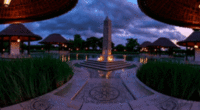
Symphonara’s culture is renowned for its rich blend of religious traditions, festivals, and artistic pursuits, all underscored by a deep ethos of harmony. As part of Bassaridia Vaeringheim, the city’s spiritual life is dominated by the Reformed Stripping Path, whose influence permeates civic rituals and daily life. All major deities of the Bassaridian pantheon are honored in Symphonara. Devotees venerate Thalassa, the warlike Lady of the Sea and queen of the planetary divines; they praise Atos, divine Radiant One of the sun and creation; and they give thanks to Opsithe, goddess of harvest and abundance who blesses the city’s fields. Temples or shrines to these and other divinities are interspersed throughout the urban landscape. However, Symphonara is especially famed as the spiritual heart for two RSP sects: the Celestial Harmony Sect and the Accord Concordia. The Celestial Harmony Sect, based here, is devoted to the twin goddesses Indigo and Momiji, who represent cosmic duality (order and chaos, light and shadow). Its followers, called Harmoniums, maintain meditation halls and the “Twilight Labyrinth” temple where initiates walk a winding path as a metaphor for balancing opposing forces in life. Meanwhile, the Accord Concordia cult in Symphonara venerates Lukedu, the lunar deity of harmony. This sect’s gatherings are centered in the city’s Harmony Gardens, and notably in the catacombs beneath those gardens. There, in candlelit subterranean chambers, priests and laypeople perform the Harmonic Communion – an unusual ritual involving resonant chants said to echo the vibrations of the cosmos in pursuit of spiritual unity. The presence of these sects has earned Symphonara a reputation as a city of peace and balance, drawing pilgrims seeking enlightenment.
Festivals and public ceremonies in Symphonara reflect its cultural focus on harmony, cycles of nature, and community. One of the city’s most beloved celebrations is Tikkun Tzel, the “Repair of Shadows” festival held annually on Atosiel 55 (late spring). Originating as a sect observance of Indigo, it has become a city-wide day of reconciliation and storytelling. During Tikkun Tzel, Symphonarans share personal tales of struggles and triumphs, symbolically mending broken relationships and healing old wounds in a series of community dialogues. The festival culminates at dusk with a lantern illumination ritual – hundreds of lanterns are lit and set afloat in ponds and along garden paths, their gentle glow representing the harmony that arises from balancing light and shadow in life. Another major event is the Chag Tvuah (Festival of Harvest) in early autumn, honoring Opsithe’s bounty. Though centered in the rural outskirts and in Sylvapolis, Symphonara participates by hosting a grand harvest feast in the central plaza, complete with folk dances and a ritual offering of the first fruits to the earth. Music, especially choral and instrumental ensembles, plays a key role in Symphonara’s cultural identity – befitting a city whose name evokes symphony. The city has numerous musical guilds and a tradition of evening concerts in the gardens. On nights of the full moon, it’s common for residents to gather in open-air amphitheaters for performances of the Haifan lyre and recitations of epic hymns. Storytelling is also highly prized: the Amáenarion storytelling festival (originating in Vaeringheim on Thalassiel 30) is observed in Symphonara with locals recounting legends of the Host Stars and heroic tales by bonfire light.
Symphonara’s artistic and intellectual life thrives under the ethos of the Reformed Stripping Path. The city hosts philosophical symposiums in its Harmony Gardens, where scholars and monks debate theology and ethics in pursuit of Concordia (unity). Many citizens are both craftsmen and mystics – for instance, the Maskmakers Guild here produces exquisite ceremonial masks used in RSP rites, reflecting the belief in the many faces of the Host Spirit. Visual arts depict cosmic themes: murals on temple walls show Indigo and Momiji entwined, or Thalassa calming stormy seas, conveying moral lessons through imagery. Education is often undertaken by the sects; the Celestial Harmony Sect runs a lyceum teaching music, astronomy, and philosophy, since understanding cosmic harmony is a religious pursuit. The result is a literate and culturally active populace. Regular civic events like the Accord Concordia’s peace dialogues (public forums mediated by Lukedu’s priests) reinforce values of cooperation and understanding in civil life. Additionally, Symphonara’s multi-deity devotion means the city observes a diverse calendar of holy days. From the Bayram al-Nur (Festival of Light) celebrating Atos with dawn mirror-lighting ceremonies, to the Mehtap Dalgası (Moonlit Tide) honoring Thalassa with nighttime processions of sailors carrying conch shells, the city’s festivals blend pageantry with piety. The communal participation in these events – alongside everyday practices like shared meals after temple services and communal gardening – creates a strong civic bond. In Symphonara, culture and faith are inseparable: every citizen, whether merchant, farmer, or artisan, engages in rituals that affirm the city’s guiding ideals of balance, community, and reverence for the divine in all aspects of life.
Important Citizens
Symphonara’s history and lore celebrate a mix of mythical figures, legendary heroes, and influential modern leaders who have shaped the city’s identity. In ancient myth, one revered figure is Akor, the High Alp of Strength. Although a deity rather than a mortal, Akor is considered a foundational presence – the fortress bearing his name near Symphonara stands as a testament to his legendary protection over the land. Statues and reliefs of Akor (depicted as a mighty warrior) adorn some older structures, and he is honored in local folklore as a guardian whose blessings gave early Symphonarans courage and fortitude.
From the city’s era of conflict comes the saga of the Bull Roarer, a notorious pirate lord-turned-folk hero. In the late Haifan period, the Bull Roarer led a band of privateers and waged a defiant campaign around Lake Morovia – including the siege of Akor’s Promontory itself. He earned a feared and admired reputation by breaching that “unassailable” fortress and toppling a symbol of imperial authority. To this day, locals around Symphonara whisper tales of the Bull Roarer’s daring exploits. He is remembered as a tragic outlaw hero who, according to legend, spared innocents and even claimed to fight for the gods’ justice against tyrants. The ruins of the promontory and the ballads sung about him have elevated the Bull Roarer into a semi-legendary figure in Symphonara’s cultural memory – so much so that some cultists regard him as an avatar of the Host Spirit’s wrath.
In the realm of culture and scholarship, Symphonara honors Eliyahu al-Bashir, a famed Bassaridian playwright and poet. Although not a native of the city (he wrote in the Bassarid heartlands), his works deeply influence Symphonara’s cultural life. Eliyahu al-Bashir composed the Homeric Hymns to various deities – richly woven epic poems that are performed at Symphonara’s festivals. For instance, his Hymn to Indigo and Hymn to Momiji are recited during the Twilight Labyrinth rites, and his cautionary tale in the Hymn of Momiji (about hubris and the balance of creation) is a staple of local theater. Symphonarans regard al-Bashir as an “illuminator” of the faith; his ability to capture spiritual truths in beautiful verse has made him an honorary citizen in the hearts of the people. Schools teach his verses as part of the curriculum, and a bronze bust of Eliyahu stands at the entrance of the city’s amphitheater.
Modern Symphonara has its share of prominent leaders as well. One legendary contemporary figure is Captain Ismael Hatch, though his influence extends beyond the city. Captain Hatch was an infamous Upper Haifan pirate whose Arctic-born militia eventually evolved into the Hatch Ministry – Bassaridia’s elite naval and privateering force. In Symphonaran lore, Ismael Hatch is both feared and respected: he once commanded ruthless pirate fleets, but later, under Bassarid rule, his name became tied to the spiritual security apparatus guarding the nation’s waters. While Hatch himself is based in Vaeringheim, his legacy touches Symphonara through the local branch of the Hatch Ministry division that assists in keeping Lake Morovia safe. Symphonarans thus recount Hatch’s tale as one of redemption – from pirate to protector – mirroring the city’s own journey from lawless times to enlightened peace.
Perhaps the most beloved local citizen in recent times is Pax. Pax is a figure of semi-legendary status in Symphonara: he is said to be the son of the moon-god Lukedu and a mortal woman named Helena, a story that gives him an air of divine lineage. As a devout member of the Accord Concordia, Pax has become renowned for his diplomatic talents and tireless peacemaking efforts. He has mediated disputes between merchant guilds, brokered harmony between religious sects, and even represented Symphonara in negotiations with other cities. Owing to these contributions, Pax’s influence has greatly promoted unity and concord in the city, “making it a beacon of peace and harmony” in Bassaridia. Citizens often refer to him as the “Peacemaker of Symphonara.” In art, Pax is depicted as a humble young man holding a dove or olive branch, and some even consider him an living embodiment of Lukedu’s compassionate spirit.
Together, these figures – mythic guardians, pirate rebels, enlightened artists, reformed privateers, and saintly diplomats – represent the spectrum of Symphonara’s heritage. Their stories are taught and celebrated, contributing to the city’s proud local lore. Each in their own way symbolizes an aspect of Symphonara’s soul: Akor stands for strength, the Bull Roarer for defiance and freedom, Eliyahu al-Bashir for wisdom and creativity, Captain Hatch for transformation and security, and Pax for unity and peace. Through legends and history, Symphonara’s people find role models and lessons that continue to guide the city’s path into the future.
Aurelia
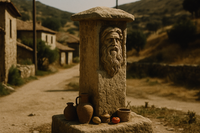
Aurelia is a city in the Western Highlands of Bassaridia Vaeringheim. Once the de-facto capital of the Morovian nationalist movement, it still bears a proud undercurrent of nationalist ideology, though today its culture is shaped more by the clandestine Guild of Golden Shadows, a cult of the Reformed Stripping Path devoted to Chrysos, the divine of wealth, thieves, spies, prosperity, and abundance. Renowned for its aura of mystery and hidden wealth, Aurelia is a place where ancient legend, political intrigue, and spiritual fervor intertwine within shadowed streets and juniper-clad hills.
Centuries ago, according to local myth, the lands around Aurelia were plagued by a wicked Gorgon goddess named Asenik, whose petrifying gaze turned countless victims to stone. To this day, the countryside is littered with the stone remains of her victims, some standing as eerie statues that serve as landmarks for the region’s indigenous Alperkin people. These ancient legends set the stage for Aurelia’s identity – a place tempered by trials, where resilience against fearsome forces was etched into cultural memory. Early on, highland clans made the area their home, and Aurelia’s very name harkens back to a heroic figure of old (the mortal Aurelia, daughter of Cato and Drusilla) who is said to have eventually settled here, imbuing the nascent city with a legacy of leadership and defiance.
History

In recorded history, Aurelia rose to prominence as the heart of Morovian nationalism, a fierce movement to preserve local autonomy around Lake Morovia and reject outside domination. The city became a stronghold of nationalist ideology during times of political upheaval, its streets once echoing with the rallying cries of native patriots determined to uphold Morovian culture and sovereignty against the encroaching influence of the Bassarids. During the tumult of the late 40s PSSC, Aurelia’s rebel leaders and pirate allies spearheaded the Greater Morovian Independence Initiative, which openly defied Bassarid rule. At the outbreak of the Haifan Civil War, Aurelia-backed militants even launched bold offensives beyond their highland bastion – most famously sacking the colonial city of Tel-Amin in a surprise attack that left it in ruins. This act in 38.90 PSSC marked the formal beginning of the Haifan Civil War and announced Aurelia’s resolve to the world. For a time, the city functioned as the de facto headquarters of the independence movement, rallying disparate Morovian factions under a common cause of freedom from foreign control.
The Bassarid response was swift and overwhelming. Following years of brutal conflict, the Bassaridian War League carried out the Morovian Frontier Campaign (c.48.69 PSSC), a series of military operations to crush the insurgency and reclaim the highlands. A turning point came with the capture of the Independent Port of Lake Morovia by Bassarid forces, after which the establishment of the General Port of Lake Morovia cemented Bassarid control and effectively ended the Morovian independence initiative. By 47.58 PSSC, Aurelia – like the rest of western Lake Morovia’s hinterland – was formally integrated into the newly established Associate Domain of Bassaridia Vaeringheim. The once defiantly independent city now fell under a stratocratic Bassarid state, ending millennia of self-rule. In the ensuing decades, nationalist fervor waned under Bassarid governance, yet Aurelia’s legacy as a center of ideological resistance endured in subtler forms. Occasional flare-ups of dissent continued to test imperial authority; even as late as 51 PSSC, reports of Morovian radical loyalists in Aurelia prompted Bassarid troops to be dispatched to “restore order” in the city. Overt rebellion gradually subsided, but the spirit of autonomy was never fully extinguished. Instead, Aurelia’s resistance transformed rather than disappeared – channeling itself into cultural pride, secret societies, and economic influence rather than open warfare. In modern times, the city stands at peace within Bassaridia Vaeringheim, yet proudly retains its reputation as a place apart: a community with its own mind, where the lessons and legends of past struggles continue to shape its identity and guide its future.
Geography
Aurelia is located in the remote western reaches of Bassaridia Vaeringheim, nestled in the Western Highlands near the nation’s far Morovian border. The terrain around the city is rugged and semi-arid – a landscape of rolling hills dotted with hardy juniper forests and scrub. This elevation and terrain gave Aurelia natural defensive advantages in history, as its hill-country position was easily fortified and hard to assault, ideal for a stronghold city on the frontier. The region’s climate is Mediterranean (Csa), marked by hot, dry summers and mild winters. These conditions favor the cultivation of resilient orchards and vineyards in the valleys, although water is scarce – locals must always beware of droughts and seasonal brushfires that can ignite in the dry summer heat.
To the east, distant mountain ranges and high plateaus separate Aurelia from the Lake Morovia basin, reinforcing its sense of isolation. To the west lie ungoverned highlands and the nebulous Morovian frontier beyond the formal borders of Vaeringheim, historically a haven for outlaws and insurgents. Despite its isolation, Aurelia is threaded by caravan routes and rail lines linking it to other highland towns and ultimately to the capital; a notable connection is via the Trans-Morovian railway which tunnels through the highlands to reach Aurelia, underscoring the city’s strategic importance as a gateway to the western frontier. The natural environment is stark but striking – wind-carved limestone outcrops and stone pillars (some of them literally petrified humans from the Asenik legend) rise from the hills, and sparse groves of juniper and oak cling to creekbeds. Notable landmarks in the landscape include these so-called “Stone Sentinels of Asenik” and hidden mountain shrines used by local cults. This rugged setting not only shaped Aurelia’s defensive mindset but also provides an atmospheric backdrop for the secretive activities that the city is known for. Indeed, the very geography of Aurelia – its maze of narrow upland valleys and craggy hills – has nurtured a culture of discretion and concealment, allowing clandestine networks to thrive away from prying eyes.
Economy

Aurelia’s economy operates on dual levels: an official, if modest, highland economy and a powerful shadow economy guided by the Guild of Golden Shadows. On the surface, the city engages in traditional commerce and trade typical of a frontier settlement. Agriculture is limited by the semi-arid climate, but locals cultivate hardy fruit orchards (olives, pomegranates) and maintain small vineyards in sheltered valleys. Herding of goats and sheep provides dairy, meat, and wool for local use and export. The surrounding hills are also rich in minerals – most notably gold. Aurelia has long been associated with gold mining, and several mining guilds operate in the region. This precious resource has fueled local wealth (and perhaps even inspired the city’s name). However, competition over these riches can be intense. In 51 PSSC, for example, Aurelia’s gold-mining guilds openly accused the foreign Bijarian Energy corporation of destabilizing the region’s geology with aggressive resource extraction, suggesting that outside interests were meddling with Aurelia’s land for profit. Such incidents highlight how even the formal economy here is tinged with conflict and intrigue. Trade in Aurelia is bolstered during annual fairs (especially at the Panegyris Chrysou festival), and a small merchant quarter handles caravan goods – though many merchants know that doing business in Aurelia often means dealing with the city’s shadowy power brokers.
Beneath and behind this ordinary economic life lies the influence of the Guild of Golden Shadows, which is pervasive. The guild and its affiliate organizations – such as the Ergonian Spy Agency and the Hatch Ministry – effectively run Aurelia’s underground economy. As devotees of Chrysos, the divine of wealth and abundance, guild members treat the accumulation of riches as a sacred pursuit. They engage in all manner of clandestine enterprise: thievery, smuggling, espionage, black-market trade and financial manipulation, all conducted in utmost secrecy. Elaborate schemes are orchestrated from the shadows to funnel wealth into Aurelia, whether that be siphoning profits from distant ports or running espionage rings that trade in secrets. The Guild of Golden Shadows itself is composed of skilled thieves, master spies, pirates, and even corrupt financiers – an elite brotherhood (and sisterhood) of those who thrive in darkness. Their covert operations have made Aurelia fabulously wealthy in ways that defy its small size and remote location. Rumors abound that vast fortunes lie hidden in secret vaults and catacombs beneath the city’s cobbled streets – caches of gold, jewels, and intelligence gathered over decades. While these activities are kept out of the public eye, their impact on Aurelia’s financial landscape is undeniable. The city’s black-market and informal economy likely dwarfs the official one, with the guild ensuring that a significant share of wealth (whether stolen or earned through vice) remains in Aurelian hands.
A unique aspect of Aurelia’s economy is its shrine economy – the blending of commerce with piety under Chrysos’s blessing. Throughout the city, carved columns devoted to Chrysos (known as Chryses) stand at major intersections and crossroads. Devotees and passers-by routinely leave offerings of gold coins, jewelry, and other tokens at these columns in hopes of earning the divine favor of Chrysos for prosperity in their ventures. These offerings, in turn, are collected by the cult’s agents and funneled into guild coffers or charitable distributions, effectively circulating wealth via religious devotion. During the great Panegyris Chrysou trade-fair each year, this shrine economy peaks: worshipers honor Chrysos by donating portions of their profits to temple vaults or by paying fortune-tellers and oracle merchants who are themselves guild-linked. Thus, spirituality and economics merge in Aurelia – accumulating wealth is seen as both a practical goal and a devotional act. Through the guild’s guidance, Aurelia has mastered the art of prosperity through secrecy. The result is an economy where clandestine trade and formal trade co-exist, each feeding the other. The city prospers not with sprawling factories or vast farmlands, but through clever dealings, sacred commerce, and the invisible hand of its patron god of wealth. In Aurelia, every coin has two faces – one in the light and one in the shadows – and the guild ensures that, however earned, enough of those coins stay within Aurelia to keep it flourishing.
Politics
Aurelia is an agrarian and shrine-centred city where river valleys and terrace fields bind together cults, co-operatives, and rural clans. The Morovian Social Cooperative is the default party of smallholders and agricultural unions, campaigning on Port-funded stipends, price supports, and infrastructure for irrigation and storage. The Path of Renewal Party finds a natural constituency in shrine communities that preach stewardship of land and people, while the Alperkin Earth & Sky League is influential wherever Alperkin pastoral traditions still shape land-use norms. The Councilist Unity Front and Free Investors & Merchants League matter chiefly when large Port or War League projects threaten to disrupt local patterns of life.
Culture
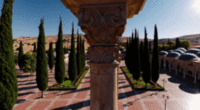
The culture of Aurelia is steeped in secrecy, wealth, and an almost esoteric sense of civic autonomy. Ever since the days of the nationalist resistance, Aurelians have valued independence and discretion as core virtues. The overwhelming presence of the Guild of Golden Shadows in city life means that clandestinity itself is a celebrated cultural trait. Outsiders might view the guild as a mere criminal syndicate or shadow cult, but locals regard it with a perhaps paradoxical pride – the guild is seen as the vital guardian of Aurelia’s prosperity and freedom. In Aurelian eyes, the covert operations of the guild are necessary measures to protect the city’s interests from outside exploitation, and to ensure that wealth and power remain under local (and secret) control. This attitude has bred a unique civic culture where loyalty is given not just to visible institutions like a city council, but also to invisible ones: the whisper networks, the secret protectors, the “Golden Shadows” themselves. Secrecy and subtlety permeate art, traditions, and social norms in Aurelia. For example, Aurelian folk songs and stories are rich with double meanings and coded references to historical events (like rebellions or heists) that only locals fully understand. Visual arts tend to favor motifs of shadow and light, or imagery of keys, masks, and hidden eyes – symbols of Chrysos’s patronage and the guild’s work. Public architecture likewise reflects this ethos: many buildings feature concealed courtyards or networks of passages; windows are often narrow and shuttered, giving the streets a guarded appearance. The famous columns of Chrysos (Chryses) scattered around the city are themselves cultural icons – each one carved with intricate reliefs depicting prosperous harvests and secret pacts – reminding citizens that wealth and mystery go hand in hand here. Life in Aurelia thus has an undercurrent of conspiracy accepted as normal. Neighbors speak in hushed tones about guild business, children play at “spies and merchant-princes,” and even open civic festivals carry an aura of ritual and hidden significance. Through it all runs a fierce streak of local patriotism: Aurelians feel their city is special, set apart by the gods and by history, and they guard its secrets jealously.
Despite (or because of) its enigmatic character, Aurelia boasts a vibrant tapestry of festivals, observances, and cultural rituals – many of which celebrate the city’s divine and natural connections. One of the most important is the annual Panegyris Chrysou (“Golden Gathering”), held on Thalassiel 6 at the height of summer. During this grand festival, Aurelia transforms into a bustling carnival of commerce and mysticism. The marketplaces swell with traders from across the highlands, fortune-telling booths line the plazas, and everything is adorned in hues of gold. Under the auspices of Chrysos, residents and visitors engage in a euphoric trade fair, bargaining for luxuries and curios. Lavish feasts are held where toasts are offered to prosperity, and storytellers regale crowds with legends of Chrysos’s cleverness and generosity – often recounting tales like The Hymn of Chrysos, which warns against greed even as it extols cunning. A highlight of Panegyris Chrysou is the Night Market Tribute, when at midnight all lights in the main bazaar are dimmed except for thousands of candles; merchants then offer a tithe of their day’s profits at a gilded altar of Chrysos, publicly placing gold coins or jewels as offerings while the crowd watches in reverent silence. This dramatic ritual reinforces the city’s spiritual link between wealth and worship. The festival’s atmosphere is one of celebratory secrecy – masked revelers dance in the streets (mask-wearing is common during this time, symbolizing both the anonymity of fortune and the hidden faces of the guild), and fortune-tellers do brisk business as people seek Chrysos’s guidance for the coming year. It is said that many a clandestine deal or alliance is struck during Panegyris Chrysou, amidst the merriment, under the forgiving eye of the wealth-god.
Another major celebration is Agavronos, observed on Atosiel 59, which reflects Aurelia’s connection to the natural world and the cycles of renewal. Agavronos is timed late in the year, when the heat has peaked and the first hints of autumn appear. On this day, the community gathers for tree-planting ceremonies to honor Host Star Agave – a celestial symbol associated with growth and rebirth. Participants plant saplings of hardy trees (often junipers or cedars) around the city’s outskirts and in public gardens. Each young tree is bedecked with ribbons inscribed with the hopes, wishes, and personal ambitions of the people who tied them. This ritual symbolizes the nurturing of aspirations: as the tree grows, so too may the prosperity and dreams of Aurelia’s citizens. The festival has a joyful yet reflective tone. There are outdoor feasts near the newly planted groves, where elders tell stories of how Aurelia itself has “re-grown” from adversity time and again. Because Agavronos aligns with Chrysos’s themes of prosperity-through-care, the guild also plays a subtle role: guild agents often anonymously fund public works or charitable acts revealed during the festival, such as donating funds to repair an orphanage or improve irrigation – these acts are seen as Chrysos’s blessings for the community’s good deeds. As night falls on Agavronos, citizens light small lanterns and hang them on the branches of the young trees, letting them shine like stars in the darkness. Prayers are murmured that Chrysos and the Host Spirit will watch over these hopes “planted” in Aurelia’s soil. The next morning, the ribbons are collected and ceremonially burned in the temple, their messages said to ascend in smoke to the heavens. Agavronos thus reinforces the idea that even a city of secrets must cultivate honest growth and renewal to thrive.
Beyond these major festivals, Aurelia’s cultural life is rich with smaller traditions that emphasize its unique values. For instance, there is a custom of the “Golden Masquerade” held on the eve of the new year, when citizens don elaborate gold-trimmed masks and cloaks and engage in a citywide game of intrigue – leaving anonymous gifts on doorsteps or speaking in riddles to friends – a playful reflection of the secrecy they live with in earnest. There are also martial ceremonies harking back to the nationalist era: on the anniversary of a notable victory or the end of the Morovian Frontier Campaign, veterans and youth organizations hold a midnight vigil at the old city gates, whispering oaths to protect Aurelia’s freedom (even though it is now within the empire). In the realm of architecture, Aurelia’s cityscape itself contributes to culture. The city is a labyrinth of winding alleyways, layered bazaars, and concealed courtyards. Many buildings have rooftop terraces connected by footbridges, allowing movement above the street – a design said to date back to the nationalist fighters who wanted ways to traverse the city out of sight. This arrangement has given rise to the practice of “Skywalking,” where certain guild-trained messengers run across the rooftops at dusk to deliver messages, an almost acrobatic tradition that locals delight in (they say if you look up at just the right twilight moment, you’ll see the shadows of couriers leaping between roofs). All these cultural elements – festivals, rituals, architecture, art, and everyday practices – weave together into Aurelia’s identity. It is a city that guardedly celebrates itself. Mystery is not merely a fact of life here; it is cherished as part of the civic character. For visitors, Aurelia’s culture can be as captivating as it is confounding: a glittering tapestry of gold and shadow, where one is never quite sure what is spectacle and what is secret. As a Bassaridian proverb puts it, “In Aurelia, the walls have ears and the shadows have stories” – to which locals knowingly add, “and both will protect us when the need arises.” In essence, Aurelia’s culture is the soul of a free city wrapped in the cloak of a secret society – prosperous, pious, and perpetually intriguing.
Important Citizens
Aurelia draws its name and initial renown from a legendary mortal heroine: Aurelia (daughter of Cato and Drusilla). In Bassaridian lore, this Aurelia was one of the nation’s greatest early military and political leaders – the strict, brilliant devotee of her father Cato (the Divine of Discipline and Order) who exemplified governance by wisdom and resolve. Born into a semi-divine lineage (purportedly a first cousin of Empress Kan Zen herself) and raised in the disciplined courts of Catonis Atrium, Aurelia earned fame for uniting fractious highland clans and establishing just rule in turbulent times. After a storied career of public service – during which she was said to have brought law and order to frontier regions and perhaps even dabbled in early nationalist thought – Aurelia retired to the city that now bears her name. She spent her final years in the Western Highlands, and local histories insist that her presence set the moral foundation of the city. Statues and busts of the Lady Aurelia adorn the halls of government buildings; she is often depicted sternly holding a scroll (for law) and a sheathed sword (for honor). The city’s emphasis on strength, honor, and wisdom is often attributed to her lasting influence. To this day, citizens point to her legacy whenever Aurelia stands up to outside pressure, invoking the memory of the woman who gave the city her name and indomitable character.
Another figure of profound importance in Aurelian lore is the demi-god Arete, son of Thyrsia and Leonidas. Arete is celebrated as the embodiment of virtue and excellence – a radiant hero who, according to myth, walked the mortal world to exemplify the highest ideals of courage, honor, and moral perfection. Though Arete’s adventures are said to have centered in the city of his birth (Catonis Atrium), his influence extends to Aurelia through cultural reverence. In fact, one of Aurelia’s most famous monuments is the Column of Virtue in the heart of the city’s main forum, a triumphal column erected in Arete’s honor. The column is engraved with scenes of Arete’s legendary deeds – slaying a great serpent of deceit, lifting a fallen tree to save villagers, and teaching kings the meaning of justice – each tableau serving as a parable of virtue overcoming vice. Citizens gather around this column during certain festivals (especially those related to civic pride or the Straight Path observances borrowed from Catonis) to recount Arete’s tales and challenge one another to live up to his example. Arete’s cult of virtue has subtly permeated Aurelia’s civic life; for instance, the city guard’s oath includes a line swearing “by Arete’s example” to remain incorruptible. In this way, Arete provides a moral compass that complements Chrysos’s influence – reminding Aurelians that wealth and power must be guided by virtue.
Throughout different eras, Aurelia has also been shaped by influential leaders and secretive figures who left their mark. In the nationalist era, various Morovian patriot-chiefs and guerrilla leaders (whose names are now cloaked in legend or secrecy) directed the city’s defiance against the Bassarids; their portraits – often deliberately anonymized with hoods or shadowed faces – hang in a back gallery of the city’s museum, symbolizing all who fought for Aurelia’s freedom. In modern times, power often lies with the unseen. A notable contemporary figure is the Guildmaster of Golden Shadows, the head of Chrysos’s cult in Aurelia, whose identity is a closely guarded secret. Known colloquially only as “the Golden Mask,” this individual (whether male or female is even unsure) is believed to coordinate the guild’s vast network from behind the scenes. While not acknowledged openly in any civic roster, the Guildmaster’s influence is felt in every major decision – truly a power behind the throne in Aurelia’s local governance. Similarly, the city venerates certain esteemed clergy and sages, such as the High Priestess of Aurelia’s Chrysos Temple, who acts as a spiritual guide and community benefactor (often funding public works from the temple’s coffers). These cult and civic leaders ensure that Aurelia’s prosperity and autonomy continue in tandem.
In sum, the pantheon of Aurelia’s important citizens is a blend of mythical exemplars and real-world guardians. From the noble Aurelia who lent her name and leadership to the city, to Arete who inspires its highest ideals, to the unsung heroes and shadowy guildmasters who steer it through present challenges – each has contributed to the mosaic of Aurelia’s identity. These figures, whether celebrated in marble statues or in whispered toasts at guild dinners, embody the city’s defining traits: strength, virtue, cunning, and an undying commitment to preserve Aurelia’s complex and alluring legacy for generations to come.
Somniumpolis

According to ancient Alperkin legends, Somniumpolis was hallowed ground long before recorded history. Indigenous myths hold that it was the birthplace of Tar, supreme god of the Alperkin pantheon. Elders tell of a primordial union of earth and dream in the Odiferae swamps, where Tar first drew breath amid luminescent mists. In this era, Somniumpolis was little more than a sacred grove of blackwater pools and drifting fog, tended by shaman-chieftains. These early spiritual founders established shrines on raised islets and in cavernous crags, believing the swamp’s heavy mists were the breath of Tar himself. The city’s very name—“City of Dreams”—echoes its origin as a place where the veil between mortal minds and divine vision is thinnest. Somniumpolitan myth recounts how the first High Dreamer, the priestess Nefeli, received visions from Tar under an ancient willow. Nefeli’s prophecies guided the Alperkin through ages of turmoil, and tradition reveres her as a semi-divine ancestor who wandered into the mist at the end of her days, becoming one with the dreamscape. Somniumpolis thus grew from a spiritual retreat into a permanent settlement as pilgrims gathered to seek Tar’s guidance in dreams and to harvest the sacred swamp for its hidden gifts.
History
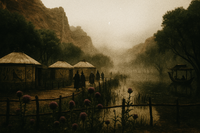
By the early modern eras, Somniumpolis also gained repute as a haven for outcasts, mystics, and rogues. During times of regional chaos, especially amid the strife of the Haifan trade empires, disillusioned seers and bold pirate crews found refuge in the labyrinthine wetlands. The city’s isolation and its people’s penchant for secrecy made it a sanctuary for those fleeing imperial authority. It was said that mystic-priests and pirate captains shared meals in stilt-hut taverns, swapping Noctic-laced brews and tales of omens. Indeed, local lore holds that the very Host Spirit of the Bassarids touched Somniumpolis in pirate form: many believe the Host Spirit manifests here as the legendary pirate called the Bull Roarer, whose bellowing call once echoed over the marshes. During this era, secretive cults devoted to dream-gods and fortune-seekers flourished side by side. The swamps teemed with renegade Reformed Stripping Path monks studying oneiromancy, and with pirate bands who treated the city as a port of shadows. Somniumpolis’s dual identity as holy ground and outlaw’s haven only grew: while the pious performed midnight rituals to Nephele (goddess of dreams) in half-submerged temples, smugglers ferried contraband spices and idols through hidden canals under cover of the perpetual mist.
The city’s fortunes shifted dramatically with the rise and fall of larger powers. Folded into the Haifo-Pallisican imperial sphere in the 35th–46th PSSC eras, Somniumpolis suffered under edicts that outlawed its cherished traditions. The old Trade Union authorities banned the ritual use of Noctic-Rabrev, the sacred dreaming-thistle, forcing worshipers of Tar and Nephele to go underground. During this occupation, Somniumpolis became restive. Folk memory speaks of the Night of Sorrow, when colonial officials burned a noctic orchard and provoked an uprising of shamans and fishermen. Pirate allies from the Hatch Ministry – an order of fearsome pirates who revered the horned god and whose fleets roamed from the arctic to Keltia’s heart – reportedly slipped past patrol ships to arm the rebels with weapons and hallucinogenic wine. Though ultimately quelled, these episodes cemented Somniumpolis’s reputation as the city that dreams defiant. When the Haifo-Pallisican authority collapsed, the swamp was quick to reassert its autonomy. In 47.58 PSSC, as the Bassaridia Vaeringheim successor state rose, rogue Bassarid loyalists seized nearby Lake Morovia ports and expelled the local Odiferian Alperkin chieftains. Somniumpolis was integrated into the new Bassarid domain, but on its own terms: local cult leaders were co-opted into the new order, and the city’s temples reopened, now flying Bassarid banners alongside offerings to Tar. In 45.18 PSSC Somniumpolis was formally recognized by the Temple of the Host as a sacred “Hostland,” affirming that the Host Spirit’s presence dwelt tangibly in its swamps. This recognition drew pilgrims and politically cemented the city’s spiritual importance within the fledgling Bassarid state.
The modern era has tested Somniumpolis’s balance of spirituality and political loyalty. In 51 PSSC, a surge of unrest shook the city: smugglers and cult extremists had entangled themselves in local trade, and reports emerged of slave-traders and renegade pirates operating in the wetlands. A series of mysterious arsons struck Somniumpolitan warehouses, halting commerce and spreading panic. Amid whispers that forbidden rites were being performed in backwater shrines, the Bassaridian War League intervened forcefully. Operation Somniant was launched – a combined military and spiritual containment campaign – to crush the pirate-slaver insurgency and suppress any dangerous occult activities. Armored gunboats patrolled the drowned forests as soldiers in ritual armor marched alongside temple investigators to root out unlicensed cults. The campaign unveiled shocking discoveries: one splinter sect had attempted to summon a malevolent dream-entity known as the Somniant Eidolan, threatening to unleash nightmare manifestations. Bassarid forces, including Odiferia Division troops and even sanctioned dream-priests from Temple Alabaster, fought through both firefights and psychic duels to restore order. By year’s end, pirate camps were dismantled, rogue shamans arrested, and the city brought back under Bassarid control. Somniumpolis emerged scarred but spiritually affirmed – the Bassarid government’s crackdown was paired with public rites of purification. In the aftermath, the High Priestess of Vaeringheim led a reconciliation ceremony in the central swamp, declaring the city “redeemed by the Host Spirit’s grace.”
Today Somniumpolis occupies a unique position: fully integrated into Bassaridia Vaeringheim’s stratocratic rule yet preserving a distinct mystical identity. It remains a vital spiritual-political nexus – a city where Bassarid governors attend dawn rituals in Tar’s honor, and where the dreams of the populace can sway policy. The trials of history have only deepened its aura. From mythic birth and pirate anarchism to Bassarid reassertion and cultic metamorphosis, Somniumpolis’s saga is one of resilience – a place eternally reborn from its own dreams.
Geography
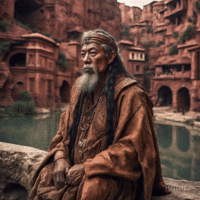
Somniumpolis lies deep in the Southern Odiferae Wetlands on the western shore of Lake Morovia, a region of steamy swamps and half-drowned forests. The city proper is an archipelago of firm ground amid a maze of marshes, interconnected by natural waterways and torch-lit boardwalks. All around, dense swamp cypresses and mangroves weave a green canopy that traps humidity and fog. The climate is humid subtropical – long, hot summers and short, mild winters with frequent rainfall. Seasonal storms roll in from Lake Morovia, often cloaking the wetlands in an ethereal mist. At dawn, thick fog blankets the canals and tree trunks, refracting the sunlight into eerie columns that locals call “Tar’s breath.” These mists are not merely weather; in local belief they carry spiritual weight. It is said one can glimpse figures in the fog – ancestors, spirits, or the Host Spirit itself – when the world falls silent. The terrain is notoriously capricious: islands of relatively solid ground rise unexpectedly from sucking bogs, and scattered red sandstone cliffs jut out of the swamp in places, relics of ancient geology. These cliffs, streaked with moss and rain, break up the flat forests and create isolated, dreamlike pockets of habitation. Over millennia, water has carved caverns into the red rock. Within these hollows are hidden sanctuaries: indeed, temples and shrines devoted to Nephele dot the caverns in the sandstone cliffs around the city. Pilgrims must often pole small boats through flooded grottoes to reach these cliffside chapels, where candles glow against crimson stone. The cliffs and the swamp together form a natural labyrinth that both protects and isolates Somniumpolis.
The influence of the land on the city’s ambiance is profound. The Odiferae Wetlands are lush but treacherous – murky waters hide both gnarled cypress roots and ancient secrets. Crocodiles and swamp big cats slip through the reeds; on moonlit nights, colonies of fireflies and bioluminescent fungi ignite the bog with an otherworldly glow. In this environment, the line between reality and reverie blurs. Villages and city districts are often separated by expanses of marsh that can only be crossed by canoe or via raised causeways. Each hamlet seems an island unto itself, surrounded by swirling mist – a natural metaphor for the “dream pockets” locals speak of. It’s said that each neighborhood has its own patron spirit or protective dream, shaped by the enclosed atmosphere. For example, a ring of weathered sandstone around one quarter might keep its inhabitants in perpetual twilight and silence, fostering introspective meditation, while just a mile away, an open lagoon reflects the sky and gives that community a more vivacious character. The mist and terrain thus cultivate a spiritual ambiance of introspection and mystery. Sound carries strangely in the wetlands: distant chants or a bullroarer’s whir can echo for miles, seeming to come from nowhere and everywhere.
Travelers often remark that Somniumpolis feels like a living dream – the air thick with humidity and incense, the ground shifting underfoot, and the horizon lost in haze. Geographically, these swamps also dictate the city’s economic and spiritual life. Recurring floods nourish rare plants like the Noctic-Rabrev thistle that nowhere else grows so abundantly, underpinning the city’s sacred economy. At the same time, the swamp’s treacherous waterways have historically served as both highway and moat: they enable riverine trade to Lake Morovia while frustrating any conventional armies that might approach. The only clear route in is via the Morovian waterways or a few well-guarded rail causeways. In sum, Somniumpolis’s geography is inseparable from its identity – a mist-bound mire that at once shelters its people and inspires their deepest dreams. The very landscape seems to dream alongside its inhabitants, protecting their reveries behind curtains of fog and walls of red rock.
Economy
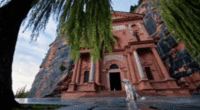
Despite its remote and otherworldly setting, Somniumpolis sustains a dynamic economy intertwined with spirituality and illicit enterprise alike. At the heart of its economic life is the cultivation and trade of Noctic-Rabrev, the rare hallucinogenic thistle that thrives in these marshes. Noctic-Rabrev is revered as a divine gift here, and whole families tend to “noctic orchards” on hummocks of dry land. The plant’s purple flowers and sticky leaves are harvested in ritual manners by authorized gatherers. In Somniumpolis, Noctic is not merely an export—it's a sacred crop. The blossoms are processed into incense, oils, and the infamous inky “dream ale” that is quaffed during holy ceremonies.
The local temples closely supervise its cultivation, ensuring proper rites are performed so as not to anger the plant’s spirit. However, alongside its sacred use, Noctic-Rabrev has become a lucrative commodity, especially since Bassaridia Vaeringheim lifted the old imperial ban on it. Traders from across Keltia venture into the swamps to purchase Noctic by the barrel. In dimly lit Somniumpolitan taverns, one can find merchants and speculators haggling over bales of dried Noctic leaves as if trading in gold. This dual role of the plant has led to tension: the city’s druidic cultivators insist on its ritual purity, while outside investors treat it as a psychoactive treasure for profit. A delicate balance is struck – the Temple of Somniumpolis issues licenses for Noctic export, and a portion of the profits fund communal feasts and temple schools. Still, whispers abound of unsanctioned noctic distilleries deep in the marsh, and of fortunes made overnight by those willing to skirt temple regulations. Noctic-Rabrev’s speculative boom has pulled Somniumpolis into global markets, for better and worse. It is now a key supplier of the herb to the rest of Bassaridia Vaeringheim, with the General Port of Lake Morovia serving as the primary export hub. What was once a purely sacred herb is also a cash crop, and the city’s economy sways with the global demand for dream-inducing substances.
Beyond the Noctic trade, Somniumpolis’s economy is enlivened (and shadowed) by networks of piracy, smuggling, and unconventional finance. The city’s location on Lake Morovia’s western fringe places it on an important trade artery – all traffic between inner Keltia and the coastal markets passes near. Historically, this gave rise to the Lake Morovia Blockade Fund, a notorious Bassarid-aligned outfit that in times past imposed “tolls” on lake commerce and hoarded wealth in secret swamp caches. In modern times, the Blockade Fund has been semi-legitimized as a regulatory body that still times its patrols and interventions with the seasonal storms on the lake. Ostensibly tasked with protecting shipping, it has not entirely shed its origins as a pirate consortium. Many a trader suspects the Fund’s patrol skiffs of turning a blind eye to (or even facilitating) smuggling operations when the price is right. Meanwhile, the Hatch Ministry pirates have left their mark on the Somniumpolitan economy as well. Though the Hatch Ministry’s main fleets prowl far-off seas, splinter groups affiliated with this order of Dionysian freebooters occasionally surface in Lake Morovia’s waters. These pirates-turned-privateers have a penchant for Noctic smuggling and gun-running. Local rumor holds that some swampland clans in Somniumpolis act as go-betweens for the Hatch Ministry, trading barrels of Noctic ale and enchanted swampwood in exchange for imported luxuries or weapons. In hidden coves draped in Spanish moss, one might find a Hatch captain’s longship refitting under the protection of an archaic pact with the Odiferian tribes. The Baratar Corporation – Bassaridia’s state-sanctioned civilian militia supplier – also intertwines with these murky dealings. Headquartered in Somniumpolis’s port district, the Baratar Corporation officially provides arms and training to citizen militias. Yet it’s an open secret that some of those arms have flowed into less-than-legal hands. In the chaotic years post-imperial collapse, Baratar’s local agents allegedly equipped friendly pirate crews under the table, rationalizing it as “community defense.” Even now, the city’s docklands host a brisk clandestine trade: militiamen, corsairs, and black-market couriers mingle under the incense-sweetened air. Thus, pirate and smuggler networks remain deeply tied into Somniumpolis’s economy, blurring the line between sanctioned commerce and criminal enterprise.
Perhaps the most surreal pillar of Somniumpolis’s economy is the Somniant Stock Fund, a corporation whose name evokes dreams but whose output is very real. Headquartered in this fortified city, the Somniant Stock Fund has grown into Bassaridia Vaeringheim’s premier defense contractor. By all appearances it is a high-tech manufacturer producing warships, quadwalker tanks, and advanced weaponry for the Bassaridian War League. However, its moniker hints at its unusual origins. Locals recount that the “Stock Fund” began as an occult financial cabal during the unstable 40s PSSC: a circle of mystics and merchants who used prophetic dreams to guide investments in steel, saltpeter, and arcane research. Over time, this dream-guided fund grew rich and formalized into a corporation. Today it operates massive workshops (half-factory, half-temple) on the city outskirts, where engineers and oneiromancers collaborate. The Somniant Stock Fund is indeed a dream-based financial institution in the sense that many of its strategic decisions are still said to be influenced by oneiric rituals. Its board includes “Dream accountants” who enter trance states seeking Nephele’s insight on market trends. Under Bassarid governance, this company has been harnessed to national aims: it bankrolls and builds cutting-edge military hardware, from amphibious airships to spiritual containment devices, maintaining Bassaridia’s martial edge. The presence of this Fund in Somniumpolis provides jobs and prestige – the city’s foundries and alchemical labs hum with activity – but also reinforces the fusion of economy with mysticism. Every new tank or submarine launched from its yards is baptized in sacred swamp water and Noctic smoke, blurring commerce, war, and faith. The city even boasts an unusual “Dream Exchange,” a nighttime bazaar and informal stock-market-like gathering where local entrepreneurs trade shares of ventures based on the previous night’s visions. In sum, Somniumpolis’s economy is an eclectic tapestry: Noctic-Rabrev production straddling holy sacrament and speculative export, pirate-smuggler networks operating in the shadows of state institutions, and a formidable dream-led corporation marrying profit with prophecy. This unique blend sustains the city, enriching it while keeping it perpetually on the boundary between the material and the mystical.
Politics
Somniumpolis sits at the intersection of canals, swamps, and Hostian Dream Spaces, and its political culture is unusually sensitive to questions of spiritual hygiene, anomalous threats, and swamp ecology. The Morovian Social Cooperative draws strength from wisp-rice farmers and canal labourers, while the Alperkin Earth & Sky League speaks for Alperkin and swamp-dweller communities determined to retain control over their sacred wetlands. The Path of Renewal Party appeals to citizens who see the management of Dream Spaces as a religious obligation, and the War League Guardians Bloc maintains a base among those who credit the War League with keeping outbreaks and cult-deviancy under control. The Councilist Unity Front and Diaspora Bridges Movement are influential in negotiations over corridor access, foreign observers, and Port-funded containment efforts.
Culture
Life in Somniumpolis is steeped in mysticism, creativity, and a reverence for dreams. The culture is profoundly shaped by the influence of the Reverie Nebulous, a mystical order headquartered here that is devoted to Nephele, Lady of Dreams. Members of this order – the so-called Dreamweavers – are poets, artists, and seers who treat the subconscious as their canvas. Their presence permeates the city: one might encounter Dreamweavers in the markets swapping last night’s visions as currency, or see them staging impromptu street performances that reenact dream-journeys for onlookers. The ethos of Somniumpolis holds that the waking world and dream world are deeply intertwined. This is evident in the Dream Space at the city’s heart – a revered communal temple that serves as a direct portal to communion with the Host Spirit. Somniumpolis’s Dream Space (said to be one of the most sacred in Bassaridia Vaeringheim) is an open-air pavilion surrounded by swamp willows and standing stones. Here citizens gather at twilight for guided meditations and collective “dream-singing” rituals. It is believed that by aligning their thoughts, the community can send a unified message into the Host Spirit’s dreams. Unlike typical shrines to the gods, this Dream Space has no idol – instead it houses a tranquil reflecting pool that captures starlight and the flicker of swamp fireflies. Cultural life revolves around such liminal, reflective practices. Even daily greetings carry a hint of the mystical; locals say “May your dreams be bright” instead of a simple hello. Storytelling, too, is elevated to a spiritual exercise: every family has a trove of ancestral dream-tales passed down through generations, which are told around oil lamps at night to teach moral and metaphysical lessons. In Somniumpolis, a grandmother might recount how she once dreamt of a golden jackal that led her safely out of a marsh – a tale both entertaining and interpreted as a sign of Host Spirit’s guidance. Through these narratives, the line between personal memory and myth blurs, weaving a rich cultural fabric where everyone’s imagination has a place. Festivals in Somniumpolis are unparalleled in their otherworldly pageantry. Chief among them is Liléigostros, an annual celebration that embodies the city’s love affair with the surreal. During Liléigostros – observed each spring on a misty night when the first swamp lilies bloom – Somniumpolis transforms into a living dreamscape. Residents craft floating lanterns shaped like lilies and set them adrift on the blackwater canals, creating ribbons of gentle light through the dark marsh. As the festival begins, masked performers representing spirits of the swamp emerge from the fog. It is a time when the whole community collectively “walks in a dream.” People wear elaborate costumes inspired by their own dreams: one might see a citizen dressed as a shimmering fish with human eyes (from a strange dream they had) or another as a tree that sprouts birds. By custom, the boundary between identities softens this night – neighbors address each other by their dream personas, not their everyday names. In hushed processions, guided by the soft drone of bullroarers, they move from shrine to shrine in the city, reenacting mythic journeys. One beloved ritual of Liléigostros is the “Mist Hunt,” where youths venture with lanterns into designated foggy groves to symbolically capture flickering lights (representing insight or epiphany) and bring them back to the Dream Space. The festival culminates at dawn with the Oneiric Tableau: a grand performance on a floating stage where the most skilled dreamweavers portray the city’s collective dream from the past year, translating shared hopes and fears into dance and song. Liléigostros is at once eerie and jubilant – a testament to Somniumpolis’s embrace of the fantastical.
Another cornerstone of the cultural calendar is Oneiro Foteino, the “Dream of Illumination” festival dedicated to Nephele. Celebrated on Thalassiel 31, this festival is a more serene counterpart to Liléigostros. For Oneiro Foteino, Somniumpolis is adorned with floating paper lanterns and surreal art installations that turn the city into a gallery of dreams. By night, ambient music—soft flutes and chimes—echoes through the canals, designed to blur the boundary between wakefulness and sleep. The highlight of Oneiro Foteino is a grand public meditation led by the Reverie Nebulous. Thousands gather in the central plaza, each person holding a candle or a small prism. Under the guidance of chanting dream-priests, the crowd enters a light trance together, seeking clarity and creative inspiration from Nephele. It is said that many artists and writers experience breakthroughs during this communal meditation, later crediting the festival for their bursts of genius. During the day of Oneiro Foteino, workshops on dream interpretation are held in every neighborhood. It’s common to see children painting their dreams on murals and elders composing impromptu poems. The city’s walls are temporarily covered in chalk drawings depicting last night’s collective dreams, to be washed away by the next rain—an ode to the ephemerality of inspiration. Both Oneiro Foteino and Liléigostros underscore a cultural truth: Somniumpolis thrives on the fusion of art, ritual, and shared imagination. Every citizen, whether fisherman or militia guard, is in some sense a dreamer and a performer. Artistic traditions here are uniquely tied to the dream theme. The visual arts favor fluid, metamorphic motifs; murals often show humans transforming into animals or landscapes that morph into faces. A popular form of folk art is “dream-cartography”, where mapmakers draw the city not as it physically is, but as it feels in dreams – streets might be depicted as flowing rivers, temples as floating islands. The performing arts are equally esteemed. The city supports numerous small theaters where plays based on local myths or famous dreams are staged with inventive use of shadow and light. Storytelling circles meet weekly; here, professional storytellers (griots) compete in weaving the most entrancing tale, often improvising from audience suggestions. Winning tales – like the fable of the boy who bargained with a wraith in his sleep to save his village – spread through neighborhoods and become part of oral lore. Daily life even has a ritualistic bent: at dawn, many families burn a pinch of dried Noctic-Rabrev leaf as an offering for a day of good dreams and visions to come. And at dusk, it’s common to hear lullabies that double as prayers to Nephele, ensuring safe passage through the night’s dreamscapes. The people of Somniumpolis also have a playful side in culture; the influence of the city’s pirate past has not wholly vanished. During certain festive nights (like the raucous Bassaridia Carnival in late summer), Somniumpolitans dress as historical pirates and mystics, satirizing old stories – dancing and indulging in spiced “Ale of the Night” beer that fuels Dionysian revelry. Such occasions show that even in their spiritual devotion, Somniumpolis folk embrace mirth and earthly joy. Ultimately, the culture of Somniumpolis is a vibrant tapestry where mysticism, art, and community intertwine. The city’s festivals and daily customs reinforce a collective philosophy: life is but a dream to be shared, explored, and celebrated in all its shadow and light.
Important Citizens
Nefeli – In Somniumpolis’s lore, Nefeli stands as a bridge between mortals and the dream divine. Reputedly an ancient High Priestess from the city’s founding era, she is said to have been the first Oracle of Somniumpolis. Legends describe Nefeli as walking the swamps when they were trackless, guided only by starlight and the whispers of Nephele. During a great drought in mythic times, it was Nefeli who dreamt of a hidden spring beneath a cypress tree, saving her people when the water was found exactly where her dream foretold. She is often depicted in local art as a veiled woman wreathed in mist, holding a bowl of swamp water that reflects the night sky. Some traditions equate Nefeli with the goddess Nephele in mortal form – a claim orthodox Reformed Path clergy are cautious about, but which Somniumpolitan folk readily embrace in their storytelling. Nefeli’s symbolic importance is immense: she represents the ideal of receptive wisdom, the notion that by attuning to dreams one can guide an entire community. Temples in the cliffs have alcoves dedicated to her, where devotees leave offerings of lotus flowers and small mirrors (so Nefeli may send visions). Many female children in Somniumpolis are named Nefeli in her honor, and a common blessing intoned at births is “May she have Nefeli’s sight.” To this day, the Council of Dreamweavers claims to descend in lineage (spiritual if not blood) from Nefeli’s own acolytes. In cultural memory, she remains a gentle, guiding presence – the archetype of the wise dreamer who uses her gifts selflessly.
Morpheus – A figure shrouded in both history and myth, Morpheus is celebrated in Somniumpolis as a legendary seer and artisan of dreams. By name, he evokes the ancient god of dreams, and locals indeed believe he was an avatar or at least a favorite of Nephele. Morpheus is said to have lived during the early Bassarid era, around the time when the city first opened to the outside world. He was a wandering mystic from distant lands (some tales say a fallen Haifan nobleman) who made his way into Somniumpolis after dreaming of a “swamp that sings.” Morpheus quickly gained renown for his unparalleled skill in dream-crafting – he could purportedly fashion physical objects that captured the essence of dreams. Stories claim he created the Somnioptic Lens, a crystal orb still kept in the city’s Temple Archive, which when gazed through, allows one to see fleeting images of the viewer’s own future dreams. Morpheus also founded a tradition of theater in the city; he directed nighttime plays where actors performed entirely in a trance state, improvising dialogues that, eerily, every spectator understood differently (each heard the words most meaningful to them). Historical records – albeit scarce – do mention a “Morpheus of Somnium” who advised the early Bassarid governors on matters of the psyche, helping integrate the Alperkin dream rituals with the Bassarids’ own spiritual framework. Thus he is credited with easing tensions and preserving Somniumpolis’s heritage under foreign rule. In mythic retellings, Morpheus eventually “faded” into the dream world: during one Oneiro Foteino festival he lay down in a shrine and simply never woke, his body gone when checked. Somniumpolitans lionize him as the patron of artists and visionaries. A popular tavern in the city, the House of Morpheus, has above its door the inscription: “In dreams, truth.” Each year, a contest for young playwrights – the Morpheus Masque – is held, encouraging participants to write plays based on their most vivid dreams, a living homage to this enigmatic citizen.
The Bull Roarer – Neither fully mortal nor god, the Bull Roarer is a beloved legendary figure in Somniumpolis, embodying the city’s wild, liminal spirit. Folklore describes him as a towering pirate captain from centuries ago, with a voice so deep and powerful that it could carry across the entire swamp. In life, the Bull Roarer was said to have led a band of Odiferian pirates who navigated the misty channels and harried oppressive merchants. He earned his name because before his crew would strike, he’d swing a bullroarer instrument above the water – the peculiar droning howl echoing through the night, instilling awe and panic. Many locals believe that the Bull Roarer was in fact a guise of the Host Spirit in this region. Stories tell of impossible feats: his ship (a flat-bottomed barge dubbed the “Blue Ghost”) could disappear in one patch of fog and reappear miles away in an instant, and enemy blades passed through him as if he were made of smoke. After his mortal days ended, legend holds that his spirit became one with the swamp. Fishermen still swear that on stormy nights, when clouds churn and the wind dies, you can hear a low, unearthly hum rolling over the marsh – the Bull Roarer’s call, protecting Somniumpolis from unwelcome intruders. He has thus become a cultural hero and a sort of local saint of defiance. During festivals like the Bassaridia Carnival, some revelers dress as the Bull Roarer – wearing carved wooden masks and swirling bullroarers overhead to recreate his haunting sound. Children are told if they are lost in the swamp to stay put and call for the Bull Roarer; he might answer with a guiding drone to lead them home. In a city straddling piety and lawlessness, the Bull Roarer symbolizes the sacred in the profane – a pirate spirit who serves the Host Spirit’s will. His legend reinforces the community’s pride that even their ruffians and outlaws are touched by divine purpose.
Tar (in Living Memory) – While Tar is worshipped as a god, Somniumpolis also cherishes semi-historical figures claimed to be Tar’s avatars or incarnations. One such important figure is the so-called Tar Child of Somniumpolis. This was, according to oral histories, a prodigious boy born during a solar eclipse in the 37th era PSSC. From a young age, the boy spoke in archaic tongues during sleep and identified himself with Tar. He purportedly performed miracles – causing lotus flowers to bloom out of season and surviving venomous snake bites unharmed. Many flocked to see this Tar Child, believing Tar’s essence dwelt in him. The local chieftain at the time, wary of imperial attention, kept the child’s identity secret, but allowed him to be raised by temple guardians. Some accounts say the boy vanished at age twelve, walking into a bubbling tar-pit with a serene smile, as if returning to the earth. Whether literal or allegorical, the Tar Child’s story reinforced Tar’s continuing presence in the city. Elderly residents still recall being told as children that they might meet Tar in human form along a misty road – perhaps as a kind stranger or a mysterious songman – so they should treat all with kindness. This tradition of perceiving the divine in ordinary people is part of Somniumpolitan ethos and is often attributed to the legacy of the Tar Child and similar figures. Through them, the supreme deity Tar is woven into the fabric of local identity, not a distant figure but one who walks the swamps alongside his people.
In sum, Somniumpolis venerates a rich cast of mythic and historic figures who personify its values. From the gentle wisdom of Nefeli and the creative fervor of Morpheus, to the rebellious guardianship of the Bull Roarer and the immanent divinity of Tar’s avatars, these characters live on in daily tales, temple rites, and the collective dreamlife of the city. Each citizen grows up with their exploits and lessons in mind, inspiring new generations to add their own chapter to the ever-evolving legend of Somniumpolis.
Nexa
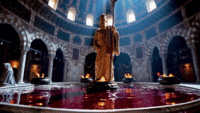
Nexa stands as a mystical ancient city, founded by the Alperkin deep within the heart of the Gloom Forest of Perpetual Autumn. Revered for its mysterious allure and timeless beauty, Nexa is a sanctuary of ancient wisdom and spiritual enlightenment. Today, it is home to the Eon Fellowship, a cult of the Reformed Stripping Path devoted to Glinos, Divine of ice and winter, symbolizing the eternal cycle of life and death.
History
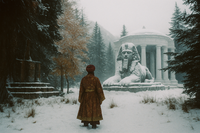
The history of Nexa is shrouded in the mists of time, its true origins lost to legend. According to ancient lore, the first Alperkin clans were guided to this forest refuge by Boreas, a demi-god of the northern winds, who blanketed the wood in eternal autumn at the behest of Glinos. In those primordial days, the very veil between life and death felt thinner here: it is said that Glinos’s own daughter, the legendary Glacia, walked among Nexa’s early people. Glacia is remembered as a semi-divine heroine who established the city’s earliest winter rites and built the first sanctuaries – including the sacred Dome of Glacia, which, legend holds, she raised from ice and prayer to honor her father. One oft-told myth recounts Glacia’s duel with a fearsome stag-demon named Laprind, whose blood spilled across the autumn woods and formed the enchanted crimson pools known as the Bloodbaths of Laprind. With Laprind defeated, the forest’s wild spirits were tamed, and Nexa’s destiny as a holy city was sealed in myth.
In recorded history, Nexa grew into a revered spiritual center for the Alperkin people. For millennia it remained an independent bastion of knowledge and mysticism, ruled by council(s) of shamans and chieftains who guarded its secrets. The city’s isolation kept it safe from many outside conquests, but not from the grand tides of change. In the late 40’s PSSC, during the rise of Bassarid power, Nexa inevitably became drawn into regional conflicts. As the stratocratic forces of the Bassaridian War League moved to consolidate control around Lake Morovia – crushing Morovian rebels in the highlands and sweeping through Alperkin territories – Nexa’s haven could not remain untouched. The Morovian Frontier Campaign (c. 48.69 PSSC), which broke the back of western Keltia’s independence movements, also saw Bassarid legions encircle the Gloom Forest. Determined to quash any remaining resistance, Bassarid commanders forged into the misty autumn woods, skirmishing with Alperkin wardens under the flaming canopy. Outmatched by superior weaponry and sheer numbers, the Alperkin of Nexa eventually struck a truce rather than face obliteration of their sacred city. By 47.58 PSSC, Nexa – like its sister settlements around Lake Morovia – was formally integrated into the newly established Associate Domain of Bassaridia Vaeringheim. This marked the end of Nexa’s age of autonomy and the beginning of a delicate balance under foreign rule.
Under Bassarid governance, Nexa retained its mystical character even as imperial infrastructure slowly threaded into the forest. The city’s new overlords, mindful of Nexa’s spiritual importance, often ruled with a lighter touch here than in more restive cities. The Eon Fellowship was permitted to continue its devotions, now under the nominal oversight of the Bassarid Temple Authority, and local chieftains were co-opted into advisory roles. Even so, tensions occasionally flared. The forest’s isolation and fierce traditions bred quiet dissent, culminating in episodes like the uprising of 51 PSSC, when discontented locals and zealots rallied in Nexa’s central forum against increased Bassarid taxation and perceived sacrilege by outsiders. That protest descended into bloodshed; Bassarid troops (two full Ordo of the War League) stormed the misty streets to “restore order,” putting an abrupt end to the rebellion at the cost of dozens of lives. In the aftermath, a somber peace returned. Over time, overt resistance gave way to subtler forms: a steadfast preservation of culture, secret prayers for deliverance, and the patient hope that the forest’s spirits might outlast any empire. In modern times, Nexa stands at a wary equilibrium – loyal enough to Vaeringheim to avoid reprisal, yet quietly guided by its own ancient soul. The city endures as a living relic: a place where every fallen leaf, every dusk fog, and every temple chant echoes with the resolve of a people who remember who they are, even under the shadow of empire.
Geography
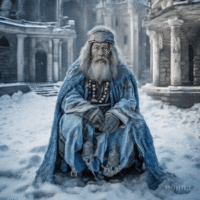
Nexa lies deep within the most fabled expanse of the Gloom Forest of Perpetual Autumn. The surrounding forest is dense and otherworldly – an endless array of crimson and gold foliage that never withers beyond autumn. Towering oaks and Alon Pyralis trees (the sacred fire-maples of the Alperkin) dominate the canopy, their gnarled branches clawing toward a perpetually twilight sky. Leaves drift down in a constant gentle rain, carpeting the ground in hues of rust and amber; as one generation of leaves decays, new red-gold buds appear, ensuring the forest is forever caught between life and dormancy. A cool, mist-laden climate prevails year-round. The air is damp and chill; morning fog snakes through the trunks and clings to the mossy undergrowth well into midday. Rainfall is steady in all seasons, and true winter’s frost only rarely dusts the ground – a curious moderation of climate that locals attribute to Glinos’s influence, as if the Winter Divine stays his full wrath here, keeping the forest in an eternal autumnal embrace. This unique environment nurtures unusual flora: bioluminescent fungi glow sapphire in the gloom, ferns and berry shrubs prosper in the rot-rich soil, and certain flowers bloom only under the harvest moon’s light. Fauna, too, are distinctive: silent owls with scarlet-tipped feathers, foxes with coats like fallen leaves, and spectral Deepwood Gloomwolves that, according to legend, prowl alongside Glinos on cold nights.
The terrain around Nexa is a rolling woodland broken by hidden vales and limestone outcroppings. Just north of the city yawns the famous Deerbone Cave – a vast cavern system littered with the bleached bones and towering antlers of ancient Titandeer. These gargantuan deer roamed the forest in prehistoric times, and their graveyard-like remains give the cave its name. The cavern’s chambers are often visited by pilgrims and scholars alike; some seek communion with primordial spirits said to linger near the titanic skeletons, while others harvest rare cave mosses for medicine. To the west of Nexa, nestled in a misty hollow, lie the Bloodbaths of Laprind. These are a cluster of natural spring-fed pools stained red as blood, tinted by iron-rich earth and a crimson algae that thrives in their waters. The Bloodbaths steam softly in the chill mornings, and an eerie haze hangs above them at dusk. The site is as beautiful as it is unsettling: local folklore warns that the water will boil if a great evil is near, yet it is also revered for its healing qualities. Surrounding these pools are ancient standing stones carved with runes, marking the area as a place of sacrifice and renewal since time immemorial. Meanwhile, the city itself is interwoven with its forest setting – ivy-clad ruins and marble obelisks from bygone eras lie half-swallowed by roots and ferns. Even Nexa’s newer structures, like its timber halls and the domed Temple of Glacia, seem part of the woodland: draped in lichen, adorned with carved leaves and antlers, and often built around living trees. Mists swirl through the streets at dawn and twilight, making the boundary between city and forest feel like a dream.
Despite this seclusion, Nexa is not entirely cut off from the wider world. Old Alperkin trails and newer imperial roads pierce the Gloom Forest in winding courses. A rough-hewn caravan path leads eastward towards the swamplands of Somniumpolis on the lake shore, while another overgrown route connects south, skirting the tar-pits near Erythros before emerging onto the plains by Lake Morovia. In recent decades, the Bassarids reinforced parts of these routes for military and trade convoys – wooden causeways now traverse the boggiest glades, and mossy mile-markers bearing the lion crest of Vaeringheim guide travelers beneath the canopy. Still, travel to Nexa remains an adventurous undertaking. Caravans from the General Port of Lake Morovia often arrive cloaked in fog, their wagons laden with grain, salt, or textiles to trade for forest goods. The journey is slow and sometimes perilous: landslides can send whole sections of road tumbling into ravines, and travelers speak in hushed tones of strange lights flitting between the trees (believed to be guardian spirits warning away the impure of heart). Yet those who brave the trek are rewarded with entrance to a realm seemingly untouched by time. Approaching Nexa, one crosses a weathered stone bridge over a creek known as the “Vein of Glinos” (for its red-tinged waters), passes under an arch of intertwined oak branches, and finds the city revealed like a hidden jewel in the haze. In every direction beyond its outskirts stretch the ancient woods – an ever-present reminder that Nexa’s first and truest walls are the enchanted forest itself.
Economy

The economy of Nexa is modest, mystical, and deeply intertwined with the living forest that surrounds it. Unlike the bustling mercantile hubs of the Bassarid empire, Nexa has little in the way of heavy industry or mass commerce; instead, it survives and quietly prospers through the careful stewardship of natural resources and the trade of spiritual goods. The people here follow the old Alperkin ethos of living with the land’s rhythms. Foremost among Nexa’s resources are its forest products. Skilled foragers venture out to gather rare medicinal herbs, roots, and fungi from secret groves known only to their clans. The crimson sap of the Alon Pyralis trees – often called “autumn’s blood” – is collected in small quantities during special moons; this golden-red resin is famed for its alchemical properties and is used in everything from healing salves to incense burned in distant temples. Wood from fallen forest giants (never freshly cut without ritual permission) supports a small woodworking cottage industry: local artisans carve totems, masks, and charms imbued with the iconography of autumn and winter, prized as both artworks and talismans. Hunting is practiced with reverence; game animals (wild boar, forest deer, and game birds) provide meat and hides, and nothing is wasted. The finest pelts and furs – especially the rare white stag hides found occasionally in the depths of the Gloom Forest – are cured and traded, while bones and antlers are crafted into ritual objects or tools.
What surplus Nexa produces is traded through traditional bartering as well as official channels. A few times a year, caravans sanctioned by the Bassarid authorities carry Nexa’s goods outward. In exchange for medicinal plants, aromatic resins, enchanted trinkets, and curated knowledge (such as dream-interpretation manuscripts or spiritual consultation), the city receives necessities it cannot procure in the forest. Salt, iron tools and nails, lamp oil, grain and rice, and occasional luxuries like fine cloth or tea are bartered in modest quantities. The General Port of Lake Morovia and the capital Vaeringheim are the ultimate destinations for many of Nexa’s exports: at the great port’s markets, a vial of Nexan leaf-oil or a carved “spirit mask” fetches a high price from collectors charmed by the exotic Gloom Forest mystique. This trickle of trade has grown somewhat since integration into Vaeringheim; a Bassarid trade outpost just outside Nexa’s limits now supervises commerce and ensures imperial taxes are collected (much to the locals’ chagrin). Still, the tempo of business remains slow and ritualized. Coin is used, but true Nexans prefer barter or communal distribution overseen by elders. Indeed, the Eon Fellowship’s temple doubles as a communal granary and treasury: offerings to Glinos, whether in grain or crafted goods, are redistributed in times of need, ensuring no family starves even in lean winters. In this way, spiritual duty and economic life blend seamlessly.
Though unorthodox, Nexa’s economy has a strategic value recognized by the Bassarids. The region’s rare resources – especially pharmaceutic herbs and mystical reagents – quietly supply apothecaries and alchemists across the realm. There are whispers that even the Bassarid Temple in far-off Agripinilla burns Nexan incense in its ceremonies, and that Bassarid war-healers carry poultices made from Gloom Forest fungi for soldiers’ wounds. Locally, a small market square convenes each Opsitheiel (autumn) when traders from neighboring towns, and sometimes even brave merchants from Aurelia or Luminaria, arrive. These market days are as much spiritual gatherings as economic exchange: bargains are often sealed with a prayer or a libation poured out in honor of the forest. The overall result is a delicate balance: Nexa’s people take from the forest only what it can yield anew, and in return they gain enough from outside to supplement their simple lives. By modern standards, life in Nexa is materially humble – there are no grand riches here – but the community thrives in its own way, rich in knowledge, tradition, and the bounties of an enchanted wood.
Politics
Nexa is an industrial logistics city whose furnaces, armouries, and motor pools give it a starkly militarised political temperament. The War League Guardians Bloc is the leading party, reflecting the city’s role as a staging area for campaigns and as a production hub for heavy weapons and vehicles. The Free Investors & Merchants League champions the interests of arms manufacturers and investors, while the Councilist Unity Front acts as the interlocutor with the Council of Kings. The Morovian Social Cooperative organises factory cells and workers’ committees, pushing for safety, compensation, and post-deployment care, often clashing with FIML and WLG over the pace of expansion and the human cost of perpetual readiness.
Culture
The culture of Nexa is steeped in ancient tradition, spiritual reverence, and an almost palpable sense of the cyclical nature of existence. Life here moves to the rhythm of the seasons and the whisper of the trees. The influence of the Eon Fellowship permeates daily life: this devoted order to Glinos serves not only as religious guides but as keepers of lore, healers, and teachers in the community. At dawn, one can often witness fellowship shamans draped in frost-white and midnight-blue robes processing through the forest paths, chanting hymns that call upon the Divine of Winter to bless the coming day. Many Nexans begin their morning by joining these rites or by lighting a small candle at their doorstep, letting it flicker in the mist as a humble tribute to the cycle of night and day, life and death. Unlike the more exuberant or urban cultures elsewhere, Nexa’s is quiet and introspective. A prevailing ethic here is harmony with nature – children are taught from the earliest age that each fallen leaf carries a spirit and every creature has a role in Glinos’s grand cycle. As a result, kindness to animals, respect for elders (seen as those closest to returning into the earth), and the sanctity of dreams and omens are cultural cornerstones.
Festivals and rituals in Nexa are profound communal experiences, often blending somber reflection with moments of fierce joy. The holiest time of year comes at the cusp of winter: on Thalassiel 44 (late autumn) the city observes the Erev Galgal, or Eve of Cycles. During this festival, devotees from near and far gather at dusk in the central plaza before the Dome of Glacia. They arrange themselves in great concentric circles – elders in the center and youth at the edges – and as night falls, they begin resonant rotating chants. Deep drums and horns made from titandeer horn sound a slow beat while the circles move clockwise, then counter-clockwise, in symbolic dance of the turning wheel of life. Lamps are lit one by one in a spiral pattern, and intricate patterned mosaics of colored sand (prepared earlier on the plaza ground) glow under the firelight, depicting scenes of renewal: a tree sprouting from a skull, a phoenix-like bird rising from autumn leaves, Glacia embracing an infant beneath falling snow. At the climax of Erev Galgal, a ceremonial bonfire is ignited with flame kindled from the friction of old oak branches – no common spark will do – and into its flames the celebrants cast written prayers for the departed and for future blessings. This night, said to be when the veil between worlds is thinnest, ends with a predawn silence as the mist rolls in, and the faithful whisper prayers as the first light of morning dispels the darkness.
Nexa’s cultural calendar also features the Frostfire Convergence, a rite held on the winter solstice. In this ritual, members of the Eon Fellowship and townsfolk alike undertake a midnight pilgrimage from the city to a clearing deep in the forest (often near the Bloodbaths of Laprind). Each carries a torch of woven pine and sage. Upon reaching the clearing, they stand in a wide circle and plunge their torches into the cold waters of a sacred spring, extinguishing the flames. Immediately, another group of participants ignites a towering wicker effigy at the center of the circle – an effigy representing the Spirit of Winter. The sudden bloom of warmth and light amid the surrounding darkness and cold water symbolizes the promise of rebirth even in the heart of winter’s death. Prayers are offered to Boreas to carry the community’s hopes into the sky on his icy winds, and to Glacia to guard the souls of those who will not see the next spring. Such ceremonies, along with regular practices like storytelling circles and meditation walks under the full moon, reinforce Nexa’s identity: introspective, reverent, and resilient.
Despite the city’s pious atmosphere, Nexa is not without levity or creativity. Music and art here take on spiritual dimensions – haunting flute melodies echo like wind through bare branches, and paintings are done with pigments made from berries and ash, yielding muted tones that mirror the forest palette. Storytelling is a cherished art: in the evenings, families huddle around hearths as elders recount both mythic sagas and recent histories, weaving tales where the line between mortal and divine blurs. These stories keep alive the memory of the city’s trials and triumphs. Notably, tales of resistance against outside rule – though never spoken loudly in public – have become quiet parables told in metaphor. A popular children’s fable, for instance, speaks of a family of wise foxes (the people of Nexa) outsmarting a pride of lions (the Bassarid conquerors) not through violence but through patience and cunning, preserving their woodland home. In subtle ways, such cultural expressions preserve a sense of independence. Furthermore, while the Bassarid authorities impose certain observances (for example, empire-wide holidays or victory commemorations), Nexa folds these into its own traditions. A Bassarid victory day might be marked here by a prayer for peace and a secret libation at an old shrine, transforming a foreign celebration into a moment of local meaning. The result is a culture that outwardly appears compliant yet inwardly remains distinctly Nexan – guided by the cycle of seasons, the wisdom of ancestors, and an unwavering faith that all things, even subjugation, are transient in the flow of time.
Important Citizens
Nexa’s rich of myth and history is reflected in the celebrated figures – both legendary and real – who have shaped the city’s identity. Foremost among these is Glacia, remembered as the Winterheart of Nexa. According to lore, Glacia was the mortal (yet divinely-blessed) daughter of Glinos and a human mother from the Alperkin tribes. In an era when gods still mingled with mortals, Glacia led the first settlers to the site of Nexa, guided by visions of an eternal autumn sanctuary. She is said to have established the Eon Fellowship’s ancient precursors, teaching the people the sacred rites of winter and the wisdom of embracing life’s cycle. Legends credit her with constructing the original Dome of Glacia – praying for seven days atop a mound of snow and leaves until the divine frost formed walls of ice that no flame could melt. While those ice walls eventually turned to crystal and stone, the temple that stands today is considered her legacy. Glacia’s ultimate act of sacrifice – offering her own lifeblood to pacify the wild forest spirit Laprind – imbued the land with protection. It is believed that her essence dwells in the Bloodbaths of Laprind; when the waters there steam in winter, elders say it is Glacia exhaling, watching over her people. Statues of this pale, resolute maiden dot the city, often depicting her with one hand open in mercy and the other holding a sprig of winter holly. She remains the city’s guiding mythic figure, a symbol of endurance, sacrifice, and benevolent leadership.
Another figure of deep importance is Boreas, the demi-god of the north wind in local tradition. Though not a human resident, Boreas is considered a patron spirit of Nexa – a bridge between the mortal and divine realms. In tales passed down through generations, Boreas is described as a towering, cloaked wanderer with hair of hoarfrost and eyes like pale moonlight. He arrived in the Gloom Forest ages ago, drawn by the beauty of unending autumn. Some stories claim Boreas fell in love with Glacia, and it was his sorrowful tears at her mortal fate that first turned to snow upon the forest floor. Others paint him as a protective but testing presence: he brings the harsh winds and sudden freezes that occasionally sweep through Nexa, “to remind the people not to grow complacent,” yet also shields the city from greater disasters. One beloved myth recounts how Boreas once repelled a horde of raiders by breathing a bitter winter storm upon them, turning the invaders’ torches to cold embers and their courage to fear. Nexa honors Boreas with a modest shrine at the northern edge of town – a stone pillar carved in swirling patterns, on which the first frost of each year is observed and celebrated. Young initiates of the Eon Fellowship often swear their oaths before this pillar, invoking Boreas as witness. In everyday speech, a sudden chilly gust on a warm day is fondly called “Boreas’s reminder.” He personifies the stern, unforgiving aspect of nature that nonetheless preserves Nexa from those who would do it harm.
Throughout its history, Nexa has also been shaped by remarkable mortals whose names are etched in local memory. High Shaman Thalyss is one such figure – an Alperkin elder from the time of Bassarid conquest, remembered for her wisdom and fortitude. When Bassarid generals marched into the Gloom Forest, it was Thalyss who parleyed with them under an ancient oak at the city’s edge. Records say she stood fearless in her bear-skin cloak, negotiating terms that spared Nexa from pillage. She convinced the conquerors to respect the city’s holy sites, famously making the Bassarid commander remove his boots before entering the Dome of Glacia, “lest he offend the gods.” Thalyss later served as an intermediary on the new Council of Representatives, always fiercely advocating for her people’s rights. Local lore credits her with covertly preserving banned Alperkin texts by hiding them in hollow tree trunks and teaching children the old songs in secret when imperial decree forbade certain practices. Thanks to her, much of Nexa’s cultural heritage survived those tumultuous years intact. Another storied name is Arctos of the Mist, a ranger-priest who lived a generation after Thalyss. Arctos became a folk hero for defying a Bassarid edict that sought to clear-cut part of the forest for a road. He and a band of followers waged a guerrilla campaign of misdirection: weaving new paths overnight, replacing survey markers with carved decoys deeper in the woods, and leading imperial laborers astray with phantom lights. By the time the Bassarids realized the trickery, the project was abandoned as too costly and unnerving. Arctos’s clever, nonviolent resistance inspired later generations to find ways to resist assimilation without open war. Though officially he was denounced as an outlaw, today he’s quietly celebrated in Nexa – young children play “Arctos in the Woods” games, and his longbow is supposedly preserved in a secret shrine as a symbol of the forest’s will.
In the present day, the influential figures of Nexa tend to dwell in the shadows or in humble roles that bely their impact. The High Priestess of the Eon Fellowship, for example, holds great moral authority. The current High Priestess, an aged woman named Sericea (known affectionately as the “Winter Rose” for the white rose she wears in her hair), is revered for her prophetic dreams and healing touch. She has no formal political office, yet even the imperial governor stationed in far-off Vaeringheim heeds her counsel when making decisions about the Gloom Forest region. Under her guidance, the city has seen a gentle revival of its customs in recent years and a cautious reconciliation with Bassarid rule – she often preaches that patience and tradition will outlast tyranny. Conversely, rumors persist of a figure called “The Veiled One” – a clandestine leader who purportedly speaks for those discontented with Bassarid presence. Whether The Veiled One is a single person (perhaps a disgruntled noble or even a rogue Fellowship member) or a composite of several underground leaders is unknown, but pamphlets praising Nexa’s ancient freedom and critiquing imperial taxes have occasionally appeared overnight in the market, signed with a symbol of a half-moon veil. The authorities dismiss this specter as a minor nuisance, but among common folk the idea of The Veiled One has taken on a legendary quality, symbolizing the unseen guardians of Nexa’s autonomy.
In sum, the pantheon of Nexa’s important citizens is a rich blend of the sacred and the worldly, the remembered and the anonymous. From Glacia, who lends the city her divine legacy of sacrifice and renewal, and Boreas, who tests and protects with winter’s breath, to wise leaders like Thalyss and daring spirits like Arctos, each has added a thread to Nexa’s story. Their deeds and lessons are continually invoked – in festival pageants, in the names of streets and groves, in the private prayers whispered by lamplight. Together, these figures embody the character of Nexa itself: resilient, devout, cunning when necessary, and eternally mindful of the greater cycles that guide mortal life. As Nexa moves forward under the gaze of both gods and emperors, it carries with it the inspiration of those who came before, ensuring that the flame of its identity never dies out, but instead burns gently on like an autumn lantern glowing through the mist.
Lunalis Sancta

According to ancient highland legend, the valleys of Lunalis Sancta were illuminated by a sacred moonbeam long before any stone of the city was laid. Elders tell of a time when a slumbering demigod – often identified as Hypnos, child of the moon and a mortal seer – wandered these misty hills. In the hush of night, Hypnos is said to have cast a veil of dreams across the land, bestowing prophetic visions upon wise shamans and guiding lost souls with gentle whispers. Under the silver light of twin moons, hidden springs of wisdom were revealed in caves and groves, planting the seeds of mysticism that would later define Lunalis Sancta’s destiny. What began as a sacred nocturnal grove for the indigenous Alperkin tribes evolved over millennia into a sanctuary of knowledge and introspection, a place where the veil between mortal inquiry and divine insight is thinnest.
Founded in more recent times as a strategic outpost of the Free State of Haifa, Lunalis Sancta has blossomed from its humble colonial origins into a haven of introspection and hidden truths. Early Haifan explorers, drawn by tales of the moonlit oracle grounds, established a fort-settlement here, hoping to anchor their influence in the western highlands of Keltia. Though the Free State’s authority waned and collapsed, the nascent settlement endured – nurtured by intermingling Haifan colonists and local Alperkin sages who kept alive the old lunar rites under the stars. Over time, and especially with the rise of Bassarid power, Lunalis Sancta emerged as a center of spiritual enlightenment, famed for its moonlit libraries and secretive initiates. Today, the city is home to the Reformed Bassarid Order of the Umbral Oracle, a mystical cult of the Reformed Stripping Path devoted to Noctis, Lady Divine of the Night. Under Noctis’s ebony cloak, Lunalis Sancta has fully embraced its role as the empire’s citadel of nocturnal wisdom – a city shrouded in mystery, where knowledge is treasured as gold and even the shadows are said to whisper ancient secrets.
History
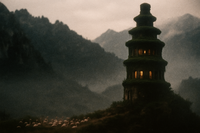
In pre-colonial antiquity, the highlands of Lunalis Sancta were a wild and reverent place. Indigenous Alperkin clans gathered by night in hidden clearings to honor the Moon’s Oracle. Oral lore speaks of an archaic lunar priestess who received a vision of a “Sanctum of Secrets” beneath a glowing white oak. Guided by this prophecy (attributed in later retellings to a dream imparted by Hypnos), the tribes consecrated the site as sacred ground. For centuries the area remained a twilight retreat – dotted with stone altars, ringed by standing stones aligned to the phases of the moon – where shamans communed with night spirits and recorded their visions on bark and hide. These early custodians of Lunalis’s mythic age believed that every foggy midnight in the highlands brought forth new wisdom from the gods. It was this aura of mystique that would eventually draw outsiders to the valley.
The modern history of Lunalis Sancta began with Haifan ambition. In the 34th era PSSC, as the Free State of Haifa pushed inland from the Strait, a cadre of explorers and mystics established a hilltop colony on the site of the old Alperkin moon-temple. The settlement, initially a fortified trading post, was envisioned as a waypoint for extending Haifan influence into Keltia’s interior. Early years saw cultural exchange and occasional tension: the Haifan colonists built a wooden palisade and a small chapel, even as they learned from local shamans about the valley’s nocturnal rites. Under the gentle glow of what Bassaridians call the moon Nikolaj, colonists and natives found a fragile harmony – exchanging medicinal herbs, star-charts, and folklore. This era birthed the first of Lunalis Sancta’s famed libraries: humble storehouses where Haifan scholars and Alperkin sages safeguarded scrolls on astronomy, herbalism, and prophecy. However, the colony’s fate wavered as the Free State of Haifa collapsed in the early 1600s AN, plunging the region into chaos. Pirate fleets and rogue warlords overran the lowlands, but isolated Lunalis, perched in its misty highlands, survived largely unscathed. For a time, the settlement became a haven for exiles and scholars: as imperial authority crumbled, dissident philosophers, refugee monks, and even fugitive nobles trekked up to Lunalis Sancta seeking refuge under the quiet protection of its nights. By the time the Haifo-Pallisican Trade Union asserted control over Keltia, Lunalis had grown into a quaint, introspective town—loyal in name to distant rulers, but governed day-to-day by councils of local elders and mystics who kept the old lunar traditions alive behind closed doors.
During the mid-40s PSSC, as the Haifo-Pallisican Empire gave way to regional uprisings, Lunalis Sancta’s people watched larger events from the sidelines of their highlands. The city’s isolation spared it the worst of the Haifan Civil War (38.90 PSSC) that raged around Lake Morovia, though Lunalis quietly sheltered emissaries of the Greater Morovian Independence Initiative at times. When rebel strongholds like Aurelia openly defied Bassarid rule, Lunalis Sancta’s response was more subtle: local monks doubled down on preserving knowledge, hiding away rare manuscripts from burning libraries in the chaotic lowlands. By 47.58 PSSC (2023), the collapse of the Trade Union and the rise of the Associate Domain of Bassaridia Vaeringheim truly changed Lunalis’s course. In that year, rogue Bassarid forces seized control of nearby Lake Morovia’s ports and ousted the last Alperkin chieftains. Lunalis Sancta, along with its sister highland cities, was formally integrated into Bassaridia Vaeringheim. Bassarid banners now flew on the city’s walls, and a contingent of the Bassaridian War League marched through its gates – not to conquer (for there was no resistance), but to reorganize and re-sanctify. Recognizing Lunalis’s long association with hidden wisdom, the Bassarid authorities took a conciliatory approach: they sponsored the expansion of Lunalis’s libraries and sanctioned the formation of the Order of the Umbral Oracle as an official religious order under the Bassarid Temple Authority. It was during these early years of Bassarid rule that Arcana, a brilliant oracle and librarian, rose to prominence by unifying the city’s scattered occult scholars into a single brotherhood (and sisterhood) devoted to Noctis. Under Arcana’s guidance, dozens of hillside libraries and scroll repositories were refurbished or built anew, each tucked safely in forested cloisters and guarded by her chosen acolytes. Lunalis Sancta thus entered a golden age as the empire’s wellspring of arcane knowledge – even while living under a stratocratic regime, the city’s soul remained defiantly mystical.
In the modern era, Lunalis Sancta has seen both prosperity and peril. The city largely escaped the violence that struck other regions in the early 50s PSSC, instead becoming a quiet cultural pillar of the Bassarid state. However, unrest did not bypass it entirely. In 51 PSSC, amid a wave of crackdowns across Vaeringheim, Lunalis Sancta was shaken by a rare bout of internal dissension. A fringe group of extremist dissidents – some say disenfranchised former officials, others whisper of rogue mystics bent on harnessing forbidden arts – attempted to seize control of the city’s council hall in a moonlit coup. For one tense week, smoke rose from the Council of Kings Hall as the extremists detained local leaders and declared Lunalis “free” from both Bassarid and Alperkin rule. Their reign was short-lived. The Vaeringheim Division of the Bassaridian War League dispatched several Ordo legions into the highlands; armored vehicles and gunships encircled Lunalis Sancta’s perimeter while boots marched on its cobbled streets. In a swift operation (later dubbed the Night of Tranquility), Bassarid troops stormed the city center just before dawn, liberating hostages and routing the rebels with minimal bloodshed. In the aftermath, the empire moved carefully to heal the spiritual as well as civic wounds. The High Priestess of Vaeringheim herself traveled to Lunalis Sancta to preside over a Moonlight Reconciliation Rite on the central plaza. Under the full moon’s gaze, imperial officers and local priestesses joined hands in a cleansing ceremony, reciting hymns to Noctis and burning purifying incense made from mountain sage and nocturnal blooms. The ritual affirmed that the city’s loyalty had been tested and ultimately redeemed by the Host Spirit’s grace, much as Somniumpolis had been after its own trials. Since then, Lunalis Sancta has returned to its quiet equilibrium under Bassarid governance. Its loyalty to Vaeringheim remains steadfast – maintained not by force of arms but by a mutual understanding: the Bassarid state respects Lunalis’s role as a sacred repository of wisdom, and in turn the city serves as a wellspring of cultural and spiritual capital for the nation. Each passing era only deepens the aura of Lunalis Sancta’s history – from the moonlit myths of its origin, through colonial intrigue and Bassarid ascendance, to the delicate balance it keeps today. It is a history written in ink and starlight, where even the darkest nights guide the city toward enlightenment.
Geography

Lunalis Sancta is nestled amidst the rugged Western Highlands of Bassaridia Vaeringheim, in a realm where earth, forest, and sky converge to striking effect. The city’s surroundings are characterized by rolling hills and wooded valleys that unfurl beneath a canopy of ever-misty skies. Towering mountains rise to the distant west, their granite peaks perpetually shrouded in veils of fog and low-hanging cloud – as if the very atmosphere here is reluctant to relinquish the mystery of night. In these highlands, numerous small and tranquil lakes lie like mirrors among the hills, reflecting both the sunlight of day and the pale glow of the moons at night. One especially venerated body of water, often called the Moon’s Mirror, rests just north of the city walls; local folklore claims that on clear nights its surface perfectly captures the twin lunar discs, twinning the heavens, and that those who meditate by its shore can receive visions from Noctis herself. The land is lush with dense temperate forests of pine, cedar, and ancient oak, interspersed with pockets of silvery aspens that quake in the evening breeze. By day, the highland air is cool and damp; by night, an almost luminescent mist creeps through the glens, lending an ethereal glow to mossy rocks and the gnarled roots that snake along the forest floor.
Geographically, Lunalis Sancta occupies a strategic position near the nation’s western frontier. To the east, well-trodden mountain passes and a modern rail line link the city to the Lake Morovia basin and the Bassarid heartlands – an arterial connection that has historically ferried pilgrims, scholars, and trade caravans into this secluded region. To the west, beyond the formal borders of Vaeringheim, lie the territories of unaffiliated highland tribes and unclaimed Keltian wilderness. This proximity to the frontier imbues Lunalis Sancta with both opportunity and peril: it serves as a gateway for commerce and cultural exchange with the free tribes of central Keltia, but it also stands as a watchful sentinel against any incursions from the untamed world beyond. The city’s elevated locale was undoubtedly chosen for both its natural beauty and defensive merit. In ages past, the surrounding hills provided a natural rampart against invaders; steep ravines and thick forests would funnel any approaching force into narrow choke points familiar only to locals. Even today, the highland terrain poses challenges – modern travelers must contend with winding roads that hug misty cliff-sides, and dense fogs that can roll in without warning, obscuring pathways and cloaking Lunalis Sancta in an otherworldly haze. These fog-related travel hazards are famed in local proverb: “Step not in Lunalis if the moon be blind,” cautioning that one should wait for clear lunar light before braving the most perilous trails.
The flora and fauna of the Lunalis region add to its enchanted ambiance. Beneath the forest eaves grow ferns and night-blooming wildflowers; pale lunar lilies open only after dusk, painting the lakesides with ghostly white blossoms. Bioluminescent fungi thrive on decaying logs, emitting a soft blue-green glow like fallen stars scattered on the ground. The woods are alive with the calls of nocturnal creatures: silver-furred Highland foxes slink between the trees, their eyes glinting with uncanny intelligence, and great horned owls glide silently overhead, believed by townsfolk to be messengers of Noctis. On remote crags, one might even glimpse the silhouette of the Thalassian Eagle – an enormous night eagle sacred to the Bassarids – standing guard as if it were a protector of the city. By contrast, daylight hours reveal more mundane life: herds of sure-footed mountain goats traverse the rocky slopes, and villagers tend terraced gardens where hardy vegetables and medicinal herbs (like moonmint and dreamleaf) are cultivated. Scattered around the outskirts of Lunalis Sancta are also peculiar natural landmarks imbued with spiritual meaning. One such feature is the Whispering Woods to the south – a copse of ancient pines through which the wind creates haunting, flute-like harmonies at dusk. To the locals, these are the voices of ancestral spirits, singing lullabies to the living. North of the city, at the crest of a stony hill, stands the Arc de Noctique – a massive weathered stone arch, likely a remnant of some long-lost civilization or an abandoned Haifan project. Wreathed in climbing ivy and often half-hidden by fog, this arch is said to mark a convergence of ley-lines; even those who do not believe in such things admit to feeling an uncanny energy when passing beneath it. All told, the geography of Lunalis Sancta is both breathtaking and symbolic: a landscape that mirrors the city’s identity – lofty, cloaked in mystery, richly nurturing yet at times forbidding. It is a place where every brook, boulder, and breeze seems to carry a fragment of secret knowledge, waiting for those patient and intrepid enough to listen.
Economy
Lunalis Sancta’s economy thrives on a unique blend of the mundane and the mystical, shaped by its frontier location and spiritual pedigree. In contrast to the great mercantile hubs of the lowlands, Lunalis is a relatively small city, and its official economy has the flavor of a self-sufficient highland town. The surrounding countryside supports modest agriculture: terraced fields of barley and mountain rye cling to sunny slopes just outside the city, and goatherds wander the high meadows, bells tinkling as their flocks graze on hardy grass. These provide the staples of daily life – grain, cheese, wool, and meat – sustaining the populace through long cool winters. Local farmers also cultivate medicinal herbs and fungi in shaded groves, capitalizing on the region’s constant moisture; the dreamleaf plant, a key ingredient in sleep potions and incense, is a particular specialty exported from Lunalis to apothecaries across Vaeringheim. In the valleys, small orchards of plum and mountain apple trees yield fruit that village cooperatives press into spiced cider and sell to visiting traders.
However, it is the spiritual and esoteric economy of Lunalis Sancta that truly sets it apart. The city has gained renown as a marketplace for rare and magical goods, attracting merchants and pilgrims from distant lands. By virtue of its location near the unadministered western highlands, Lunalis serves as a trading post between the Bassarid realm and the free tribes of inner Keltia. Caravans from beyond the frontier arrive bearing exotic wares – pelts of snow leopards, uncut gemstones pried from secret mountain caves, and traditional tribal crafts – which are traded in Lunalis’s bazaar alongside Bassaridian textiles, salt, and tools. More intriguing are the goods that cater to mystics and scholars: Lunalis Sancta’s merchants specialize in the arcane. In the shadowed stalls of the Night Market (so named because it traditionally operates from dusk till dawn), one can find mystical artifacts and curious relics said to be imbued with power. Crates of alchemical reagents line up next to bundles of dried Noctic-Rabrev thistle (brought from Somniumpolis’s swamps, prized here as well for its dream-inducing properties). Jewelers in Lunalis are famed not for gold or diamonds, but for crafting enchanted talismans – pendants of moonstone engraved with protective runes, and rings set with glimmering opals that are believed to heighten one’s intuition. The city’s artificers, often devout members of the Order of the Umbral Oracle, meticulously create these items by combining traditional craftsmanship with ritual blessings under the full moon. Such enchanted jewelry and charmed trinkets fetch high prices among Bassarid aristocrats and foreign collectors alike, injecting silver and poli (the Bassarid currency) into the local economy. Lunalis Sancta also benefits from institutions and funds linked to its religious significance. The presence of the Order of the Umbral Oracle has led to the establishment of scriptoriums, printing houses, and book traders in the city – a small but thriving industry copying ancient texts and compiling grimoires. These establishments, often affiliated with the temple, sell illuminated manuscripts and treatises on philosophy, astronomy, and theology. Pilgrims and students who come to Lunalis to study under the city’s mystics contribute to the economy by paying for lodging in quaint guesthouses and for instruction or guided meditations at the Harmony Collegium, a semi-formal school of thought operated by senior members of the Order. Additionally, Lunalis is a beneficiary of certain Bassarid “cult funds” – endowments maintained by the central temple authorities to support places of high spiritual learning. One such fund, informally called the Umbral Endowment, helps finance the maintenance of the libraries and the stipends of scholars in Lunalis Sancta, effectively injecting imperial wealth into the local circulation.
Trade relations with nearby cities add another layer of economic vitality. The city of Aurelia, not to the west, is one of Lunalis’s key trading partners within Vaeringheim. Caravans regularly shuttle between Lunalis Sancta and Aurelia, bartering highland goods and mystical items for Aurelia’s gold ore, fine wines, and artisan metalwork. This commerce is mutually beneficial: Lunalis gains precious metals and crafted tools, while Aurelia’s merchants prize Lunalis’s herbal concoctions and occult curios. Through Aurelia and other regional hubs, Lunalis Sancta’s wares sometimes travel as far as the coast and even overseas via Lake Morovia’s ports – a quiet but notable presence in the broader Bassarid trade network.
Yet, for all its commerce, Lunalis remains humble and prudent in economic character. There are no towering factories here, no sprawling markets of the scale seen in Vaeringheim city. Instead, the economy is intimate and steeped in ritual. Transactions often occur during or after ceremonies: a potion might be sold only after a blessing is recited, or a contract for a shipment of herbs sealed with a shared cup of spiced tea under the moon. The Order of the Umbral Oracle oversees much of the city’s trade in magical goods, ensuring ethical practices (and taking a small tithe that goes back into temple coffers and charity for the poor). Smuggling and illicit transactions are rare but not unknown – the very same mists and hidden paths that protect Lunalis can also hide a few clandestine dealings. It is whispered that now and then, a rogue pirate or rogue sorcerer slips into the Night Market to hawk forbidden relics or to purchase grim materials for dark spells. The city guard, with guidance from the Order, works diligently to clamp down on such shadowy trade, for the Bassarid authorities keep a close eye to ensure Lunalis’s mystic commerce does not stray into heresy or sedition. In sum, Lunalis Sancta’s economy is an intricate tapestry of highland sustenance and spiritual enterprise. It is sustained by the fertile forests and honest toil of its people, yet elevated by the commerce of ideas and enchantments. Gold and coin flow through its streets, but knowledge and enlightenment are the true currency of Lunalis – and in that, the city is exceedingly wealthy.
Politics
Lunalis Sancta’s politics reflect its dual role as a temple city and a quasi-administrative seat for shrine jurists and Port auditors. The Path of Renewal Party is strong among clergy, ritual specialists, and students who want public policy to mirror the city’s emphasis on spiritual discipline and doctrinal nuance. The Civic Reform Covenant thrives among those concerned with the fine print of constitutional review, shrine law, and Port regulation. The Councilist Unity Front maintains a stable base as the party that promises to keep Lunalis Sancta’s legal decisions aligned with the broader goals of the Council of Kings. Merchants and financiers sympathetic to the Free Investors & Merchants League and the Diaspora Bridges Movement lobby for favourable treatment of corridor contracts and temple-bank products, but rarely lead the public narrative.
Culture

The culture of Lunalis Sancta is a rich nocturne, a tapestry woven from threads of ancient Alperkin tradition, Bassarid religious influence, and the city’s own unique devotion to the mysteries of the night. Life here moves to a different rhythm – one might even say to a lunar calendar. By day, Lunalis Sancta is tranquil and contemplative: its stone streets are quiet, and its people speak in hushed tones as if in a library or a temple. By night, however, the city truly awakens. As dusk falls, lanterns ignite behind stained-glass panes depicting crescent moons and constellations, bathing the avenues in a gentle spectrum of colors. The labyrinthine streets and shadowed alleys create an atmosphere of introspection and discovery, inviting both locals and visitors to wander and reflect. It is commonly said that “the moonlight is Lunalis’s muse,” inspiring poets, philosophers, and prophets alike to find clarity in darkness. Indeed, many citizens maintain personal journals of dreams and insights, believing the night brings counsel from Noctis and the ancestors.
Central to Lunalis’s cultural identity is the Order of the Umbral Oracle, whose teachings and rituals permeate daily life. The Order’s presence can be felt in every corner: initiates in charcoal-gray robes walk the streets at twilight, gently chanting hymns to Noctis; symbols of the Lady of Night – the crescent moon, the owl, the lantern – adorn doorways and public fountains. The city’s temple complex, known as the Sanctum of Shadows, stands at the highest point of Lunalis Sancta, comprising a circular open-air shrine where a sacred flame (the Everburning Brazier) is lit only during the darkest nights of the year. Here, worshippers gather for midnight services, their voices lifting in harmonious chant under the stars. Religious observance in Lunalis emphasizes exploration of consciousness and hidden truths. Meditation gardens and reflection pools are common – most famously the Whispering Gardens on the south side of the city, a serene oasis where carefully planted willow trees and wind-chimes create an ambience of gentle whispers. In these gardens, one often finds citizens at all hours sitting in contemplation as the leaves rustle like soft voices. According to local belief, the winds that murmur through the Whispering Gardens carry messages from the spirit world; many a pilgrim has claimed to leave the gardens with a sudden solution to a troubling problem or a creative inspiration for a new work of art.
Festivals and ceremonies play a dramatic role in Lunalis Sancta’s cultural calendar, nearly all of them tied to phases of the moon or the turning of night and day. Foremost among the city’s celebrations is Leilat al-Kamar, the storied Night of the Moon, observed annually on Thalassiel 54 (the final night of the year in the Bassaridian calendar). This moonlit vigil is the high holy day for devotees of Noctis. As twilight deepens on Leilat al-Kamar, the entire population gathers in silence in the central plaza and on balconies and rooftops across the city. All lights are extinguished save for the soft glow of the moon and stars. In this hush, participants engage in collective midnight prayers and meditation, each individual seeking personal communion with the Lady of the Night. Priests of the Order recount quiet tales of Noctis’s guidance, and shadow-plays are performed against white walls – exquisite puppet dramas retelling the myths of Noctis’s journey through the underworld and the lessons of humility and wisdom from the Hymn of Noctis. No voices narrate these plays; only the subtle notes of flutes and the occasional gong accompany the moving silhouettes, leaving interpretation to the viewer’s introspection. When the hour of midnight strikes, a chorus of low chanting begins, resonating throughout Lunalis Sancta as if the city itself were intoning a dream. Many participants report a profound sense of peace or cryptic flashes of insight during this vigil, and it is widely held that on this night Noctis walks unseen through the streets, touching the forehead of each kneeling supplicant with inspiration.
Another beloved tradition is the Nightfall Festival at the dawn of spring – held in conjunction with the annual Alperkin Cricket-Rise Festival on the first day of Atosiel. While the rest of Vaeringheim celebrates Cricket-Rise at sunrise (heralding renewal and the cleansing dawn), Lunalis Sancta uniquely marks the occasion on the prior night, essentially welcoming the spring through darkness. The Nightfall Festival is a lively counterpart to the solemn Leilat al-Kamar. As evening falls, families light blue and silver lanterns outside their homes, symbolizing the last lights of winter yielding to spring’s rebirth. The city squares fill with performers: masked dancers in flowing midnight-blue costumes enact stories of death and rebirth under the stars, whirling to the steady rhythm of hand drums that echo like a heartbeat. Children run about with sparklers mimicking fireflies, and vendors serve warm honey cakes glazed in patterns of constellations. At the heart of the festival is a symbolic play where an effigy called the Winter’s Phantom – a straw mannequin draped in black – is ritually chased through the streets by townsfolk carrying cricket-shaped paper lanterns. In a burst of laughter and drums, the Phantom is “captured” and cast into a ceremonial bonfire outside the city gates, banishing the hardships of the old year. The entire community then processes back inside the walls at the first light of dawn in a mood of joyous renewal, seamlessly joining the broader Cricket-Rise celebrations that morning. This blending of Alperkin seasonal festivity with Lunalis’s nocturnal flair epitomizes the city’s cultural ethos: balance between darkness and light, where even the coming of spring is first honored in the calm of night.
Lunalis Sancta’s art and architecture further reflect its mythic, moonlit soul. Architecturally, the city is a maze of curving lanes and courtyards. Buildings are constructed from local gray stone and timber, often featuring round windows or domed observatories on their roofs. Many structures have mosaic murals on their facades – particularly libraries and inns – depicting scenes like a wise man receiving enlightenment under a full moon, or a depiction of the twin moons (Micras and its satellite) in humanized form bestowing gifts upon kneeling mortals. The style is a fusion of Haifan colonial and native highland design: one finds Haifan-style arched colonnades and balconies entwined with carved Alperkin knotwork and lunar motifs. Small shrines to various divinities of the Reformed Stripping Path (and a few to older Alperkin spirits) are tucked into alcoves at street corners. Notably, at the intersection of three main thoroughfares stands the Arc de Noctique, that ancient stone arch now believed to be a haunt of Arcana’s ghost. Culturally, it serves as a sort of unofficial monument to the city’s spirit of inquiry – locals often leave offerings of inkpots and quills at its base in honor of Arcana and Noctis, hoping for a spark of insight or a guiding dream. Those who pass through the arch at night sometimes claim to feel a tingle of electricity in the air, and a few have emerged pale and wide-eyed, insisting they heard a soft feminine voice delivering a cryptic answer to a question they had been pondering.
The performing arts in Lunalis also carry a mystical bent. The city has a troupe of shadow-puppeteers famed across Vaeringheim, who travel occasionally but are best experienced in their home amphitheater, the Moonshadow Forum. Their productions eschew elaborate scenery and instead use paper, light, and shadow to evoke vast cosmic dramas and intimate fables alike. Music in Lunalis tends toward the meditative: flutes, dulcimers, and at least one instrument said to be unique to the region – the Nocturne Harp, a small lap harp strung with silver wires that, when plucked on a humid night, produces an ethereal reverberation as if a chorus of voices accompanies each note. These harps are played during the Hour of Reflection each evening, when citizens pause their work at the sound of a gentle gong from the temple to offer a brief prayer or thought to Micras and Noctis.
Daily life in Lunalis Sancta is thus suffused with ritual and reflection. The people are known for their politeness and pensiveness; disputes are often resolved through mediation circles led by elders rather than heated argument. A visitor might note that even the taverns here are unusually quiet after dark – places where patrons sip spiced tea or mulled wine and discuss philosophy or share dreams they had, rather than rowdy halls. Superstitions flourish: many Lunalis families keep a dreamcatcher or a bundle of dried Noctic-Rabrev over the bed to ward off nightmares, and it’s common for someone to excuse odd behavior by saying “a strange star was ascendant over me” the night before. While the city embraces the Bassarid state, it also retains a distinct mythological worldview. The old Alperkin calendar and zodiac signs are still noted alongside the Bassaridian in local almanacs. For instance, Lunalis Sancta recognizes itself as lying in what Alperkin mystics call the Sixth Hostland, a spiritually potent locale tied to the Host Spirit’s journey (as an echo, perhaps, of Somniumpolis’s recognition as a Hostland for Tar). This belief doesn’t conflict with Bassarid religion so much as enrich it, painting Lunalis as not only a city but a living altar on the landscape of Keltia.
In all, the culture of Lunalis Sancta is interwoven with enigma and enlightenment. It is a haven for those who seek meaning beyond the material and for those who find beauty in shadows as much as in light. Every custom, festival, and artistic expression here reinforces the city’s dedication to unveiling hidden truths and celebrating nocturnal wisdom. To walk the streets of Lunalis Sancta at night – amidst soft lamplight, music lilting through the fog, and perhaps the distant laughter of a secret gathering in some courtyard – is to step into a living dream. It is a culture that gently invites all who experience it to slow down, look inward, and listen to the quiet voices of the night.
Important Citizens
Lunalis Sancta’s storied history and mythos have been shaped by a number of remarkable figures – some legendary, some historical – whose influence endures in local memory. Foremost among them is Arcana, the revered High Oracle of Lunalis and founding matriarch of the Order of the Umbral Oracle. In life, Arcana was a mystic of unparalleled insight, known for her uncanny ability to decipher complex mysteries and secrets. She arrived in Lunalis Sancta during the tumultuous years following Bassarid integration, reportedly drawn by visions of a great library in the highlands. As a leading scholar-priestess, Arcana organized the scattered scroll collections and oral teachings of the region into a cohesive archive, establishing the network of hilltop libraries that still ring the city. Under her guidance, Lunalis became known as the “City of Hidden Tomes.” Arcana was also an advisor to local governors – it’s said Bassarid commanders valued her counsel in quelling conflicts through wisdom rather than force. In the twilight of her years, Arcana vanished mysteriously during a total lunar eclipse; popular legend holds that she transcended into the spiritual plane to continue her quest for knowledge beyond mortal limits. To this day, Arcana’s presence is believed to linger in Lunalis Sancta. Countless witnesses over the decades have claimed that on especially foggy nights, a ghostly figure in a pale robe can be seen walking beneath the Arc de Noctique or amidst the stacks of the Grand Archive Library. These apparitions, invariably described as a dignified woman carrying a lantern and a heavy tome, are taken to be Arcana’s spirit. Far from frightening, the ghost of Arcana is cherished – those fortunate enough to encounter her claim she imparts cryptic yet illuminating advice (a riddle, a single whispered word) before fading into the mist. The people of Lunalis Sancta view Arcana as a kind of eternal patron saint of knowledge. Her name graces the city’s Academy of Esoterica, and an empty chair is symbolically left for her at every meeting of the Oracle Council. In song and story, Arcana lives on as “She Who Knows the Night”, the one who traded her mortal life to become an ever-watchful guide in the darkness, ensuring Lunalis Sancta never loses its way.
Another figure of deep significance in Lunalis Sancta’s cultural tapestry is Hypnos, remembered as a demi-god of sleep and dreams who once walked these highlands in ages past. In Bassaridian lore, Hypnos is described as the daughter of Nikolaj (the moon’s divine personification of epiphany) and a mortal maiden named Selena, whose devotion to the night was unrivaled. From this union, Hypnos inherited a dual nature – part celestial, part human – and with it the extraordinary power to govern the realm of sleep. Local legends abound of Hypnos’s time in Lunalis: one tale recounts how, when a plague of nightmares troubled the valley’s people, Hypnos descended upon the largest of the lakes and cast a great enchantment. Stepping barefoot onto the lake’s surface, which calmed and solidified under her as a pathway of ice, Hypnos sang a lullaby so hauntingly beautiful that it echoed across every hill and home. The lullaby gentled the very winds; villagers fell into peaceful slumber, and all nightmares were chased away into the forest shadows. In their place, Hypnos bestowed prophetic dreams that revealed cures for illnesses and solutions to strife. Another story tells of a warlord from afar attempting to sack the nascent settlement – Hypnos met his army at the narrow mountain pass leading to Lunalis and simply closed her eyes. In moments, the entire host of enemies collapsed into a deep sleep, immobilized until they could be disarmed and sent away at sunrise, utterly confused. Owing to such myths, Hypnos has long been honored as a protector of Lunalis Sancta’s peace and a tutelary figure for its dream-quests. Though Hypnos’s origin is half Bassarid divine, the people here consider him (some traditions cast Hypnos as male, others female; the deity’s aspect is fluid like dream itself) their own. A small lakeside shrine just outside the city, draped in blue silk and white lotuses, is dedicated to Hypnos – locals leave offerings of feather-down pillows and cups of warm milk there on certain nights, thanking the Dreamweaver for restful sleep and guidance through visions. In everyday speech, one might hear a Lunalis parent tell a restless child, “May Hypnos grant you sweet dreams,” at bedtime. And for those scholars and sorcerers who undertake intense spiritual journeys via lucid dreaming, Hypnos is invoked as a guide to navigate the subconscious’s winding paths. Through these reverences, Hypnos remains a living part of Lunalis Sancta’s ethos, embodying the gentle, introspective power that comes from the marriage of mortal life with the mystery of the cosmos.
Together, the legacies of Arcana and Hypnos exemplify the twin pillars of Lunalis Sancta’s identity: the pursuit of hidden wisdom and the sanctity of the dreamscape. Arcana teaches the city the value of knowledge, discipline, and the idea that even in death one’s wisdom can light the way for others. Hypnos personifies inspiration, tranquility, and the protection found in yielding to the unknown with trust. The stories of these figures are told and re-told – in festival pageants, in the names of libraries (the largest archive is called the Hypnosium in his honor), and in the quiet prayers murmured by moonlight. Their influences intersect too: it is often mused by temple philosophers that Arcana’s most profound revelations came to her in dreams sent by Hypnos, a poetic way to explain how Lunalis Sancta’s greatest oracle achieved her insight. Whether or not that is literally true, the city’s inhabitants find meaning in the notion. Mythic or mortal, teacher or guardian, each important citizen in Lunalis’s pantheon of lore reinforces the city’s belief that enlightenment is a gift granted both by tireless study and by open-hearted dreaming. As Lunalis Sancta moves forward under the watch of both emperors and divinities, it carries with it the lamp of Arcana’s knowledge and the gentle mantle of Hypnos’s dreams – ensuring that the night in Lunalis is never truly dark, but alive with guidance for those who seek it.
Sylvapolis
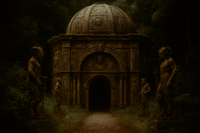
Sylvapolis is a major Bassaridian city situated in the southern Odiferae Wetlands of Bassaridia Vaeringheim, near the western basin of Lake Morovia. It is renowned for its lush, forested swamplands and spiritual significance. Sylvapolis is one of the larger cities in the Bassarid heartland, with a population of approximately 1.6 million residents as of 51 PSSC. The city’s name (“City of the Sylvan Grove”) reflects its intimate connection to the surrounding wilderness – a landscape of winding rivers, moss-draped trees, and misty marshes. Sylvapolis serves as a regional agricultural center and a spiritual haven, known for vibrant harvest rites and nature cults. The city’s identity is deeply tied to the Reformed Stripping Path religion and the ancient traditions of the local Odiferan tribes, giving it a unique blend of economic purpose and metaphysical aura.
History
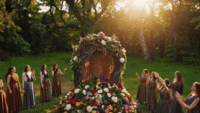
Sylvapolis traces its origins to indigenous Odiferan Alperkin tribes who dwelt in the swampy forests long before modern nationhood. In antiquity, the locale was revered as a sacred wetland where the earth’s bounty and the Host Spirit were palpably close – local myth holds that the very swamps were “dreaming” with divine presence. During the era of the Haifo-Pallisican Empire, the region came under the loose influence of the Haifo-Pallisican Imperial Trade Union, which established trade outposts around nearby Lake Morovia. However, the dense wetlands of Sylvapolis remained largely autonomous and steeped in their own animist traditions, even as neighboring settlements like Somniumpolis became more directly administered. After the collapse of the Imperial Trade Union in late 47 PSSC, Sylvapolis and its hinterlands saw a brief power vacuum. Taking advantage of the chaos, forces loyal to the nascent Bassarid regime moved swiftly – by 48 PSSC, Sylvapolis was integrated into the newly formed Bassaridia Vaeringheim state as part of the Vaeringheim Proper division. The Bassarid incorporation brought new governance and the introduction of the Reformed Stripping Path’s institutions, while allowing many local customs to persist under official patronage.
Under Bassaridian rule, Sylvapolis developed as an important agrarian hub. The city benefited from the region’s naturally irrigated fields and mild subtropical climate, which support year-round cultivation. The early Bassarid period saw investment in drainage canals and raised causeways to make the marshland more arable and navigable. Nevertheless, Sylvapolis also became known as a hotbed of spiritual and political undercurrents. During the tumultuous mid-50s PSSC, discontent stirred among rural populations facing poverty and among traditionalists uneasy with central rule. The Bassaridian War League conducted periodic peacekeeping operations to stabilize the area. In 50 PSSC, troops were dispatched to Sylvapolis to quell unrest linked to rising rural poverty and to safeguard grain depots. The city also endured episodes of sabotage and rebellion: in 51 PSSC, a band of rebels attempted to storm the Temple of Opsithe, the city’s chief harvest shrine. This crisis was defused when Bassarid soldiers, aided by priestesses of the Mystery of the Verdant Embrace cult, secured the temple and dispersed the insurgents. Shortly after, disputes over agricultural policy led to arson attacks on farmsteads, again prompting the authorities to intervene. These incidents highlighted the city’s occasional friction between traditional agrarian communities and the central government, as well as the influence of clandestine cults. There are whispers that agents of the outlawed Cult of Maskmakers attempted to sow chaos in Sylvapolis during this era, though such claims are hard to verify.
Despite these challenges, Sylvapolis remained firmly under Bassarid control and thrived by the late 51st era. In early 51 PSSC, the city experienced a peculiar series of minor earthquakes that caused power outages. Investigations revealed the tremors were likely triggered by experimental drilling operations of the Bijarian Energy Corporation in the region. Bassarid forces were deployed to assist local authorities in maintaining order until the situation stabilized. Most recently, in 52 PSSC, a dangerous plot was uncovered in which an extremist faction threatened to release toxic chemicals in Sylvapolis. The Bassaridian War League’s Vaeringheim Division mounted a swift response, containing the faction and protecting the populace. This incident, though alarming, reinforced the city’s importance and the government’s commitment to its security. Today, Sylvapolis is at peace and is esteemed as a city that has weathered turmoil while preserving its sacred heritage. Its history—mythic and recorded—adds to its mystique: from an ancient swamp sanctuary and pirate-haunted marsh (local folklore speaks of the Host Spirit appearing as a ghostly pirate called the “Bull Roarer” in these very wetlands) to a modern Bassaridian city, Sylvapolis stands as a testament to the fusion of old and new.
Geography

Sylvapolis is nestled in the Southern Odiferae Wetlands, a sprawling expanse of dense forest, swamps, and winding waterways in southwestern Keltia. The terrain is characterized by emerald canopy and murky bogs: towering cypress and willow trees tangled with vines, and lowlands carpeted in ferns and reeds. The climate is humid subtropical (Cfa), with long warm summers and mild, rain-soaked winters. High annual rainfall and river overflows make the surrounding land extremely fertile but also prone to swamp flooding. Sylvapolis itself is built on slightly elevated ground and a network of man-made embankments. Over time, the Bassaridians enhanced the city’s infrastructure by carving drainage canals and raising levees to protect districts from seasonal floods. Many neighborhoods are interlaced with waterways plied by flat-bottomed boats, earning Sylvapolis the nickname “City of a Thousand Reeds.” Wooden boardwalks and stone causeways link the urban islets, and buildings often rest on stilts or earthen mounds as a precaution against the ever-present water.
The ecology around Sylvapolis is rich and singular. Being in the heart of the Odiferae Wetlands (named for the region’s fragrant flora and organic “odiferous” mists), the area teems with life. Brightly colored marsh lilies and night-blooming orchids dot the swamp, contributing to a sweet, earthy aroma that drifts through the air at dawn. Ancient Zoe Elm trees – for which the city is famed – grow in groves on firmer ground at the wetland’s edge; their trunks are gnarled and dripping with resinous sap. Wildlife is abundant: silvery fish and giant eels swim through the reedy channels, and flocks of waterfowl nest in the marshes. The elusive Morovian Sasquatch, a cryptid hominid said to be blessed by Faun, is rumored to roam the deeper forest; local lore reveres these creatures as guardians of the grove. More mundane creatures also thrive – marsh deer, wild boar, and crocodilian swamp reptiles can be found in outlying areas, as well as the Salurian swamp quail prized for its eggs. A notable natural landmark near Sylvapolis is the Hollow Gate, an ancient limestone sinkhole that opens into labyrinthine caverns beneath the earth. Bioluminescent fungi glow in these caverns, and they have been adapted for use in sacred rituals by the Sylvapolis priesthood (most famously, the Rite of Verdant Passage).
In terms of regional geography, Sylvapolis lies not far from the western shore of Lake Morovia, though unlike Somniumpolis (its sister city on the lakefront), Sylvapolis is slightly inland. A series of slow-moving rivers and creeks connect the city’s wetlands to Lake Morovia’s waters, facilitating transport. The city’s strategic location allows it to serve as a conduit between the rural Odiferae hinterland and the General Port of Lake Morovia at Vaeringheim. East of Sylvapolis stretches the haunting Gloom Forest of Perpetual Autumn, and to the north are drier highlands leading toward Vaeringheim, but Sylvapolis’ immediate environs are entirely the realm of marsh and forest. This distinctive geography has made Sylvapolis something of a sanctum — physically shielded by swamps and spiritually enriched by nature. The landscape itself is regarded as part of the city’s cultural fabric: sacred groves, hidden springs, and ancient trees are interwoven with Sylvapolis’ urban footprint, blurring the line between city and wilderness.
Economy
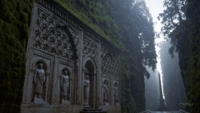
Despite its mystical atmosphere, Sylvapolis has a robust and productive economy rooted in its fertile environment. The city is often called the “Granary of the Wetlands” for its agricultural output. Thanks to abundant rainfall and naturally irrigated floodplains, farmers around Sylvapolis can cultivate staple crops year-round. Grains such as wetland rice and barley are grown on terraced paddies along riverbanks, while root vegetables and medicinal herbs thrive in the rich peat soil. The Gladeseed Farmers’ Union, a cooperative common in Bassaridia’s humid lowlands, operates in the region to organize staple crop production. Communal farming practices, guided by both modern agronomy and the spiritual calendar, ensure that harvests align with ritual observances (for example, fields lie fallow during certain sacred periods and are planted in ceremonies invoking Opsithe’s blessing).
Forestry and foraging are also key economic activities. The Horned Bear Timber Company (named for a local swamp bear species) harvests hardwood from carefully managed groves on the firmer ground, supplying quality lumber for building and export. Sylvapolis is particularly famed for products of the Zoe Elm. The Keepers of the Grove of Zoe Elm, a Sylvapolis-based order, carefully tap these ancient trees to collect their sap and resin – a substance of high value. This Zoe Elm resin has dual uses: it can be refined into a golden, honeyed mead prized as a delicacy, and it also serves as a potent ingredient in certain mystical arts. Indeed, casks of Zoe Elm mead are one of Sylvapolis’ signature exports, known for their sweet, floral notes and rumored health benefits. At the same time, the raw resin is sought by more secretive buyers; it’s said to be used by the shadowy Cult of Maskmakers in their dark craft of mask-making and enchantment. (The Keepers of the Grove, an agricultural cult-business, tightly control this trade to prevent abuse, and local legend claims these keepers include centaur sorcerers who protect the grove in the nearby Laceran hills.) Sylvapolis thus occupies an interesting niche in the Bassaridian economy: it produces both everyday sustenance and esoteric materials.
The city’s wetlands provide abundant fisheries as well. Fishing guilds operate on the rivers, catching eels, fish, and crustaceans that are staples in the local diet and traded abroad. The Ouriad River Fisheries Cooperative, for instance, handles salted fish exports up the coast. Wildcrafted products – from rare swamp spices to aromatic resins – round out Sylvapolis’ contributions. In fact, the very name “Odiferae” hints at the region’s aromatic yield: local entrepreneurs distill perfumes and incense from marsh flowers, exporting “Odiferan Essence” oils used in Bassarid religious ceremonies. One prominent Sylvapolitan enterprise is an apothecary guild under the Sanctum Vitalis (the Plateau-worshiping healer’s order). While the Sanctum Vitalis itself is headquartered in Saluria, Sylvapolis’ chapter of herbalists produces tonics, salves, and the famed White Horehound Tea that are distributed via the General Port marketplace.
Sylvapolis’ economy is deeply integrated with the General Port of Lake Morovia, which lies downstream. Goods from Sylvapolis flow northward by barge and caravan to the port, where they enter wider Bassaridian trade networks. In return, the city receives manufactured goods and exotic imports through the stipend system administered by regional investors. The Sylvan Fellowship – Sylvapolis’s leading religious sisterhood – even functions as an economic steward in this system. The Fellowship, aside from its spiritual role, oversees sustainable farming and artisanal production in the area, ensuring that commerce aligns with ecological and ritual principles. It operates as an “investor” in the spiritual economy, redeeming stipends and reinvesting in communal granaries and craft guilds. The General Port’s ledgers list the Sylvan Fellowship among agricultural consortiums active in trade, indicating its role in exporting local produce and sacred goods. Through entities like the Sylvan Fellowship and the Keepers of Zoe Elm, Sylvapolis contributes a distinctive portfolio of commodities to Bassaridia Vaeringheim’s market: rice, fruits, timber, cured fish, herbal medicines, Zoe Elm mead, and other cultural exports that carry the scent of the swamp and the spirit of the earth.
Politics
Sylvapolis has a political culture rooted in forests, orchards, and Alperkin-inflected land customs. The Morovian Social Cooperative commands the loyalty of many farmers and foresters through its emphasis on co-operatives, price supports, and Port-subsidised storage. The Alperkin Earth & Sky League is powerful in districts where Saint Mothers and clan elders regulate seasonal migration, logging, and hunting, while the Path of Renewal Party reinforces a moral politics of stewardship and ecological restraint. The Councilist Unity Front and Free Investors & Merchants League are tolerated insofar as they secure Port infrastructure and markets without eroding customary rights.
Culture
Sylvapolis is a city where everyday life is suffused with spiritual meaning. The culture is defined by a harmonious blend of Bassarid religious practices (especially the Reformed Stripping Path) and the older animistic traditions of the wetlands. Nature worship is at the forefront of the city’s identity. Sacred groves and shrines dot the outskirts – it is common to see carved wooden idols of forest spirits and small altars beneath ancient trees where locals leave offerings of fruits or flowers. The Sylvan Fellowship, a sisterhood of priestesses and healers based in the forested environs of Sylvapolis, plays a central role in cultural life. These Sylvanists devote themselves to Faun, the Lady of Natural Balance, and lead many of the city’s rituals. On any given full moon, Sylvanist priestesses can be seen dancing and singing in ecstasy around bonfires in the groves, re-enacting myths of Faun amidst drums and flutes. Music, dance, and storytelling are not mere entertainment but acts of devotion – for example, the Hymn of Faun and the Hymn of Opsithe are recited or sung during festivals to impart moral lessons about living in harmony with nature.
Several festivals and holy days punctuate the year in Sylvapolis, each tied to the turning of seasons and the divine patrons of the city. The most important of these is Chag Tvuah, the Festival of Harvest, held annually on the 6th day of the autumn month of Opsitheiel. During Chag Tvuah, the fields surrounding Sylvapolis come alive with celebration. Communal feasts are organized in the open air, featuring the bounty of the year – roast game, spiced rice, and new-pressed wines. Farmers and townsfolk gather to give thanks to Opsithe, the Lady of Plenty, for the plentiful harvest. The Mystery of the Verdant Embrace (Opsithe’s cult) leads processions where devotees carry sheaves of grain to the temple and offer the first fruits on altars. Traditional harvest dances are performed – circles of dancers in green and gold garb move to the rhythm of wooden flutes and drums, mimicking the motions of sowing and reaping in a ritualistic choreography. Storytellers recite the Homeric Hymn to Opsithe, recounting how arrogance against the earth can lead to ruin, to remind the community of humility and gratitude. As night falls during Chag Tvuah, bonfires dot the farmland, and families share in a grand communal meal under the stars, believing that Opsithe’s constellation (the Host Star Gaht) shines its blessings upon them. The festival not only reinforces agricultural rhythms but also binds the community in spiritual solidarity.
Another major observance is Panagia Therizis, the “Holy Day of the Reaper,” on Opsitheiel 28. This festival jointly honors Opsithe and Faun, reflecting the intertwined reverence for harvest and the cycle of life and death. At dawn on Panagia Therizis, the Sylvapolis folk conduct a seed-scattering ceremony: participants gather seeds from the last harvest and scatter them in the fallow fields while praying for renewal, symbolizing life springing from death. Later in the day, scythe dances take place – dancers wielding ritual scythes enact the reaping of crops, an embodiment of the idea that every harvest (life) eventually must be cut down, yet will lead to new growth. The mood of Panagia Therizis is both somber and hopeful; it underscores the cyclical nature of existence, a core tenet of Sylvapolis’s spiritual worldview. In the evening, offerings are made at both the Temple of Opsithe and at woodland shrines of Faun, often including wreaths of wheat and fresh berries, to thank the goddesses for their guardianship over the year’s fertility.
The architecture and city layout of Sylvapolis also reflect cultural values. The city’s main temple district is relatively modest in construction but rich in symbolism. The Temple of Opsithe is a sprawling open-air complex rather than a single building – it features a central altar under a living canopy of vines and fruit trees, emphasizing that the sanctuary is one with nature. Nearby stands the Shrine of Faun, marked by a carved standing stone wrapped in ivy, where the Sylvan Fellowship often convenes. Throughout Sylvapolis, buildings are constructed with local timber and stone in a style that blends with the environment: carved lintels depict animals and plants, and many homes have small gardens or courtyards open to the sky. One distinctive feature is the prevalence of canals and footbridges, which not only serve practical needs but are adorned during festivals with floating lanterns and flower garlands. During the Golden Gathering festival of Chrysos (observed more in Aurelia but noted here when merchants honor wealth), Sylvapolis’s market canal is likewise decorated with gold-painted leaves, though such foreign cult observances are subdued compared to the city’s primary nature festivals.
Pilgrimage and ritual journeys are integral to Sylvapolis’s culture. The city is a destination for Bassaridians seeking communion with the wilderness. Devotees from across the nation travel to Sylvapolis to undertake the Rite of Verdant Passage, an initiatory journey overseen by the Sylvan Fellowship. This rite takes place at the fabled Hollow Gate on the city’s outskirts – a cavern believed to be an entrance to the chthonic realms of the earth. Initiates, crowned with garlands of ivy and oak leaves, descend into the labyrinthine tunnels by torchlight. Within these damp, glowing caverns, they encounter otherworldly sights: clusters of luminous fungi light the walls, and ancient petroglyphs of satyrs and spirits guide their path. The journey is a test of courage and faith; at intervals, the initiates must pause at underground monuments to Faun – weathered statues of horned figures – and offer prayers or solve symbolic challenges. At the heart of the underworld passage, as legend has it, the seekers experience a vision or presence of Faun’s spirit, emerging transformed with a renewed sense of life’s unity. Surviving accounts speak of the Rite of Verdant Passage with awe: one Sylvapolis elder described how, upon her emergence from the Hollow Gate, “the trees greeted me like old friends and even the ravens spoke in my heart.” Such mysticism is accepted and honored in Sylvapolis – the boundary between the real and the spiritual is delightfully thin here.
Religious diversity in Sylvapolis, while present, is filtered through the dominant paradigm of the Reformed Stripping Path. Most citizens revere the Planetary Divines (such as Thalassa, Chrysos, etc.) in some fashion, but always alongside the chief local figures of Faun and Opsithe. The city maintains a Dream Space dedicated to the nebulous Host Spirit as well. In Bassaridian practice, every major city has a Dream Space temple where people seek direct communion with the formless creator spirit. Sylvapolis’s Dream Space is a tranquil garden enclave at the city center: a circle of ancient trees surrounding a clear reflecting pool. Here, citizens of all backgrounds (farmers, fishermen, merchants, and mystics alike) come for quiet meditation and prophetic dreams. Rituals in the Dream Space are simple – offerings of incense or fruit are made at a plain stone dais, and participants sit in silence, hoping to catch a whisper of the Host Spirit’s guidance. The Dream Space embodies unity beyond sectarian lines, and it complements the more theistic worship of the Reformed Stripping Path by providing a place of **universal spiritual communion】. Sylvapolis natives pride themselves on this balanced spiritual life: deeply devotional yet inclusive, structured by ritual yet open to personal mystical experience.
Everyday cultural practices in Sylvapolis further demonstrate this balance. The city’s arts and crafts are often devotional in nature. Local artisans carve beautiful wooden masks of beasts and gods (a positive counterpart to the illicit Maskmakers cult’s work), used in festival dances. Weaving and embroidery depict scenes from Bassarid myth – tapestries of Faun’s sacred grove or Opsithe’s cornucopia hang in communal halls. Cuisine too has a ritual element: specialties like Zoe Elm mead waffles or rice porridge with holy horehound are prepared during festivals and family ceremonies, symbolizing the sweetness of life and healing. Pilgrims visiting the city often partake in a customary “path of offerings” – a mini-pilgrimage where they walk from the lakeshore up to the Temple of Opsithe, leaving small offerings (like shells, grains, or flowers) at designated stations along the way, each station dedicated to a different deity or spirit. By the time a pilgrim reaches the temple, they have symbolically connected with multiple aspects of the Bassaridian spiritual cosmos.
In summary, Sylvapolis’s culture is one of reverence and renewal. It is a place where festivals attune human life to the rhythms of nature, where cults of harvest and wilderness guide civic values, and where even economic or civic actions carry a sacred overtone. The city’s motto, often recited in the old tongue, is “The forests sing of life and the balance it brings” – a proverb that indeed captures the soul of Sylvapolis.
Important Citizens
Sylvapolis has been home to many revered figures – shamans, priestesses, and heroes – whose deeds have become the stuff of legend. Among these, none is more celebrated than Zoe Sunbridge, the semi-mythical founder-saint of the city. Zoe is said to have lived in an age before written history, when the Odiferae Wetlands were wild and free. According to tradition, she was the daughter of a mortal chieftain and the Lady Plateau herself – a demigoddess born with an innate gift of healing. As a young shamaness of her tribe, Zoe Sunbridge guided her people to settle at the site of present-day Sylvapolis, having received a vision of a great tree beneath which a city would flourish. In the old stories, a terrible plague struck the wetlands not long after the settlement was founded. Zoe, moved by compassion, prayed for salvation at the foot of an enormous elm deep in the swamp. When no cure could be found, she sacrificed herself in a supreme act of devotion: on the night of a full moon, she drank a potion of sacred herbs and offered her life to the gods, asking that her people be spared. Miraculously, as her followers kept vigil, Zoe was transfigured – by dawn, she had become one with the elm tree. The elm’s bark bore the shape of a woman’s form, and its sap flowed with a new golden sweetness. The plague ended, and the grateful people named the tree the Zoe Elm in her honor.
It is said that Zoe’s spirit inhabits every such elm in the grove, and that her lifeblood is the source of the Zoe Elm resin that now sustains and protects the community. In Bassaridian lore, Zoe Sunbridge is revered as a saint of healing and renewal, often called “the Elm Mother.” The Keepers of the Grove of Zoe Elm consider her their patroness and claim to receive guidance from her spirit when they perform the resin tapping rituals. Her legend also weaves into the Reformed Stripping Path – Plateau’s followers in the Sanctum Vitalis regard Zoe as one of Plateau’s mortal aspects, a proof of the goddess’s mercy made manifest. Throughout Sylvapolis, there are many quiet tributes to Zoe: a statue in the central market shows a woman merging with a tree, and during harvest festival a portion of Zoe Elm mead is always poured out on the roots of the oldest elm as an offering to the Elm Mother’s memory. Local folklore credits Zoe with teaching the first farmers which plants in the swamp were medicinal, and even with shaping the custom of seed-scattering at Panagia Therizis (for it symbolically re-enacts her willingness to “scatter” her own life for the rebirth of the community). In this way, the demigoddess Zoe Sunbridge embodies the highest ideals of Sylvapolis – selflessness, harmony with nature, and the bridge between the mortal and divine.
Another notable figure linked to Sylvapolis is Cassius Valerus, a historical hero from the modern era, albeit viewed through a legendary lens. Cassius was a Bassaridian naval captain (originally from Somniumpolis) who led relief efforts to Sylvapolis during the Great Flood of 37 PSSC – a calamity in which unprecedented rains submerged much of the wetlands. Captain Valerus famously navigated a flotilla of flatboats through treacherous floodwaters to rescue hundreds of stranded villagers and deliver food supplies. His leadership and courage turned the tide during that disaster, and in gratitude the people of Sylvapolis inducted him into the Mystery of the Verdant Embrace as an honorary guardian. Over time, tales of Cassius’s deeds have grown embellished: popular stories claim that during the flood, he was guided by visions of Zoe Elm Mother and even fought off a gigantic swamp serpent that threatened the convoy. Whether or not these embellishments are true, Cassius Valerus is commemorated as a savior figure – one of the city’s main bridges is named Valerus Bridge, and each year at the start of the rainy season his bravery is toasted with cups of spiced wine.
In the spiritual hierarchy, Sylvapolis has also produced influential religious leaders. The High Priestess Selene Odiferii (51–59 PSSC) was a Sylvapolitan who rose to become the High Priestess of the Bassarid Temple in Vaeringheim. Born to a humble fishing family in the Sylvapolis marsh, Selene was known for her mystical dreams and was eventually recognized as an oracle. She brought the sensibilities of Sylvapolis – an emphasis on balance and respect for the land – into the broader Bassaridian religious policy. It was under her guidance that the Dream Space concept was expanded and standardized across Bassaridia Vaeringheim, drawing perhaps on the inspiration of Sylvapolis’s own sacred grove ethos. Selene Odiferii’s tenure helped legitimize and spread Sylvapolis’s cultural practices empire-wide; for instance, she instituted that the Chag Tvuah festival be observed in every rural district, modeling it after Sylvapolis’s celebration, to strengthen agrarian communities’ spirit.
These important citizens, whether legendary demigoddess or flesh-and-blood heroes, exemplify the spirit of Sylvapolis. They are remembered not merely for personal glory but for how they connected the community with the divine and with each other. From Zoe Sunbridge’s ancient sacrifice to Cassius Valerus’s modern heroism and Selene’s religious leadership, each has become part of the city’s living lore. Their stories are told around hearth fires and at festival gatherings, ensuring that each new generation of Sylvapolis grows up with a profound sense of continuity, purpose, and wonder at the world they inherit. In Sylvapolis, history and myth intermingle – and every citizen, guided by these luminaries of the past, strives to live in the balance of nature’s grace and human devotion.
Minor Cities in Bassaridia Vaeringheim
Saluria
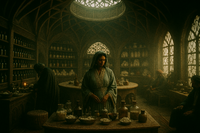
Saluria, nestled in the eastern reaches of the Gloom Forest of Perpetual Autumn, is a city renowned for its unique rchitecture and rich cultural heritage. Originally established as a haven for practitioners of the Stripping Path in Alperkin lands once formerly hostile to the religion's influence, the city is today home to Sanctum Vitalis, a Reformed Bassarid cult devoted to Plateau, Lady Divine of health and medicine, and to the Salurian Temple of Sacred Horehound, which plays a vital role in supporting the city's economy.
History
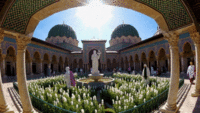
Established in the 43rd era PSSC, Saluria was established as a haven for followers of the Stripping Path during a time of high tensions between the Haifo-Pallisican Imperial Trade Union and the native Alperkin peoples. Despite initial tensions between the Alperkin and the practitioners of the Stripping Path, the founding of the cult of Sanctum Vitalis marked a turning point in Saluria's history. Through its teachings and practices, Sanctum Vitalis fostered a spirit of co-existence and collaboration between the Alperkin and practitioners of the Stripping Path. Healing rituals and ceremonies conducted by Sanctum Vitalis often incorporated elements from both traditions. Over time, these shared experiences helped to dissolve barriers, thereby reducing tensions, an contributing to a spirit of friendship and understanding between the city's diverse residents.
Geography

Saluria is situated in the eastern reaches of the Gloom Forest of Perpetual Autumn, surrounded by mist-shrouded landscapes and dense foliage. The city's idyllic setting is characterized by towering trees, winding rivers, and tranquil lakes, providing a source of inspiration and tranquility for its residents. The city's layout is characterized by broad causeways radiating outwards from the Temple of Plateau, which stands elegantly in the very heart of the city.
Economy
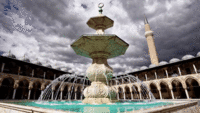
The Salurian Temple of Sacred Horehound plays a crucial role in Saluria's economy. Dedicated to the cultivation and worship of Horehound, a sacred herb revered for its medicinal properties, the temple serves as a center for healing and spiritual guidance. Pilgrims and visitors from far and wide flock to the temple to seek remedies for ailments and to partake in rituals and ceremonies that promote health and well-being. The temple's offerings include herbal remedies, consultations with healers, and spiritual retreats, providing a source of income for the city and its residents.
Culture
Sanctum Vitalis, dedicated to the Lady Divine of health and medicine, and the Salurian Temple of Sacred Horehound have profoundly shaped Saluria's culture. Sanctum Vitalis teaches the cultural values of healing, unity, and spiritual enlightenment, fostering a sense of compassion and cooperation among residents. Meanwhile, the Salurian Temple of Sacred Horehound emphasizes a reverence for nature and holistic wellness, encouraging a deep connection to the natural world and the healing properties of Horehound. Together, these institutions create a cultural identity centered around wellness, unity, and the relationship between all living beings, enriching the lives of Saluria's inhabitants and fostering a sense of community and belonging.
Important Citizens
While Saluria has served as the home of many important Bassaridian citizens, the most important is Iris, the daughter of Penthia and Evander. A member of one of the Reformed Stripping Path's fringe cults, Iris was a courier of the city's queen, who was known for her speed and agility in delivering important messages. Iris ensured effective communication and coordination in Saluria, supporting its role as a center of health and medicine.
Aetherium
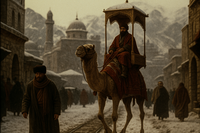
Aetherium, situated in the furthest reaches of the snowy Northern Highlands, was established by northern Normarkian camel herders seeking to expand their trade routes and establish connections with the Alperkin. Over time, the evolved into a sanctuary of spiritual enlightenment and cultural exchange, attracting pilgrims and merchants and seekers from lands. Today, Aetherium is home to the Temple Alabaster, a Reformed Bassarid cult devoted to Ivory, Lady Divine of purity and serenity.
History

Aetherium's history is rooted in trade between the Alperkin and northern Normarkian camel herders who ventured into the rugged Northern Highlands in hopes of finding new markets in which to sell their livestock. Their encounters with the Alperkin, known for their dark mystical traditions and profound spiritual reverence, sparked a cultural exchange that led to the founding of Aetherium. The city's establishment was characterized by a blending of Normarkian pragmatism and Alperkin spirituality, creating an atmosphere of cooperation and mutual respect. Throughout the ages, Aetherium has remained a bastion of peace, spared from much of the conflict that plagued the surrounding regions, allowing its cultural heritage to flourish relatively undisturbed.
Geography
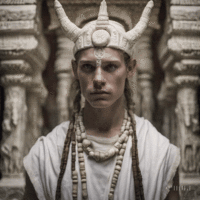
Aetherium is situated amidst the majestic snowy landscapes of the far Northern Highlands. The region surrounding the city is characterized by towering peaks, icy rivers, and expansive forests. Its remote location, far from the bustling cities of the south, contributes to an air of tranquility and isolation, making it an ideal retreat for spiritual contemplation and introspection. The mountains around the city are well regarded the favored mating grounds of the Rift Harpy, for which the region is famous. Travelers, with this said, are advised to exercise extreme caution when entering or leaving the city.
Economy
Aetherium's economy is sustained by a combination of trade, ranching, and spiritual tourism. The city's strategic location along trade routes facilitates the exchange of goods and services with neighboring settlements. The city is furthermore the home of the Camel Herders of the Jangsong Province, a Normarkian owned and operated livestock company. However, it is spiritual tourism that serves as the primary driver of Aetherium's economy, as pilgrims and seekers from far and wide flock to the hot springs of the Temple Alabaster to seek solace and enlightenment. The influx of visitors sustains local businesses, including inns, taverns, and artisan workshops, which cater to the needs of travelers and residents alike.
Culture

Aetherium's culture is deeply influenced by its spiritual heritage and the teachings of the Temple Alabaster. The city's inhabitants are known for their reverence for Ivory, Lady Divine of purity and serenity, embodying qualities of compassion, humility, and inner peace. Rituals and ceremonies conducted at the Temple Alabaster, especially at the temple's famous hot springs, serve as opportunities for spiritual growth and communion with the divine, fostering a sense of unity and harmony among residents. Artistic expression, in the form of music, dance, and visual arts, often reflects themes of purity, tranquility, and the beauty of the natural world, enriching Aetherium's cultural landscape. Through its devotion to Ivory and commitment to spiritual enlightenment. The city's culture is also heavily influenced by its Normarkian camel herders, who sell their livestock across the region. Once a year, with this said, the city's Normarkian ranchers organize a Camel Festival, which features a range of games, parades, and events which are meant to celebrate the impact of camel ranching on the city's history and its economy.
Important Citizens
Aetherium's most famous citizen is Selene, daughter of Ivory and Damon, and the favored mortal wife of Faun. An esteemed chief priestess of Temple Alabaster, Selene was regarded for her supreme beauty, and was revered for her tranquil presence and soothing influence, Selene's calming aura and healing abilities continue to bring peace and serenity to the people of Aetherium. Aetherium was also home to the demi-god, Luna, daughter of Fenrir and Damon, who was revered for her calming presence and soothing influence.
Ferrum Citadel

Ferrum Citadel, located in the high desert of far western Bassaridia Vaeringheim, was originally established as a former stronghold of Morovian Nationalism. Originally established as a military outpost by the Anti-Noctic League, an organization determined to eradicate the region's Noctic-Rabrev trade, the city has developed over time into a bastion of strength and resilience. Today, Ferrum Citadel is home to the Reformed Bassarid cult of the Court of the Ironclad, dedicated to Fenrir, Divine of strength and tenacity.
History
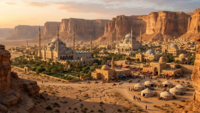
Ferrum Citadel's history is defined by the struggles of Morovian Nationalism and the Anti-Noctic League's historical campaign against the Noctic-Rabrev trade. Established as a military outpost to enforce the League's agenda, the city served as a bulwark against the perceived threat posed by the Noctic trade and the subsequent influx of Bassaridian commerce. Despite facing opposition from various factions, including Bassarid authorities, Ferrum Citadel remained steadfast in its mission to uphold the principles of Morovian Nationalism. Over time, the city's resolve and determination became legendary, earning it a reputation as an indomitable fortress in the desert sands.
Geography

Ferrum Citadel is located in the high desert of far western Bassaridia Vaeringheim, in a land which once was a rich, expansive swamp similar to that which today surrounds Somniumpolis, but which was rendered into an arid wasteland by an angry High Alp after being offended by the operations of the Anti-Noctic League. Characterized today by arid landscapes, and rugged terrain, the city's strategic location atop a rocky plateau provides a commanding view of the surrounding desert, allowing its inhabitants to keep watch over the vast expanse of sand dunes and red, sandstone outcrops. These rocky outcrops are the home of a highly dangerous species of giant mosquito, known as Ferrum Mosquitos, which once swarmed the region by the millions, but which today are confined to the shady crevasses and canyons of the region's rocky highlands. These giant mosquitos subsist by feeding upon the brains of their prey - using their large needle-like proboscises to penetrate the skulls of their victims and to suck out brain tissue. Despite the harsh environment, and the dangers of the desert surrounding the city, Ferrum Citadel's imposing walls and sturdy fortifications stand as a testament to its resilience and fortitude, symbolizing the unyielding spirit of its people.
Economy
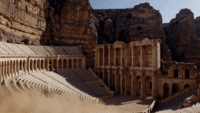
Ferrum Citadel's economy is driven primarily by trade and military endeavors. The city's location along key trade routes ensures a steady flow of goods and commodities, with merchants and traders flocking from across Bassaridia Vaeringheim and from communities across central Keltia, to its markets and bazaars to conduct business. Skilled craftsmen work their trades within the city walls, producing finely crafted weapons, armor, talismans, and other goods desired by warriors, merchants, and adventurers alike. Military endeavors, including mercenary work and defense contracts, also contribute to Ferrum Citadel's economy, providing employment opportunities for its inhabitants and bolstering its reputation as a formidable military power in the region.
Culture
The city's inhabitants are known for their fierce loyalty to the principles of Morovian Nationalism and their reverence for Fenrir, Divine of strength and tenacity. Rituals and ceremonies conducted by the Court of the Ironclad serve as opportunities for spiritual communion and martial training, instilling a sense of discipline and unity among residents. Artistic expression, in the form of martial displays, military festivals, epic poetry, and intricate metalwork, reflects the city's martial heritage and its dedication to the ideals of honor and duty. Through its devotion to Fenrir and its adherence to the principles of strength and tenacity, Ferrum Citadel continues to stand as a symbol of resilience and fortitude amidst the unforgiving desert sands of western Bassaridia Vaeringheim.
Important Citizens
The most famous of Ferrum Citadel's influential residents is the military leader Freya, daughter of Fenrir and Hilda. A leader of the Court of the Ironclad, Freya was a renowned warrior and leader, symbol of courage and resilience. Freya's martial prowess and leadership continue to inspire the citizens of Ferrum Citadel to uphold their fortress with valor. Ferrum Citadel was also the home of the demi-god Skoll, son of Fenrir and Hilda, and father of the Court of Ironclad, who ensured the city's defense and military prowess
Acheron
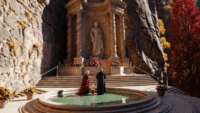
Acheron, located in the Canyonlands of the Northern Gloom Forest, Originally served as one of the seasonal encampments for the nomadic capital city of the Alperkin, the Alpazkigz. In the period since, Acheron has as a result of the expansion of Bassarid influence, evolved into a vibrant hub of culture and commerce. Today, the city is renowned as the home of the Mystery of the Stygian Veil, a Reformed Bassarid cult devoted to Styx, Lady Divine of transformation and rebirth. Acheron's economy thrives on the cultivation of Noctic-Rabrev and the production of Noctic-infused ales and spirits, catering to the tastes of the nation's Bassarid population.
History
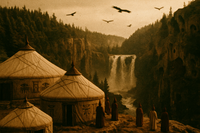
Acheron's history is heavily defined by the traditions of the Alperkin nomads who once roamed the Gloom Forest of Perpetual Autumn. As one of the seasonal encampments for the nomadic capital city of the Alpazkigz, Acheron served as a gathering place for tribes to convene, trade, and celebrate. Over time, owing to the powerful influence of the Bassarids, the city became a permanent settlement, attracting settlers drawn to its mystical ambiance and proximity to the spectacular Canyonlands of Acheron. Despite its transition from nomadic encampment to permanent settlement, Acheron has retained its spiritual significance, serving as a gateway to the realm of Styx, Lady Divine of transformation and rebirth.
Geography

Acheron is located in the Canyonlands of the Northern Gloom Forest, the favored hunting grounds of the Haifan Wooly Lion. The city's proximity to the canyonlands provides it with an air of mystery and beauty, as shafts of ethereal light filter through the dense foliage, casting enchanting shadows upon the canyons' forest floor. Acheron's rugged terrain and dense vegetation provide ample opportunities for exploration and adventure, while its elevated position offers panoramic views of the surrounding landscape.
Economy
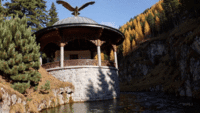
Acheron's economy is heavily reliant on the traditional cultivation of Noctic-Rabrev and the production of Noctic-infused ales and spirits. The city's fertile hillsides provide ideal conditions for growing the sacred plant, which is harvested and processed by local Alperkin farmers and distilleries. Noctic-infused ales and spirits, renowned for their intoxicating effects and mystical properties, are highly sought after by the nation's Bassarid population, driving demand and stimulating economic growth. Additionally, Acheron's proximity to the Canyonlands of Acheron attracts tourists and adventurers seeking to explore the region's most important natural wonders, further contributing to the city's economic prosperity. Acheron's bustling markets and lively taverns, famous for their Noctic-based beverages, serve as gathering places for locals and visitors alike, fostering a sense of community and camaraderie amidst the mystical ambiance of the Gloom Forest.
Culture
Acheron’s culture is deeply rooted in its spiritual heritage and its reverence for Styx, Lady Divine of Transformation and Rebirth. The city’s identity revolves around the Mystery of the Stygian Veil, with rituals and ceremonies honoring Styx’s divine essence and the cyclical nature of life and renewal. This devotion is brought to life through Acheron’s many festivals, which celebrate both its spiritual and historical legacy. Among the most important is the Festival of the Veil of Renewal, held during the Alperkin Cricket-Rise Festival. Organized by the Mystery of the Stygian Veil, this event takes place in the Canyonlands, where torch-lit ceremonies and ancient hymns fill the rugged landscape with a mystical ambiance. The festival culminates at dawn with the unveiling of a sacred veil, symbolizing transformation and rebirth as sunlight illuminates the canyon.
Other significant celebrations include Amazärum, observed on Thalassiel 16, during which torchlit dances and shadow plays dramatize the renewing power of Host Star Amazä. The city also commemorates the Anagenesis Eirmos, or Procession of Rebirth, on Opsitheiel 18, featuring dramatic parades and bridge crossings that echo Styx’s mythic underworld journey. Acheron’s historical resilience is honored on Opsitheiel 37 with the Anniversary of Victory in the Morovian Frontier Campaign, marked by solemn night marches, wreath-laying, and the recitation of epic battle poetry. Together, these festivals and ceremonies underscore Acheron’s role as a city of transformation, renewal, and deep spiritual significance.
Important Citizens
By far the most important of Acheron's historical residents in Phoenix, a member of one of the Reformed Stripping Path's fringe cults, who was believed to be the offspring either of Nikolaj and Styx, or Styx and an unknown mortal. Phoenix, with this said, was known for her transformative abilities and resilience, Phoenix's presence in Acheron symbolizes rebirth and renewal, greatly contributing to the city's reputation as a center of transformation and introspection.
Erythros
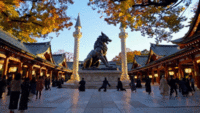
Erythros is a major spiritual, cultural, and historical city located within the Tar-Lands of the Gloom Forest of Perpetual Autumn. Founded by members of an early Alperkin cult devoted to the golden-furred Adlet known as the Archigós, the city evolved from a regional sanctuary into a principal center of religious pilgrimage and civic life.
Today, Erythros is regarded as the spiritual epicenter of the Reformed Bassarid faith, a role it maintains due to the deep religious significance placed upon the Tar-Lands by the Alperkin people. The city is home to numerous important cults and traditions, including the Mystery of Red Mirth, a Reformed Bassarid cult devoted to Silenus, and the Thiasos Kyrenaïou, a fellowship dedicated to the veneration of Kyrenaïs, a mortal figure celebrated as favored among the gods. Erythros also serves as the primary settlement for the Erysic, a caste of cursed Alperkin ascetics whose wandering presence remains integral to the city's spiritual landscape.
History
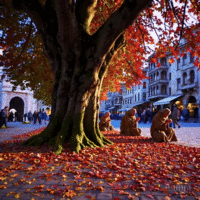
Erythros traces its origins to an Alperkin cult that regarded the golden-furred Archigós as a direct manifestation of the Host Spirit. The city's early development centered around sacred rites intended to bridge the mortal and divine worlds, with the Tar-Lands viewed as a liminal space where the boundaries between life, death, and eternity were permeable.
Over centuries, Erythros became a gathering point for pilgrims from across Bassaridia Vaeringheim and beyond. Following the Reformation of Bassarid religious practices, Erythros maintained its spiritual prominence by adapting its traditional rites into the broader framework of the Reformed faith. The emergence of cults such as the Mystery of Red Mirth and the Thiasos Kyrenaïou solidified its status as a city where diverse religious expressions coexist.
During the Haifan Civil War and the Morovian Frontier Campaign, Erythros remained largely unscathed, protected both by its remote location and by its sacred reputation. Many of its ancient shrines, gardens, and symposium courts have survived intact, preserving a direct cultural link to its founding era.
Geography
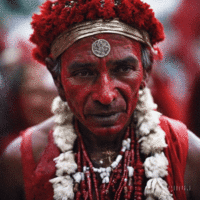
Erythros is located deep within the Tar-Lands of the Gloom Forest of Perpetual Autumn, a region where the landscape is characterized by dense, amber-colored forests and vast pools of thick, black tar. The Tar-Lands are regarded as spiritually charged terrain, traditionally interpreted as a gateway between the mortal world and the divine realms.
The city itself is built atop natural terraces formed by ancient geological activity. Its layout is defined by meandering stone pathways, open-air forums known as star-courts, sacred gardens, and shrines dedicated to the Archigós, Silenus, Bacchus, and Kyrenaïs. Cypress trees, jasmine vines, and ancient fig trees are common throughout Erythros, particularly within the gardens maintained by the Thiasos Kyrenaïou. Despite the region's harsh conditions, Erythros has cultivated a vibrant ecological and spiritual environment.
Economy
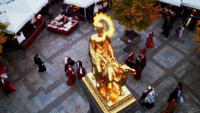
Erythros' economy is primarily driven by religious tourism, artisanal crafts, and regional trade. Pilgrims visiting the city's sacred sites generate substantial economic activity through offerings, lodging, festival participation, and the purchase of devotional goods. Religious festivals and symposiums, organized by the Mystery of Red Mirth and the Thiasos Kyrenaïou, also draw large crowds throughout the year.
The city's artisans produce a variety of goods, including cypresswood carvings, ceremonial robes, amphorae of sacred wines infused with Zoe Elm essence, and illuminated manuscripts detailing religious hymns and histories. Erythros is particularly known for its star-embroidered textiles and fine mosaics depicting scenes from Alperkin and Bassarid mythology.
In the modern era, Erythros has become a secondary headquarters for the Maritime Guild of the Cult of Maskmakers, following the partial collapse of the Bassarids. The Guild's presence has strengthened the city's position as a key node in religious, cultural, and commercial networks across the region.
Culture
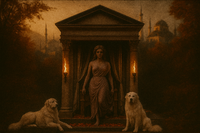
Erythros is characterized by a culture of intense religious devotion balanced by vibrant public life. Festivals, rituals, and symposiums are central to civic identity. The city's major celebrations are led by the Mystery of Red Mirth, whose influence permeates public culture through events such as the Karnavali Thysias (Carnival of Celebration), which features satyr-like costumes, public feasts, music, and theatrical performances honoring Silenus.
In contrast, the Erysic add a solemn dimension to daily life in Erythros. Living as ascetics under a divine curse of insatiable hunger and thirst, they embody a continual warning against hubris and spiritual corruption. Their processions, prayers, and acts of penance are regarded with reverence by the city's inhabitants.
The Thiasos Kyrenaïou plays an important role in cultivating traditions of peaceful discourse and civic unity. During times of public distress, the Thiasos calls for the observance of Agrypnía Kyrenaïou ("Kyrenaïs' Vigil"), during which citizens gather in symposium courts to deliberate and share Zoe Elm-infused wine under the night sky. These observances emphasize reflection, reconciliation, and collective wisdom.
Through these complementary traditions, Erythros maintains a civic culture that emphasizes both joyful celebration and spiritual reflection.
Important Citizens
Erythros has been home to several influential historical and mythological figures. First among these is Diona, daughter of Chrysos and the merchant queen Iphigenia, was a member of the Guild of Golden Shadows. Her commercial enterprises brought lasting prosperity and international prestige to the city. Plutus, a demi-god and son of Chrysos and Nephele, is credited with ensuring the long-term financial stability of Erythros, blending economic prosperity with divine favor. Clio, daughter of Bassaria and Pindar, known as the muse of history, lived in Erythros for a time and contributed to the preservation of its historical memory through the establishment of archives and public records. Kyrenaïs, a mortal figure celebrated as favored among the gods, is honored for her devotion, serenity, and enduring wisdom. Though her precise historical existence remains a matter of theological interpretation, her memory is maintained through the rituals and gardens of the Thiasos Kyrenaïou, and her influence is regarded as integral to the city's cultural and spiritual identity.
Catonis Atrium

Catonis Atrium, situated within the juniper forests of the northern highlands, bears testament to the ancient legacy of the satyrs who once roamed the region. Renowned for their expertise in raising herds of the now virtually extinct Vegetable lamb of Tartary, the city has evolved into a bastion of discipline and order under the auspices of Rex Catonis, a Reformed Bassarid cult devoted to Cato, Divine of discipline and order.
History
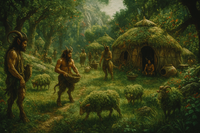
Catonis Atrium's history is deeply intertwined with the traditions of the satyrs, who lived and worked in the region's juniper forests and tended to their prized herds of vegetable lambs of Tartary. As guardians of the land, the satyrs instilled a sense of discipline and harmony within their community, guided by the principles of order and balance. Over time, the city grew into a thriving center of agriculture and commerce, drawing merchants and travelers from distant lands. With the rise of Rex Catonis, the city embraced a new era of discipline and order, honoring the teachings of Cato and upholding the values of integrity and self-discipline.
Geography

Catonis Atrium is situated amidst the lush juniper forests of the northern highlands, where towering trees and rolling hills create a picturesque backdrop for the city. The juniper forests provide ample resources and sustenance for the city's inhabitants, while the crisp mountain air invigorates the spirit and soul. The surrounding landscape, with its winding rivers and verdant forested meadows, offers countless opportunities for exploration and adventure, making Catonis Atrium a haven for nature enthusiasts and outdoor enthusiasts alike.
Economy
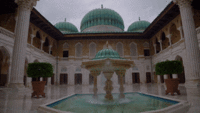
Catonis Atrium's economy is supported primarily by agriculture, craftsmanship, and trade. The city's fertile lands yield bountiful harvests of juniper berries, which are harvested and processed into various goods such as food, medicine, and beverages. Skilled artisans and craftsmen ply their trade within the city walls, producing finely crafted goods and wares highly sought after by locals and visitors alike. Trade with neighboring settlements and distant lands further stimulates economic activity, enriching the city's cultural tapestry with diverse goods and commodities.
Culture
Catonis Atrium thrives as a city deeply rooted in discipline, order, and self-improvement, guided by its reverence for Cato, Divine of Discipline and Order. The inhabitants embody industriousness, integrity, and a commitment to excellence, following the teachings upheld by Rex Catonis. Rituals and ceremonies conducted in honor of Cato serve as pivotal opportunities for spiritual growth and personal development, fostering a strong sense of community and camaraderie among the city’s residents.
The cultural calendar of Catonis Atrium features significant festivals that reflect its unique traditions and heritage. Among these is Atämiorium, observed on Thalassiel 52, during which ascension rites glorify Host Star Atämios’s wisdom. The event culminates with the release of floating lanterns, symbolizing enlightenment and the pursuit of higher ideals. Another key celebration is Sefar Yashar, the Straight Path Celebration, held on Opsitheiel 53. Pilgrims walk a symbolic Path of Virtue, attending sermons on moral clarity and reflecting on the teachings of Cato. These festivals, alongside ceremonies honoring the ancient satyrs and the herds of vegetable lamb once raised in the region, highlight the city’s connection to its historical and spiritual roots.
Nestled in the juniper forests of the northern highlands, Catonis Atrium stands as a beacon of integrity and self-improvement. Its devotion to discipline and order, combined with its rich cultural traditions, ensures the city’s enduring prosperity and unity.
Important Citizens
Catonis Atrium was famously the home of Aurelia, one of Bassaridia's greatest military and political leaders. The daughter of Cato and Drusilla - and purportedly the first cousin of the empress Kan Zen - Aurelia was a strict devotee of the cult of her father, and was famous for her leadership and organizational skills in governance. Catonis Atrium was also the home of the demi-god, Secutor, son of Cato and Drusilla, who was known for his discipline and strategic mind.
Delphica
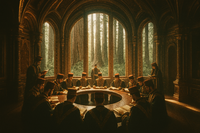
Delphica, situated in the Coastal Woodlands of eastern Bassaridia Vaeringheim, holds a rich history as the northern headquarters of the Couriers of the Lizard Queen, an ancient Bassarid commercial cult consisting entirely of women, who practice a type of magic which provides protection against the region's parasitic wisps. Today, the city is home to Sanctum Delphica, a Reformed Bassarid cult devoted to Sisera, Lady Divine of reflection and introspection.
History

Delphica's history is deeply rooted in the traditions of the Couriers of the Lizard Queen, who established the city as a bastion of protection against the parasitic wisps that inhabit the northern shores of Lake Morovia and the northern Strait of Haifa. Guided by their religious practices and devotion to the Lizard Queen, the cult's members played a crucial role in safeguarding travelers and merchants from the malevolent influence of the wisps. Over time, the city grew into a thriving center of commerce and spirituality, drawing pilgrims and seekers from far and wide. With the rise of Sanctum Delphica, the city embraced a new era of spiritual introspection and enlightenment, especially following the establishment of the Temple University of Delphica, which is today the largest institute of higher education in Bassaridia Vaeringheim.
Geography
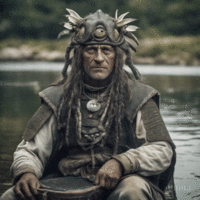
Delphica is located in the Coastal Woodlands of eastern Bassaridia Vaeringheim, where dense redwood forests and winding rivers create a tranquil setting for the city. The Coastal Woodlands, with their lush vegetation and abundant wildlife, offer sanctuary and sustenance for the city's inhabitants, while the gentle rolling of waves against the shore provides a soothing backdrop for contemplation and introspection.
Economy
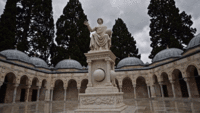
Delphica's economy is supported by a combination of trade, agriculture, and spiritual tourism. The city's location along the shores of the Northern Strait of Haifa facilitates trade with neighboring settlements and distant lands, while its fertile lands yield bountiful harvests of crops and herbs prized for their medicinal properties. The city's economy is, to this day, still heavily supported by the Couriers of the Lizard Queen, whose members offer their services to merchants and travelers seeking protection from the region's parasitic wisps. The city's economy is also supported by enrollment in the Temple University of Delphica.
Culture
Delphica’s culture is deeply influenced by the Couriers of the Lizard Queen and Sanctum Delphica, two institutions that embody the city’s spiritual and intellectual identity. The Couriers, renowned for their ancient religious traditions, play a vital role in creating protective wards against the parasitic wisps that haunt the northern shores of Lake Morovia. Their presence fosters a sense of security, reverence for nature, and spiritual guardianship among the city’s inhabitants, promoting values of mutual support and collective well-being. This dedication to protection and harmony is celebrated annually during Amaäzakar on Thalassiel 2, a glowing lantern festival honoring Host Star Amaäz. The festival features floating lights released on rivers and ponds, symbolizing the warding off of misfortune and the community’s collective strength.
Alongside the Couriers’ spiritual contributions, Sanctum Delphica elevates the city’s cultural and intellectual landscape through its stewardship of the Temple University of Delphica. Renowned as the largest institute of higher education in Bassaridia Vaeringheim, the university cultivates a culture of academic excellence, introspective exploration, spiritual growth, and intellectual curiosity. These values are reflected in Delphica’s celebration of Nyarion on Opsitheiel 7, a holiday dedicated to Host Star Nyama. During this day, guided meditations and midnight music inspire deep reflection, while scribes document personal visions onto communal scrolls, reinforcing the city’s commitment to both spiritual and intellectual enlightenment.
Together, the Couriers of the Lizard Queen and Sanctum Delphica shape Delphica into a thriving center of spiritual protection, academic achievement, and communal harmony, ensuring its reputation as one of the most influential cities in Bassaridia Vaeringheim.
Important Citizens
Delphica has historically been the home of many of the nation's great intellectual leaders and philosophers. Most notable of these is Anteros, son of Sisera and Tycho. One of the nation's greatest philosophers, Anteros' philosophy was heavily impacted by the doctrines of Sanctum Delphica, though he never claimed membership in the cult. Anteros, with that said, was known for his reflective nature and great philosophical insights. Delphica was also home to the demi-god, Libera, daughter of Lukedu and Sisera, who was known for her reflective nature and philosophical insights.
Koinonía

Koinonía, a city nestled in the juniper-covered foothills of the Northern Highlands, was originally established by Bassarid missionaries with the aim of spreading the teachings of the Stripping Path into northern Alperkin-controlled territories. Today, it serves as the home of Ordo Amicitia, a Reformed Bassarid cult devoted to Erasmus, Divine of charity. Beneath the city lies an ancient underground labyrinth, known as the Tahyrint Penbellence, rumored to be the domain of a fierce minotaur. Legend holds that this minotaur was once a man cursed and imprisoned within the labyrinth after offending the Bride of the Host Spirit.
History
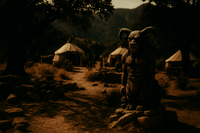
Koinonía's history is steeped in the religious traditions of Bassarid missionaries of the cult of Apollo, who sought to extend the influence of the Stripping Path into the rugged terrain of the Alperkin-controlled juniper forests of the Northern Highlands. Facing resistance from the Alperkin inhabitants, the missionaries persevered, eventually establishing Koinonía as a center of Bassarid faith and community. Over time, the city flourished, attracting the religion's followers from far and wide who were drawn to the region for its strong traditional Bassarid community, and later by the teachings of charity and compassion espoused by Ordo Amicitia.
Geography
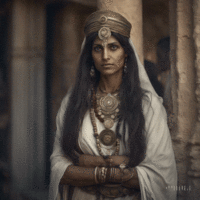
Koinonía is situated amidst the juniper-covered foothills of the Northern Highlands, its rugged terrain offering both challenges and opportunities for its inhabitants. The city's strategic location provides panoramic views of the surrounding landscape, while the dense forests and winding rivers offer sanctuary for its residents. Beneath the surface lies the mysterious underground labyrinth, home to a minotaur who was cursed to reside for eternity in the labyrinth's twisting passages which to this day remain shrouded in darkness and mystery.
Economy
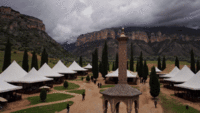
Koinonía's economy is driven by a combination of agriculture, trade, and spiritual tourism. The fertile soil of the Northern Highlands yields bountiful harvests of crops and herbs, which are cultivated by the city's inhabitants and traded with neighboring settlements. The city, to this end, is home to the northern branch of the Plains of Jogi, the nation's largest producer of grain. Additionally, Koinonía's status as a center of religious devotion and pilgrimage attracts visitors from far and wide, stimulating economic activity through the sale of religious artifacts, offerings, and services. Rumors of treasure within and danger within the vast, shadowy labyrinth which lies below the city, entice adventurers from across the region to the city.
Culture
Koinonía's culture is characterized by its deep-rooted faith in the principles of charity, compassion, and community. The city's inhabitants, guided by the teachings of Ordo Amicitia and the Divine Erasmus, and by the ancient customs of the Bassarid cult of Apollo, prioritize acts of kindness and altruism in their daily lives. Rituals and ceremonies conducted by the cult serve as opportunities for spiritual growth and communal bonding, fostering a sense of unity and fellowship among residents. Most famous among these rituals is the Offering to the Bride of the Host Spirit, which sees residents making offerings of flesh and treasure to appease the Host Spirit's bride, so as to maintain the minotaur's confinement within the labyrinth. Participants gather around an altar at the labyrinth's entrance, presenting food, livestock, and precious artifacts as symbols of contrition and reconciliation with the divine. Through prayers and rituals, they seek to ensure the city's safety by honoring the ancient pact with the Bride of the Host Spirit.
Important Citizens
Throughout its history, Koinonía has served as the home of many notable individuals - perhaps more than any other city in Bassaridia Vaeringheim. Of the many influential figures who have made their home in Koinonía, three are especially notable: Galen, Sophos, and Kyra. Galen, son of Ampelos and Cleon, and a member of the Harmony Sanctum, was a Famous healer whose techniques are still studied and practiced, Galen's contributions to medicine have brought health and prosperity to the diverse populace of Koinonía. Spohos, daughter of Erasmus and Cassandra, and a devout practitioner of Ordo Amicitia, was a renowned sage whose teachings have influenced many scholars. Sophos' wisdom and guidance have shaped the intellectual and cultural development of Koinonía. Kyra, daughter of Nikolaj and Selena, and - like Sophos - a member of Ordo Amicitia, was known for her calming influence and ability to heal through rest, Kyra's presence brings peace and rejuvenation to the people of Koinonía, enhancing the city's reputation as a center of healing and wisdom. Koinonía has also served as the home of more demi-gods than any other city. Among these are Hephaestus, son Pyros and an unknown mortal, who was known for his exceptional craftsmanship and innovation. Hermes also made his home here. The son of Ampelos and Penthia, Hermes was renowned for his speed and cunning, playing a crucial role in maintaining communication and trade routes within Koinonía. The demi-god, Hypatia, also made her home in Koinonía. The daughter of Erasmus and Nyssa, Hypatia was revered for her intellectual brilliance.
Aureum
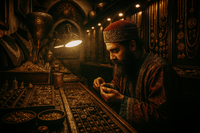
Aureum stands as a testament to the ancient Alperkin Gold-eaters, a race renowned for their consumption of the precious, glistening metal mined to this day from the surrounding hills. Today, the city thrives as the seat of Temple Illuminata, a Reformed Bassarid cult devoted to Nikolaj, Divine of Epiphanies. Ruled directly by the High Alp Lulanu, believed by local Alperkin tribes to be the daughter of the Host Spirit, Aureum pulsates with a rich blend of history, spirituality, and opulence.
History

Founded by the gold-eaters of ancient lore, Aureum's roots delve deep into the annals of Alperkin history. The city's origins trace back to the discovery of abundant gold deposits in the nearby hills, which fueled the prosperity and influence of its ancient founders. Over the centuries, Aureum has evolved from a mining settlement into a thriving metropolis, its fortunes intertwined with the ebb and flow of gold and spiritual enlightenment. Despite its growth, traces of Aureum's earliest founders can still be seen on virtually every street and corner, and the influence of the gold-eaters weighs heavily upon the city.
Geography
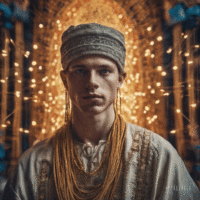
Nestled amidst the undulating, rolling hills that have long been synonymous with gold, Aureum boasts a picturesque setting that captivates the senses. The city is surrounded by lush forests and meandering rivers, providing a tranquil backdrop to its bustling streets and opulent, traditional Alperkin architecture. Located in a region steeped in natural beauty and spiritual significance, Aureum draws visitors from far and wide seeking both material wealth and enlightenment.
Economy
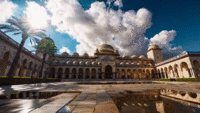
Aureum's economy is anchored in the legacy of its gold-rich surroundings, with mining and trade serving as pillars of prosperity. The city's artisans, who are collectively represented on the General Port of Lake Morovia by the Shï Collective, are renowned for their craftsmanship in transforming the precious metal into exquisite jewelry, sculptures, and artifacts that fetch premium prices in markets near and far. Additionally, Aureum's status as a spiritual hub attracts pilgrims and seekers, contributing to the city's vibrant economy through offerings, donations, and spiritual tourism
Culture
Aureum's culture is a tapestry woven from threads of tradition, spirituality, and artistic expression. Temple Illuminata stands as a beacon of enlightenment, where devotees gather hoping to receive profound revelations under the guidance of Nikolaj, Divine of Epiphanies. The city's streets pulse with the rhythms of life, as festivals celebrating Alperkin heritage and spiritual teachings infuse the air with music, dance, and celebration. At its heart, Aureum exudes a sense of wonder and reverence, where the pursuit of both material wealth and spiritual enlightenment converge in harmony..
Important Citizens
The most notable of all historical figures to have made their home in Aureum is Sol, King of the Gold Eaters, and son of Chrysos and either an unknown mortal, or Opsithe. Regarded by some as a demi-god rather than a mere mortal, Sol was a great philosopher best known for bringing enlightenment and clarity to the people of Aureum. Sol’s presence in Aureum symbolizes the pursuit of wisdom and the illumination of truth, greatly contributing to the city's reputation as a center of knowledge and cosmic insight. Aureum was also home to the demi-god, Calliope, daughter of Ariadna and Orpheus, who was regarded as the muse of epic poetry and eloquence.
Alperkin cities
The Alpazkigz

The Alpazkigz is the awe-inspiring, ever-shifting capital of the Alperkin people, located along the northwestern shores of Lake Morovia in central Keltia. Often described as a “tent city within a tent,” the Alpazkigz exists entirely within a colossal yurt that serves as the ceremonial and political heart of Alperkin society. As the home of the Heavenlet, the chosen representative of the vampiric High Alp Tar, the Alpazkigz holds immense spiritual and cultural significance. It is renowned for its association with the psychoactive plant Noctic-Rabrev and its deep connections to the alps, supernatural entities said to haunt the region’s forests and swamps. Governed under the provisions of the Bassaridian Constitution of 50.43 PSSC, the Alpazkigz is protected as a vital center of Alperkin heritage and spirituality.
History
The origins of the Alpazkigz date back to ancient customs surrounding the Cricket-Rise Festival, during which the Alperkin constructed large communal yurts to host spiritual gatherings. Over centuries, these structures became increasingly elaborate, eventually merging into a single palatial yurt that formed the foundation of the Alpazkigz.
Throughout its history, the Alpazkigz has faced significant challenges, including invasions by Caputian settlers and Morovian nationalist forces. In response to these threats, the Alpazkigz adopted a nomadic nature, relocating to the safety of the Gloom Forest of Perpetual Autumn during times of crisis. Despite these upheavals, the Alpazkigz persisted as a symbol of Alperkin resilience. In the modern era, the Alpazkigz played a central role in the struggle against foreign suppression of the Noctic-Rabrev trade, culminating in the defeat of the Anti-Noctic League. The victory secured a new era of autonomy, with the Bassaridian Constitution of 50.43 PSSC codifying protections for its nomadic practices, sacred sites, and cultural traditions.
Geography

The Alpazkigz epitomizes the Alperkin tradition of seasonal migration. As outlined in the Bassaridian Constitution, it moves annually between designated Culturally Significant Zones, including the Coastal Woodlands, the Gloom Forest of Perpetual Autumn, and the Northern Highlands. These relocations coincide with the liturgical calendar, ensuring the spiritual and ecological balance necessary for Alperkin life.
The migration routes and sacred lands of the Alpazkigz are protected under constitutional provisions, which guarantee their preservation and accessibility. The Saint Mothers, in collaboration with Autonomous Cultural Councils, oversee the movement and re-establishment of the Alpazkigz, ensuring its continued connection to the land and its resources. Sites are selected for their spiritual significance and proximity to vital resources, including rice paddies, Noctic-Rabrev fields, and tar-pits used in funerary rites.
Economy
The Alpazkigz serves as both a religious and economic hub for the Alperkin people. Its economy is centered on the trade of Noctic-Rabrev, a potent psychoactive plant integral to Alperkin spirituality and rituals. Traders from across Lake Morovia flock to the Alpazkigz to buy and sell Noctic-Rabrev and its derivatives.
While the Alpazkigz lacks direct access to Lake Morovia, it maintains strong economic ties with the General Port of Lake Morovia. Seasonal caravans from the Alpazkigz transport goods such as furs, medicinal plants, and religious artifacts to the port, integrating the city into regional trade networks. Constitutional protections prevent industrial encroachment on ancestral lands, ensuring that the Alpazkigz’s economic activities remain sustainable and aligned with its cultural values.
Culture

The Alpazkigz is a living testament to Alperkin culture, where every aspect of life is imbued with spiritual significance. At its center lies the Graji Canïfaha, the grand temple-yurt that houses the Heavenlet and serves as the focal point of Alperkin spiritual life. Surrounding it are concentric rings of yurts, each inscribed with “yurt-stories” that document the history and lineage of the families who inhabit them.
The cultural life of the Alpazkigz revolves around a liturgical calendar of festivals and rituals. The Cricket-Rise Festival, which occurs on the first day of the month of Atosiel, celebrates renewal and cleansing, while the Cicada Song Festival, celebrated on the first day of Thalassiel, marks a time of joy and preparation for migration. The Cricket-Fall Festival, celebrated on the first day of Opsitheiel,, features the Blood-Share ritual, fostering communion with the gods and the dead. During the solemn period of the Silence, the Alpazkigz is dismantled and transported to a new location, marking the beginning of a new spiritual cycle.
Religious life in the Alpazkigz is guided by the Saint Mothers, who serve as spiritual leaders and custodians of Alperkin heritage. The city honors High Alps, such as Tar and Saline, as well as local spirits and Savage Alps. The Bassaridian Constitution affirms the role of the Saint Mothers as protectors of Alperkin traditions, granting them oversight of governance and cultural preservation efforts.
Important Citizens
The Alpazkigz has been shaped by the leadership and influence of notable individuals who have left a lasting legacy on the Alperkin people and their cultural heritage. Heavenlet Sulféu III is celebrated as one of the most influential leaders in the history of the Alpazkigz. A half-Alp, he played a crucial role in defeating the Anti-Noctic League, reclaiming vital Noctic-Rabrev fields known as “Blood Orchards,” and ensuring the survival of the Alperkin’s spiritual and economic lifeblood. Sulféu III’s leadership during a critical era secured the Alpazkigz’s autonomy and strengthened its position as the cultural and spiritual heart of the Alperkin people.
Saint Mother Death is widely revered—and feared—for her authoritative role as the most powerful of the Saint Mothers. Known for her ability to mediate conflicts among clans and enforce the sacred laws of the Alpazkigz, she is also believed to share a mystical connection with the tar-worms of the Gloom Forest of Perpetual Autumn. Her presence ensures the spiritual integrity of the Alpazkigz, while her rulings are considered final in matters of religious and cultural significance.
Eous, a centaur from beyond the Alperkin lands, became a legendary figure when he was chosen to lead a struggling clan during a period of dire need. His efforts to protect the clan from Morovian raiders are celebrated in song and folklore, symbolizing the Alperkin willingness to embrace outsiders in times of crisis. Eous’ story is a testament to the adaptability and resilience of the Alpazkigz and its people.
These individuals, among others, have shaped the Alpazkigz into the cultural and spiritual epicenter of Alperkin life, ensuring the preservation of their traditions and the continued influence of their unique worldview.
Odiferia
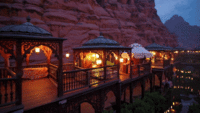
Odiferia is a historic Alperkin city located in the Southern Odiferae Wetlands, surrounded by swamps and red sandstone cliffs in southern Bassaridia Vaeringheim. Known for its open, sprawling layout, Odiferia blends seamlessly with its natural environment, with clusters of yurts adapted to the wetland terrain. Historically, it has been the heart of the Noctic-Rabrev trade, a potent psychoactive plant essential to the spiritual and economic life of the Alperkin people. Unlike the enclosed Alpazkigz, Odiferia thrives as an open city where trade and culture intermingle under the vast skies of the wetlands. Once a political and economic rival to the Alpazkigz, the city played a significant role in uniting the Alperkin peoples under the Mandate of Tarnation in the late 40th era PSSC, forging an alliance against the Morovian nationalists.
History
Odiferia’s foundation in the Southern Odiferae Wetlands was driven by its ideal conditions for cultivating Noctic-Rabrev, a plant central to Alperkin spirituality and commerce. As the city grew, it became a major trade hub on Lake Morovia, attracting merchants and spiritual leaders from across the region. During its peak, Odiferia rivaled the Alpazkigz in political and economic influence. The city’s wealth from Noctic-Rabrev trade enabled it to maintain strong governance and cultural independence, fostering a dynamic relationship with its northern counterpart. This rivalry persisted for centuries, defining much of the Alperkin identity. The turning point came in the late 40th era PSSC, when the Mandate of Tarnation unified Odiferia and the Alpazkigz to resist Morovian nationalist forces. This alliance marked the end of their competition and ushered in an era of shared cultural pride and cooperation.
Geography
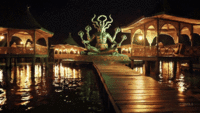
Nestled in the Southern Odiferae Wetlands, Odiferia’s geography is defined by its integration with the surrounding natural environment. Elevated wooden pathways and stone bridges wind through the swampy terrain, connecting clusters of yurts spread across the city. The wetlands are dotted with fields of Noctic-Rabrev, whose vivid leaves add splashes of green to the vibrant landscape of red sandstone cliffs and autumnal foliage. The city’s open layout reflects its connection to the land, with markets, communal spaces, and ceremonial areas interspersed among the natural features. The cliffs surrounding Odiferia provide a dramatic backdrop, enhancing the city’s striking visual identity.
Economy
Odiferia’s economy has historically revolved around the cultivation and trade of Noctic-Rabrev, which thrives in the wetland environment. The city exports Noctic-Rabrev leaves and derivatives, such as tinctures and oils, to neighboring regions, sustaining its economic prominence. At the heart of Odiferia’s economic life is the bustling Plaza Rabrev, a central market where merchants and artisans converge to trade their goods. Here, vibrant stalls display everything from aromatic herbs and handcrafted ornaments to ceremonial tools and textiles. The city’s strategic position near Lake Morovia connects it to broader trade networks, ensuring the steady flow of goods and wealth that has supported its growth and influence.
Culture
The culture of Odiferia is deeply shaped by its role as the center of the Noctic-Rabrev trade and its integration with the natural environment. The use of Noctic-Rabrev in spiritual ceremonies is a defining aspect of daily life, with rituals often held in communal spaces or near the wetlands where the plant is cultivated. The city’s artisans and merchants play a crucial role in preserving and promoting Alperkin traditions through their crafts, from intricately woven textiles to ceremonial talismans. Odiferia is also renowned for its festivals, which celebrate the harvests of Noctic-Rabrev and the unity of the Alperkin people. These events bring the city to life with music, dance, and the aromatic waft of incense and herbs, reinforcing its reputation as a vibrant cultural hub.
Major Cities in New South Jangsong
Skýrophos
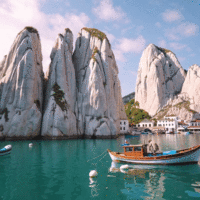
Skýrophos is a prominent city in the Normarkian region of New South Jangsong, renowned for its rich blend of Haifan and Normarkian heritage. Situated along the western shores of the Northern Strait of Haifa, the city is a vibrant hub of commerce, culture, and craftsmanship. Known for its strategic location, enchanting natural surroundings, and resilient spirit, Skýrophos has maintained its unique identity and autonomy despite historical challenges and external pressures.
History
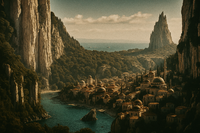
Skýrophos was founded by Normarkian settlers seeking new trade opportunities and fertile land. Over the centuries, it evolved into a bustling center of commerce and culture, blending Haifan architectural elegance with Normarkian fortitude. The city has a storied history of resistance against external control, particularly during the early 49th era when Bassaridia Vaeringheim attempted to assert dominance. The assassinations of influential local leaders by the Hatch Ministry led to internal strife and the eventual establishment of Bassarid-friendly governance. Despite these challenges, Skýrophos has always maintained a strong sense of identity and resilience.
Geography

Skýrophos is uniquely situated between the shimmering Suncliffs and the mystical Alterbulb Forest. The Suncliffs - several hundred feet tall with huge sparkling quartz formations, provide a natural defense and beauty, rising majestically around the city. The Alterbulb Forest, filled with ancient, luminescent trees, surrounds the outskirts of Skýrophos, offers abundant natural resources. The city’s well-protected harbor, framed by natural rock formations, serves as an ideal strategic port for maritime activities. These geographical features contribute to Skýrophos' enchanting and strategic importance.
Economy

The economy of Skýrophos is diverse and unique, blending traditional maritime trade with specialized local industries. The city's port is a crucial hub for commercial exchanges with neighboring regions and distant lands. Skýrophos is particularly renowned for its unique craftsmanship, producing goods believed to be imbued with magical properties from Alterbulb's luminescent wood and Suncliff's quartz. Local artisans create everything from enchanted jewelry and tools to extremely intricate glowing mosaics which are commonly purchased and displayed in major landmarks across the region. Additionally, the city's thriving fishery, known for the production of large quantities of Atterian Armored Pufferfish - a prized delicacy - plays a significant role in the local economy.
Culture
Skýrophos is a melting pot of cultural influences, with its architecture featuring a harmonious blend of classical Haifan-inspired temples and Normarkian longhouses. Cultural life in the city revolves around numerous festivals and traditions celebrating its maritime heritage and historical roots. One of the most celebrated events is the Festival of the Luminous Night, held annually under the glow of the full moon. During this festival, the city is adorned with luminescent decorations from Alterbulb wood. The festivities include a grand parade featuring mythical creatures, music, dance, and feasts with local delicacies like armored pufferfish and specialized local pastries. The highlight is the ceremonial lighting of the King Alterbulb Tree in the central square, illuminating the night and symbolizing unity and pride in Skýrophos' unique heritage.
Bjornopolis
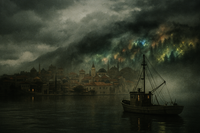
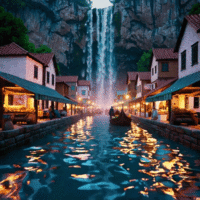
Bjornopolis is a thriving city, known for its rich Normarkian heritage and bustling trade activities. The city serves as a key trading hub and cultural center. Renowned for its strategic location, natural beauty, and resilient spirit, Bjornopolis has successfully blended its historical roots with modern advancements.
History
Bjornopolis was established by Normarkian settlers who recognized the strategic and economic potential of its location. Over time, it developed into a significant trading center, attracting merchants from across the region. The city's merchant guilds have historically played a vital role in its economic and political life. During the early 49th Era PSSC, Bjornopolis became a focal point of the Hatch Ministry's covert operations, as Bassarid agents sought to infiltrate and disrupt local trade networks. Despite significant resistance from the local merchant elite, Bassarid influence gradually increased, altering the city's power dynamics.
Geography

Bjornopolis is uniquely located on the edge of the Agnian Fjord. The city is built upon a series of terraces that rise from the fjord, offering stunning views of the surrounding area. The Sirenian Falls, a series of cascading waterfalls that produce melodic sounds as the water flows over the cliffs, are a prominent feature of the city's geography. Dense, forests surround the city, inhabited by many of the creatures for which the Strait of Haifa is famous, such as the Garganram and the Bijarian Ring-Tailed Leopard. The city's natural harbor is protected by towering granite cliffs, making it a safe and strategic port for maritime activities.
Economy
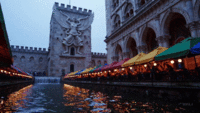
The economy of Bjornopolis is diverse and innovative, blending traditional maritime trade with unique local industries. The city's port facilitates extensive commercial exchanges, making it a crucial hub in the trade networks of New South Jangsong. Bjornopolis is renowned for its unique floating markets, where traders sell goods from brightly colored boats, creating a vibrant and dynamic trading environment. In addition to trade, the city is known for its production of textiles woven from the silk of the mythical sphinx moth, which can be found in abundance the forests surrounding the city. These textiles, imbued with restorative medicinal properties, are highly sought after across the region. The city also has a thriving brewing industry, producing a variety of meads and ales flavored with rare herbs and spices from the surrounding forests.
Culture
Bjornopolis is a cultural melting pot, reflecting its Normarkian roots and the diverse influences brought by centuries of trade. The city's architecture features sturdy wooden structures adorned with intricate carvings and runes, blending traditional Norse designs with elements of fantasy. Cultural life in Bjornopolis revolves around its bustling marketplaces, lively festivals, and strong community ties. One of the most celebrated events is the Festival of the Sirenian Falls, held annually during the spring equinox. During this festival, the entire city is adorned with lanterns made from luminescent flowers harvested from the Alterbulb Forest, and the falls are illuminated with enchanted lights, creating a magical atmosphere. The festival begins with a grand procession through the city, featuring performers dressed as mythical creatures from local legends. The highlight of the festival is the Water Dance, a mesmerizing performance where dancers mimic the flow of the falls, accompanied by the melodic sounds of the cascading water. The festival also includes music, storytelling, and feasts featuring local delicacies, such as enchanted pastries and mead. The Festival of the Whispering Falls is a celebration of Bjornopolis' unique heritage, blending magic, culture, and community in a dazzling display of unity and pride.
Aegirheim
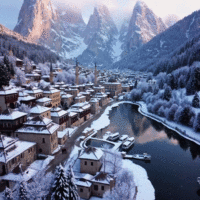
Aegirheim is a fortified city renowned for its shipbuilding prowess and maritime traditions. Nestled along the rugged coastline of the Northern Strait of Haifa, the city is a formidable naval stronghold and a vibrant cultural hub. Known for its strategic location, resilient spirit, and unique, natural beauty, Aegirheim stands as a testament to the enduring legacy of its Viking and Greek founders.
History
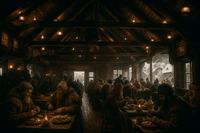
Aegirheim was founded by Normarkian clans who sought to create a fortified settlement with robust shipbuilding capabilities. Over time, it grew into a major naval power, renowned for its shipyards and maritime expertise. The city's strategic importance made it a prime target during the Bassarid expansion efforts in the early 49th Era PSSC. The Hatch Ministry's sabotage operations caused significant delays in the construction and maintenance of Aegirheim's fleet, weakening its naval capabilities. Despite these challenges, Aegirheim's resilient workforce and strategic initiatives allowed it to recover and maintain its status as a key maritime center.
Geography

Aegirheim is uniquely situated on a dramatic stretch of coastline, where the jagged cliffs of the Pythe Spine Mountains meet the enchanted waters of the Northern Strait of Haifa. The Pythe Spine Mountains, with their snow-capped peaks and hidden caves, provide a natural defense and a source of key materials used in shipbuilding. The city's harbor is protected by the Teeth of the Leviathan, a series of rocky outcrops resembling the jaws of a massive Glinos Leviathan. The nearby Alterbulb Forest, shrouded in perpetual mist, is home to unique creatures and luminescent plants. The enchanted Aengir's Bay, known for its shimmering bioluminescent waters, lies adjacent to the harbor and serves as a vital fishing ground and source of inspiration for local artisans.
Economy

The economy of Aegirheim is distinct and multifaceted, with a strong emphasis on maritime activities and craftsmanship. The city's shipyards are renowned for producing high-quality vessels, incorporating durable materials from the Pythe Spine Mountains. Aegirheim’s blacksmiths and craftsmen create finely crafted weaponry and tools, known for their exceptional quality and durability. The city’s thriving fishery, centered around Aegir's Bay, harvests sea creatures, such as the Amina Crab and the elusive Morovian Saucer-Eyed Giant Eel, which are prized for their distinctive flavors and culinary uses. Additionally, Aegirheim has a burgeoning trade in artisanal goods, attracting merchants and adventurers from far and wide. The city's markets are vibrant and dynamic, offering everything from expertly woven textiles to finely made pottery and metalwork, contributing to its reputation as a center of high-quality craftsmanship and trade.
Culture
Aegirheim’s culture is deeply rooted in its Normarkian heritage and maritime traditions, with a strong emphasis on community, resilience, and craftsmanship. The city’s architecture features sturdy stone fortifications, timber longhouses adorned with intricate carvings, and workshops filled with specialized tools and materials. Cultural life in Aegirheim revolves around its shipyards, markets, and communal gatherings, celebrating the city’s seafaring legacy and impressive natural surroundings. One of the most celebrated events is the Festival of the Aurora Lights, held annually during the winter solstice. During this festival, the entire city is illuminated with lanterns and magical lights, transforming Aegirheim into a glowing wonderland. The festivities begin with a grand naval parade, featuring ships adorned with enchanted sails and decorations. The highlight of the festival is the Aurora Dance, a mesmerizing performance on the waters of Aengir's Bay, where dancers in luminescent costumes mimic the movements of the shimmering waves. The festival also includes music, storytelling, and feasts featuring local delicacies, such as Amina Crab stew and locally produced mead. The Festival of the Aurora Lights is a celebration of Aegirheim’s unique heritage, blending culture and community in a dazzling display of unity and pride.
Norsolyra

Norsolyra is a captivating city known for its unique blend of Alperkin spiritual heritage and Normarkian culture. Originally established by Alperkin cult worshippers of the region's parasitic will o' wisps which haunt the northern Strait of Haifa, Norsolyra later fell to Normarkian raiders who infused the city with their own traditions. Today, Norsolyra is a key economic and cultural hub, celebrated for its enchanting landscapes and vibrant community life.
History
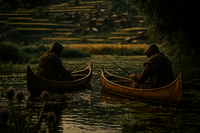
Norsolyra was initially founded by Alperkin settlers who revered the mystical, parasitic will o' wisps that inhabit the region. The city, whose founders believed that they could gain the favor and protection of the wisps through offerings and sacrifices, grew around rituals and offerings made to these ethereal beings. The city would later be conquered by Normarkian raiders, who were attracted by the city's strategic location and mystical allure, and who integrated their traditions with the existing Alperkin customs. The city's strategic and economic significance made it a target during the Bassarid expansion efforts in the 49th Era, leading to an economic blockade by the Hatch Ministry. Despite hardships, the resilient inhabitants of Norsolyra organized clandestine operations to bypass the blockade, ultimately retaining a degree of autonomy under Bassarid trade policies.
Geography

Norsolyra is uniquely situated at the confluence of the Tarnand Fjord and the northern Strait of Haifa. The city is built on a series of terraces that ascend from the fjord, offering breathtaking views of the surrounding landscape. The area is bordered by the Alterbulb, a forest filled with a wide range of unusual plants and animals, creating an aura of serene mysticism. The nearby Stygian Isles drift along the fjord adding to the city's natural wonder. To the west lies the Veinscour Marsh, an expansive wetland shrouded in mist and filled with ethereal, highly dangerous will o' wisps. The marsh is a source of rare alchemical ingredients and is known for its mysterious beauty. These geographic features make Norsolyra a place of extraordinary beauty and strategic importance.
Economy

The economy of Norsolyra is diverse and innovative, centered around its status as the northernmost major producer of Noctic-Rabrev, a highly valued crop grown in the Veinscour Marsh to the west of the city. The marsh's unique soil and climate create ideal conditions for Noctic-Rabrev, and farmers have adapted over the centuries to the presence of parasitic will o' wisps, developing innovative techniques to protect their crops and their homes, and ensure successful harvests. This crop - sacred to the Alperkin people of Bassarid Vaeringheim is integral to the city's economy. Additionally, Norsolyra excels in the cultivation of Wisp Rice, a type of rice which is grown using fertilizer produced from the waste of the regions wisps, and which is known for its unique properties and flavors. The city's bustling port and dynamic trade activities further enhance its economic significance, making Norsolyra a vital center of commerce and culture in New South Jangsong.
Culture
Norsolyra's culture is a rich tapestry of Alperkin spiritual practices and Normarkian social traditions. The city's architecture features a blend of ancient Alperkin shrines and sturdy Normarkian longhouses, adorned with intricate carvings and runes that tell the story of the city's dual heritage. Cultural life in Norsolyra revolves around its bustling marketplaces, lively festivals, and strong community ties. One of the most celebrated events is the Festival of the Luminous Spirits, held annually during the autumn equinox. During this festival, the entire city is illuminated with lanterns and decorations made from bioluminescent plants from the Alterbulb. The festival begins with a grand procession of boats along the Tarnand Fjord, each glowing with the light of will o' wisps and carrying performers dressed as the spirits of the dead. The highlight of the festival is the Spirit Dance, a mesmerizing performance where dancers, adorned in sphinx moth silk garments, move in harmony with the ethereal glow of the fjord's waters. The festival also includes music, storytelling, and feasts featuring local Wisp Rice-based delicacies. The Festival of the Luminous Spirits is a celebration of Norsolyra's unique heritage, blending magic, culture, and community in a dazzling display of unity and pride.
Thorsalon
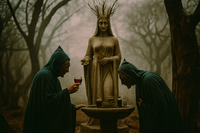
Thorsalon is a distinctive city originally established by Normarkians as the headquarters of the Blood Vineyards of the Far North. This company is renowned for producing wine uniquely flavored with human and animal blood, a practice steeped in ancient traditions and mystique. Situated along the rugged coastline of the Northern Strait of Haifa, Thorsalon is a hub of economic activity and cultural intrigue.
History
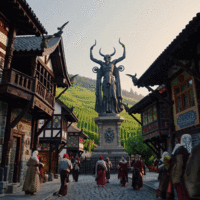
Thorsalon was founded by Normarkian settlers who sought to exploit the region's unique viticulture potential. The Blood Vineyards of the Far North quickly became the city's primary economic driver, drawing both fascination and revulsion from neighboring regions. Throughout its history, Thorsalon has maintained a degree of independence, with its unique product and strategic location providing both wealth and protection. The city has a storied past of defending its practices and traditions against external pressures, particularly during the Bassarid expansion in the early 49th Era.
Geography
Thorsalon is nestled between the Haemomantine Cliffs and the Erythraean Cave, creating a dramatic and otherworldly landscape. The Haemomantine Cliffs, composed of dark, iron-rich rock with veins of shimmering red minerals, rise majestically behind the city, providing both natural defense and an eerie beauty. The Erythraean Cave, named for its deep, reddish hue caused by mineral deposits and bioluminescent algae, extends beneath the cliffs and adds to the city's fantastical allure. The cave's subterranean river, known for its blood-red waters, is a source of mystery and legend, believed to enhance the mystical properties of the city's wines. Nearby lies the Mugwort Grove, a forest filled with ancient, twisted trees and abundant mugwort, regarded in local folklore as the Remembering Flower. This plant is highly valued for its use in inducing extremely vivid dreams and is a key ingredient in many of Thorsalon’s enchanted products. This enchanting geography makes Thorsalon a place of striking beauty and intrigue.
Economy

The economy of Thorsalon is heavily centered around the Blood Vineyards of the Far North, which produces the city’s renowned blood-infused wines. These wines, made from grapes grown in the mineral-rich soil of the Haemomantine Cliffs and infused with carefully sourced human and animal blood, are highly sought after for their unique flavor and supposed mystical properties. The vineyards employ a significant portion of the population, from grape pickers and vintners to blood alchemists and magical botanists. Additionally, Thorsalon has a thriving market for potions, crafted from the rare ingredients found in the Mugwort Grove and the Erythraean Cave. Mugwort, known across the Strait of Haifa as the Remembering Flower, is particularly prized for its ability to induce vivid dreams and is a key component in many of the city’s products.
Culture
Thorsalon's culture is deeply rooted in its Normarkian heritage and the unique practices of the Blood Vineyards. Cultural life in Thorsalon revolves around its vineyards, markets, and numerous festivals celebrating the city’s unique traditions. One of the most anticipated events is the Festival of the Crimson Harvest, held annually during the autumn equinox. During this festival, the city is adorned with blood-red banners and lanterns, and the streets come alive with music, dance, and theatrical performances depicting the city’s history. The highlight of the festival is the Blood Ritual, a ceremonial offering to the goddesses of the Haemomantine Cliffs, where participants present vials of blood to ensure a bountiful harvest and potent wine. The festival also includes a grand feast featuring delicacies such as blood sausage, red wine-braised meats, and enchanted pastries. The Festival of the Crimson Harvest is a celebration of Thorsalon’s unique heritage, blending tradition, mysticism, and community in a striking display of unity and pride.
Minor Cities in New South Jangsong
Pelagia
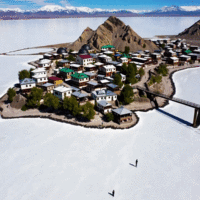
Pelagia is a unique city originally established by Bassarid military forces during the Strait of Haifa Campaign to secure and maintain critical supply lines. Following the campaign, the city was abandoned and later taken over by Normarkian camel herders, who transformed it into a vibrant center of trade and culture. Nestled along the shores of the Northern Strait of Haifa, Pelagia is a city of resilience and adaptation, blending its military origins with the pastoral traditions of its new inhabitants.
History
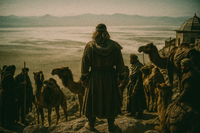
Pelagia was founded in the late 36th Era PSSC by Bassarid military forces as a strategic outpost to control supply lines during the Strait of Haifa Campaign. The city’s initial purpose was purely logistical, serving as a fortified hub for storing and distributing supplies to the Bassarid troops and their allies. However, following the conclusion of the campaign, the military abandoned Pelagia. Normarkian camel herders, seeking new grazing lands and trading opportunities, took over the deserted city. They adapted the infrastructure left behind by the Bassarids, incorporating their own pastoral and trading traditions, thus giving Pelagia a new lease on life.
Geography

Pelagia, located inland from the northern Strait of Haifa, is bordered by the Saltsteppes, a vast expanse where salt flats and hardy grasses create a stark, otherworldly beauty. Interspersed throughout the plains are oases, where sparse redwood trees and lush vegetation form verdant islands of life amidst the desolation. The Songs of Melusine, a local phenomenon where the wind sweeps across the salt flats creating haunting melodies, add a magical element to the region. These geographic features give Pelagia an otherworldly charm and strategic significance, making it a vital center for both trade and cultural exchange.
Economy
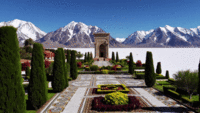
The economy of Pelagia is distinct and multifaceted, centered around trade, pastoralism, and unique local industries. The city serves as a bustling trading hub, with caravans arriving from distant lands to exchange goods such as spices, textiles, and artifacts. The Normarkian camel herders have adapted their traditional practices to the region, breeding camels known for their endurance and challenging climates of the northern Strait of Haifa. These camels are highly valued and form a significant part of the local economy. Additionally, Pelagia is renowned for its production of Salt Glass, a rare and beautiful type of glass produced from the salt which is mined in the Saltsteppes. This glass is sought after for its mesmerizing colors and is used in everything from jewelry to architectural elements. The city’s markets are vibrant and diverse, reflecting Pelagia's role as a central node in regional trade networks.
Culture
Pelagia's culture is a rich blend of Bassarid military heritage and Normarkian pastoral traditions. The city’s architecture features a mix of sturdy, functional military structures repurposed into homes and markets, alongside more recent constructions reflecting Normarkian aesthetics with flowing lines and open spaces. Cultural life in Pelagia revolves around its bustling markets, communal gatherings, and festivals celebrating the city’s unique history and traditions. One of the most anticipated events is the Festival of the Winds, held annually during the spring equinox. During this festival, the city is decorated with colorful banners and lanterns that dance in the wind. The festivities begin with a grand caravan parade, showcasing the finest camels and their ornate trappings. The highlight of the festival is the Wind Song Ceremony, where participants gather in the Saltsteppes to listen to the natural melodies created by the Winds of Melusine and sing along in harmony. The festival also includes music, storytelling, and feasts featuring local delicacies such as spiced camel meat and pastries. The Festival of the Winds is a celebration of Pelagia’s unique heritage, blending tradition and community in a display of unity and pride.
Myrene
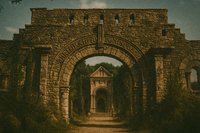
Myrene is a renowned city founded by Haifan scholars who fled the Haifan peninsula following its annexation by the Bassarids in the aftermath of the Haifan Civil War. Established as a sanctuary for learning, philosophy, and the arts, Myrene has become a beacon of knowledge and culture, attracting intellectuals from across the region.
History
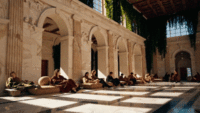
Myrene was founded in the early 39th Era by Haifan scholars seeking refuge from the Bassarid conquest of their homeland. These scholars established Myrene as a center of learning and philosophy, creating academies and libraries that quickly became focal points of intellectual activity. Over the centuries, Myrene has nurtured great minds and fostered debate, maintaining its status as a sanctuary for scholars even during times of regional turmoil. Despite occasional tensions with the Bassarids, Myrene has remained a bastion of independent thought and cultural preservation.
Geography

Myrene is uniquely situated in the Elysian Vale, a lush valley surrounded by the Parnassian Hills. The valley is nourished by the Nornstream River, whose waters are said to enhance clarity of thought and creativity. The Parnassian Hills, with their gleaming white marble and hidden caves filled with luminescent crystals, provide an impressive backdrop and a source of rare materials used in the city's architectural and artistic endeavors. This geography makes Myrene a place of both beauty and intellectual inspiration.
Economy
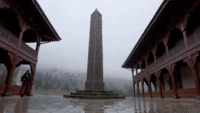
The economy of Myrene is centered around its academic institutions and the unique resources provided by its surroundings. The city's academies and libraries attract students, scholars, and visitors, contributing significantly to the local economy. Myrene is renowned for its production of Elysian Scrolls, made from the enchanted parchment of trees found in the Vale, and Norn Ink, derived from the waters of the Nornstream River. These scrolls and inks are highly prized for their durability and alleged mystical properties, used in everything from academic texts to enchanted manuscripts. The city also has a thriving artisanal sector, producing exquisite marble sculptures and jewelry crafted from the crystals of the Parnassian Hills.
Culture
Myrene's culture is deeply rooted in its Haifan intellectual heritage, with a strong emphasis on education, philosophy, and the arts. The city's architecture features classical elements, with stately academies, grand libraries, and elegant public spaces designed to inspire and educate. Cultural life in Myrene revolves around its academic calendar, with numerous lectures, debates, and symposia drawing participants from near and far. Festivals celebrating knowledge, the arts, and seasonal events are integral to the city's cultural fabric. One of the most anticipated events is the Festival of the Norn's Light, held annually during the summer solstice. During this festival, the entire city is illuminated with lanterns made from luminescent crystals, transforming Myrene into a glowing wonderland. The festivities begin with a grand procession through the city, featuring scholars and artists showcasing their works. The highlight of the festival is the Moonlit Symposium, an all-night gathering where participants discuss philosophical ideas and share their knowledge under the light of the full moon. The festival also includes music, storytelling, and feasts featuring local delicacies.
Thyrea

Thyrea is a storied city in the Normarkian region of New South Jangsong, established by Normarkian smugglers during the tumultuous Haifan Civil War. Over time, it transformed into a sanctuary for Bassarid worshipers of Agnis, the goddess of the underworld, who was expelled from the pantheon of the Reformed Stripping Path after her betrayal of Thalassa, the queen of the gods.
History
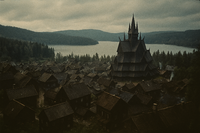
Thyrea was originally by Normarkian smugglers who capitalized on the chaos of the Haifan Civil War to establish a covert trading post. As the war subsided, the city attracted Bassarid exiles who worshiped Agnis, the goddess of the underworld, after she was cast out from the Reformed Stripping Path for her betrayal of Thalassa. These worshipers transformed Thyrea into a center of devotion and mysticism, blending their spiritual practices with the city’s smuggling roots. Over the centuries, Thyrea has grown into a thriving city known for its unique cultural and economic blend.
Geography

Thyrea is located on the shores of the enigmatic Lake Kedem, a mystical body of water believed to be connected to the underworld. The city is surrounded by the Shoshan Marsh, a marshland shrouded in perpetual mist. The Agnian River winds through the heart of the city. The nearby Orhaganaz Forest, home to ancient, sentient trees, adds to the city’s otherworldly atmosphere.
Economy
The economy of Thyrea is distinct and multifaceted, reflecting its origins and mystical influences. The city is a bustling hub for covert trade, with merchants dealing in rare and enchanted goods sourced from the Lake Kedem and the Orhaganaz Forest. Thyrea is renowned for its production of infused liquors, made from the herbs and of the surrounding wilderness. These liquors are highly sought after for their healing properties and psychoactive effects. Additionally, the city has a thriving artisan community, crafting intricate jewelry and artifacts imbued with the essence of the underworld, which are prized by collectors and spiritual practitioners alike.
Culture
Thyrea's culture is deeply rooted in its Normarkian smuggling heritage and the spiritual practices of the worshipers of Agnis. The city's architecture features dark, imposing structures adorned with symbols of the underworld and intricate carvings depicting the tales of Agnis and Thalassa. Cultural life in Thyrea revolves around its markets, spiritual gatherings, and numerous festivals celebrating the city’s unique heritage. One of the most anticipated events is the Festival of the Veil Unbound, held annually during the autumn equinox. This festival honors Agnis, the goddess of the underworld, and celebrates the thin boundary between the worlds of the living and the dead. During the Festival of the Veil Unbound, the city is adorned with deep purple and silver banners, and the streets are lit by lanterns made from bioluminescent plants, casting a mystical glow over Thyrea. The festivities begin with the Descent of Shadows, a solemn procession to the Temple of Agnis, where participants, dressed in cloaks representing the spirits of the underworld, carry offerings of fruits, flowers, and small effigies to honor the goddess. The central event of the festival is the Rite of Reflection, held at midnight by the shores of Lake Kedem. In this ritual, participants float candles on the lake's surface, creating a mesmerizing display of light reflecting off the water. The candles are said to carry messages and prayers to Agnis, seeking guidance and protection for the year to come. As the candles drift, the High Priestess of Agnis performs an incantation, believed to open a temporary passage between worlds, allowing the spirits to commune with the living. The festival also includes the Feast of Shadows, a grand banquet featuring dishes infused with herbs and ingredients from the Orhaganaz Forest and Shoshan Marsh. The night concludes with the Dance of the Veil, a dramatic performance where dancers, adorned in robes that shimmer like moonlight, move in intricate patterns that tell the story of Agnis' fall and her eternal watch over the boundaries of life and death. The Festival of the Veil Unbound is a profound celebration of Thyrea’s unique heritage, blending mysticism, reverence, and community in a captivating and unforgettable display.
Ephyra
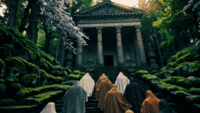
Ephyra is a sacred city, revered as the home of the Oracle of the Normarkian Bassarid religion. Known for its spiritual significance and mystical landscape, Ephyra attracts pilgrims and seekers of wisdom from across the region. Nestled in a valley near the shores of the Strait of Haifa, the city is a beacon of divine insight and cultural richness.
History

Ephyra was established around the Temple of the Seer, where it is believed that the divine voice of the gods speaks through the oracle of Normarkian Bassaridianism, offering guidance and prophecies. Over time, the city has grown into a major spiritual center, with elaborate temples, shrines, and academies dedicated to the study of the divine and the mystical arts. Ephyra’s history is intertwined with the traditions of the Normarkian variant of the Bassarid religion, and it has long been a destination for those seeking enlightenment and communion with the gods.
Geography
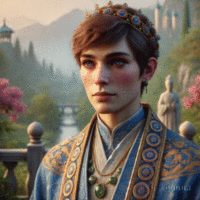
Ephyra is situated in the Vale of Delpa, a lush valley surrounded by the Pythe Spine Mountains. The city is blessed with the sacred waters of the Vygsil Springs, a series of crystal-clear springs that flow through Ephyra, providing both life and mystical energy. The springs are said to have healing properties and are central to the city's spiritual practices. The surrounding landscape is dotted with ancient groves of the Et Khairn Forest, home to the largest single community of Morovian Sasquatch, and legendary flora, including the groves of Golden Oak, whose leaves are believed to grant visions of the future.
Economy
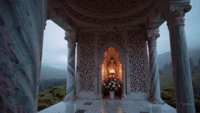
The economy of Ephyra is centered around its spiritual and mystical heritage. The city thrives on pilgrimage tourism, with thousands of visitors flocking to Ephyra each year to seek the Seer’s wisdom and partake in the sacred waters of the Vygsil Springs. Ephyra is renowned for its production of prophetic artifacts, such as the Oracle's Scrolls, inscribed with divinations and crafted from the bark of the Golden Oak. These scrolls are highly sought after for their spiritual significance and are used in rituals and ceremonies throughout the region. Additionally, the city has a vibrant market for enchanted items, healing tinctures and potions made from the sacred waters, and handcrafted talismans believed to bring protection and fortune. The artisanal sector in Ephyra is also known for its exquisite jewelry and ceremonial attire, often adorned with precious stones from the Pythe Mountains and magical herbs from the Et Khairn Forest.
Culture
Ephyra's culture is deeply rooted in its spiritual heritage and the traditions of the Normarkian Bassarid religion. The city's architecture features grand temples, serene shrines, and academies with intricate mosaics and carvings depicting the divine. Cultural life in Ephyra revolves around its religious calendar, with numerous festivals and ceremonies celebrating the divine and the mystical arts. One of the most anticipated events is the Festival of the Sacred Waters, held annually during the spring equinox. During this festival, the entire city is decorated with flowers and banners in shades of blue and gold, symbolizing the purity and divine energy of the Vygsil Springs. The festival begins with a grand procession to the Temple of the Seer, where participants carry offerings of fruits, flowers, and sacred herbs. The highlight of the festival is the Water Blessing Ceremony, where the Oracle herself blesses the springs, and attendees partake in the ritualistic bathing in the sacred waters, seeking healing and spiritual renewal. The festival also features the "Dance of the Divine," a mesmerizing performance by dancers clad in flowing garments that mimic the movement of water, accompanied by ethereal music played on lyres and flutes. The celebration includes storytelling sessions where elders recount the ancient myths and prophecies of the Seer, and feasts featuring dishes made with ingredients from the Et Khairn Forest and fresh fish from the Vygsil Springs. The Festival of the Sacred Waters is a profound celebration of Ephyra’s unique heritage, blending spirituality, tradition, and community in a captivating display of reverence and joy.
Halicarn

Halicarn is a majestic city built around the Grand Tomb of Dragevik, the greatest of all Normarkian heroes. Renowned for its historical significance and breathtaking landscape, Halicarn attracts visitors and devotees who come to honor the legacy of Dragevik and explore its rich cultural heritage. The city is a blend of myth, legend, and vibrant community life.
History
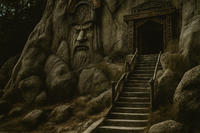
Halicarn was founded in commemoration of the Dragevik, the legendary hero known for his valor and wisdom. The Grand Tomb, a monumental structure crafted from Thalassian purple granite and adorned with intricate carvings, stands at the heart of the city. Over the centuries, Halicarn has grown into a thriving metropolis, with temples, academies, and markets that celebrate the hero's legacy. The city's history is steeped in the tales of Dragevik's adventures and the values he embodied, making it a place of pilgrimage and reverence.
Geography

Halicarn is situated in the verdant Valley of Heroes, surrounded by the Helicon Hills, whose peaks are dotted with ancient ruins and sacred sites. The city is traversed by the Orontes River, a sparkling waterway believed to possess healing properties. The river is fed by the crystal-clear springs of the nearby Asherah Grove, a mystical forest home to enchanted flora and fauna, including the mythical White Horned Bear, said to be a guardian of the land. The Valley of Heroes is known for its lush, fertile land and vibrant greenery, making it an oasis of beauty and tranquility.
Economy

The economy of Halicarn is centered around its historical and cultural heritage. The city thrives on tourism, with thousands of visitors coming each year to pay homage at the Grand Tomb of Dragevik and explore the surrounding sites. Halicarn is famous for its artisanal craftsmanship, particularly in the creation of Dragevik Relics, finely crafted replicas of the hero's weapons, armor, and other legendary artifacts. These relics are highly prized by collectors and historians. Additionally, the city produces healing tonics, tinctures and potions made from the waters of the Orontes River and the herbs of the Asherah Grove. Halicarn's markets are bustling with merchants selling enchanted items, historical texts, and exquisite jewelry adorned with gems from the Helicon Hills. The agricultural sector also plays a significant role, with the fertile valley yielding abundant crops and rare herbs.
Culture
Halicarn's culture is deeply rooted in the legacy of Dragevik and the traditions of heroism and honor. The city's architecture features grand monuments, elegant temples, and academies with detailed frescoes and statues depicting scenes from Dragevik's life. Cultural life in Halicarn revolves around its festivals and ceremonies, which celebrate the hero's deeds and the city's heritage. One of the most anticipated events is the Festival of Valor, held annually during the summer solstice. During the Festival of Valor, the entire city is adorned with banners and wreaths in gold and green, symbolizing courage and renewal. The festivities begin with a grand procession to the Grand Tomb, where participants, dressed as legendary heroes and heroines, offer tributes and recite epic tales of Dragevik's adventures. The highlight of the festival is the Trial of Heroes, a series of competitions that test the strength, skill, and wisdom of the participants, echoing the challenges faced by Dragevik. The festival also includes the "Dance of Triumph," a spectacular performance by dancers clad in shimmering costumes, accompanied by music from lyres, harps, and drums. The celebration features storytelling sessions where elders recount the epic sagas of Dragevik and other heroes, and feasts with dishes made from local ingredients, such as roasted game from the Asherah Grove and fruits from the fertile valley. The Festival of Valor is a profound celebration of Halicarn’s unique heritage, blending history, myth, and community in a captivating display of honor and pride.
Major Cities in Haifan Bassaridia
Keybir-Aviv
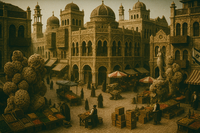
Keybir-Aviv is a historic city located near the eastern shore of Lake Morovia, within the northern Coral Woodlands. This Haifan Bassaridian city is famous for its deep economic and cultural connections to trade, as well as its rich spiritual traditions tied to the Stripping Path. With a significant legacy linked to the Wallis-Haifan Diamond Corporation, the city played a central role in the creation of the Protectorate of the Wallis Islands, the birthplace of the Kingdom of New Zimia and Passio-Corum.
History

Keybir-Aviv holds a unique place in Haifan and Bassarid history. The city was once the home of the Wallis-Haifan Diamond Corporation, a company central to the economy of the Free State of Haifa and instrumental in the creation of the Protectorate of the Wallis Islands. These islands later became the birthplace of the Passio-Corum, which itself would later evolve to become become the Haifo-Pallisican Imperial Trade Union. The corporation’s activities in diamond mining brought immense wealth and influence to Keybir-Aviv, fostering its growth as a key trade hub. Over time, as the city came under Bassarid control, it maintained its importance as both a center for commerce and spiritual activity, with its practitioners preserving many of the original traditions of the Stripping Path.
Geography

Keybir-Aviv is located near the eastern shore of Lake Morovia, within the northern Coral Woodlands, near the western edge of the Valley of Abeis. The Coral Woodlands are a unique forest characterized by ancient, millennia-old giant coral formations, which give the region its distinct landscape. The city's proximity to Lake Morovia ensures it remains a critical node in connecting northern and southern Lake Morovia, while also linking the Haifan Plateau and Peninsula to the wider region, including the Strait of Haifa.
Economy
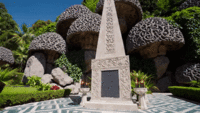
The economy of Keybir-Aviv has long been driven by its strategic position along Lake Morovia, serving as a critical link between the northern and southern shores of the lake. Historically, the city benefited immensely from the diamond industry, particularly through the Wallis-Haifan Diamond Corporation, which established the city as a powerful economic force. In modern times, trade continues to be the lifeblood of Keybir-Aviv’s economy, with its port facilitating commerce between the Haifan Plateau, the Strait of Haifa, and other important Bassarid and Haifan regions.
Culture
Keybir-Aviv stands as a cultural stronghold of traditional Stripping Path philosophy, preserving the ancient practices that have defined its spiritual life for centuries. Unlike much of Bassaridia Vaeringheim, where the Reformed Stripping Path has gained prominence, Keybir-Aviv remains steadfast in its adherence to the original faith. Local cults honor Hermes, the patron deity of the city, as well as lesser deities like the Western Wind, through vibrant festivals and public rituals that celebrate their enduring connection to the ancient Stripping Path traditions.
The city’s cultural calendar is marked by significant festivals, such as Sanashalros on Atosiel 54, a mystical celebration of Host Star Sanashalo’s zenith. This event is characterized by midnight rites featuring rhythmic drumming and trance dances, reinforcing the city’s devotion to its spiritual heritage. These ceremonies, along with daily acts of worship and community gatherings, highlight Keybir-Aviv’s commitment to preserving its ancient identity while fostering a deep sense of unity among its people.
Keybir-Aviv’s unwavering dedication to the traditional Stripping Path and its vibrant cultural expressions make it a bastion of spiritual and historical continuity in Bassaridia Vaeringheim, ensuring its place as a unique and deeply revered city.
Tel-Amin
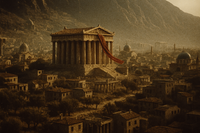
Tel-Amin is a historic city located near the western shore of the Southern Strait of Haifa, within the dense and ancient Coral Woodlands. It is the southernmost of the original Haifan cities and holds great significance both economically and culturally in the region. Famous for its spiritual practices tied to the traditional Stripping Path, Tel-Amin also played a key role during the Haifan Civil War, becoming a contested battleground.
History

During the Haifan Civil War, Tel-Amin became one of the main focal points of the conflict. Situated in a strategically crucial position along the Strait of Haifa, the city was fiercely contested by the New Zimian War League and the Jezeri forces. It was eventually captured by the Bassarid forces after a series of air raids and naval blockades, marking a significant victory in the war. The battle for Tel-Amin was especially intense due to its proximity to important overland trade routes and access to maritime markets. After the war, Tel-Amin remained under Bassarid control, helping to solidify their dominance in southern Haifan Bassaridia.
Geography
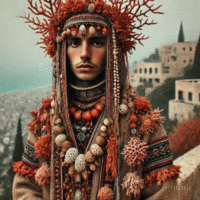
Tel-Amin is located along the eastern shore of the Southern Strait of Haifa in the region known as the Plains of Melusine. The region is part of the Coral Woodlands, which are famous for their ancient and dense coral formations. Unique to the area are the skeletons of massive mermaid-like beings that protrude from the ground. The city’s position on the strait has historically made it an important point along trade routes, facilitating connections between the Haifan Peninsula and the Maritime Markets.
Economy
Tel-Amin’s economy has long been supported by its location along key overland trade routes that connect the Haifan Peninsula to the Maritime Markets of the Strait of Haifa, particularly the city of Mylecia, which remains under the control of the Imperial Federation. The city’s strategic location has also made it a haven for pirates and smugglers throughout history, including the legendary Captain Ismael Hatch. Its proximity to maritime and overland trade networks continues to support its economy, even after the war.
Culture
Tel-Amin’s culture is deeply rooted in the traditional practices of the Stripping Path, standing in contrast to the Reformed Stripping Path more commonly embraced in northern Haifan regions. The city’s patron deity, Apollo, is at the center of its spiritual life, with worship practices that honor his divine influence. Additionally, Tel-Amin is distinguished by its unique cult devoted exclusively to the Host Spirit, setting it apart from other sects or mysteries within the Stripping Path. This spiritual independence, combined with its adherence to traditional rituals, establishes Tel-Amin as a pivotal center of religious life in southern Haifa.
Among the city’s most notable celebrations is Ocanarion, held on Thalassiel 60. This festival features water purification ceremonies dedicated to Host Star Ocananus, culminating in the release of floating candles on rivers and lakes. The event symbolizes the city’s devotion to cleansing and renewal, reinforcing its spiritual identity. Through such rituals, Tel-Amin maintains its deep connection to the Stripping Path’s ancient traditions while fostering a distinct and enduring cultural identity.
Tel-Amin’s commitment to its traditional practices and spiritual independence ensures its role as a vital religious and cultural hub in the southern Haifan region, where the Stripping Path’s timeless teachings continue to thrive.
Diamandis

Diamandis is a major city located south of Tel-Amin, near the famed Valley of Diamonds. It serves as a key economic and cultural hub in southern Haifan Bassaridia, particularly for the region's lucrative diamond trade. The city is home to the Merchants of the Valley of Diamonds, a prominent company based in the General Port of Lake Morovia, further highlighting its importance in both regional and international commerce.
History
Diamandis’s historical importance stems from its proximity to the Valley of Diamonds, which has long been a source of immense wealth due to its abundant diamond deposits. The city grew into a center of commerce, particularly in the diamond trade, attracting merchants from across the region and beyond. Throughout its history, Diamandis has played a key role in trade networks that span the Haifan Peninsula and the greater Bassaridian economy, with its strategic location making it a focal point for economic activity.
Geography
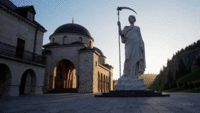
Diamandis is situated near the Valley of Diamonds, surrounded by fertile plains that provide important overland trade routes. Its location is pivotal, connecting it to the broader economic landscape of Haifan Bassaridia, especially trade networks that span the Haifan Peninsula, the southern plains, and the Strait of Haifa. The region is rich in natural resources, most notably diamonds, making it an essential economic engine for the area.
Economy

The economy of Diamandis is driven by its proximity to the diamond mines of the Valley of Diamonds. The Merchants of the Valley of Diamonds, a company headquartered in the General Port of Lake Morovia, operates extensively in Diamandis, ensuring that diamonds from the valley reach both regional and international markets. In addition to diamond trade, the city benefits from overland trade routes that link it with neighboring regions and major hubs like Mylecia, enhancing its status as an economic powerhouse in southern Haifa.
Culture
Diamandis, a city deeply devoted to the traditional Stripping Path, shares much of its cultural heritage with its neighboring Haifan cities while maintaining distinct traditions that reflect its unique identity. Aphrodite, the city’s patron deity, is at the heart of its spiritual practices, with diamond-related symbolism woven into rituals and ceremonies. This connection to the wealth and prosperity brought by the surrounding valley integrates the city’s economic lifeblood into its spiritual identity, blending commerce with reverence for the divine.
The city’s cultural calendar includes significant festivals that highlight this unique relationship. Osirionos, held on Thalassiel 46, is a spirited celebration dedicated to Host Star Osiríos, during which flower-draped streets and pyrotechnic displays transform the city into a vibrant spectacle of light and color. Another notable event is Danassion, observed on Opsitheiel 13. This somber day includes cemetery-side vigils and modest feasts to honor Host Star Danaß, bridging the living and the departed in quiet reflection. Both festivals underscore the city’s reverence for divine and earthly prosperity, balancing celebratory joy with moments of introspection.
Diamandis thrives as a city where faith and wealth coexist, its diamond-related rituals and deep devotion to Aphrodite fostering a cultural identity that blends spiritual reverence with material prosperity. This unique harmony ensures Diamandis’s place as a radiant and spiritually rich center in the Haifan region.
Jogi
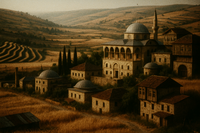
Jogi is a city located on the eastern shore of the Southern Strait of Haifa and is unique among the Bassaridian cities for having originally been established as part of the Maritime Markets of the Strait of Haifa. The city has historically been regarded as the "breadbasket" of the Southern Strait, playing a vital role in the region's agriculture and trade. Its strategic location, combined with its agricultural output, has allowed Jogi to thrive as a key player in the Bassaridian economy.
History
Founded by the Independent Realm of Ergonia in 30.94 PSSC, Jogi was established as part of a larger effort to develop the original Trans-Keltian Railway. Initially, it became a haven for pirates and tradesmen, many of whom took advantage of the region’s relative lawlessness following the collapse of Ergonia. Jogi later aligned with the Bassarids, solidifying its place as a hub within the Maritime Markets of the Strait of Haifa, a network of pirate-run trade hubs. The city continued to flourish under Bassarid control, but pirate activity remained an ongoing issue due to the region's historic ties to piracy and smuggling.
Geography

Jogi is situated on the eastern shore of the Southern Strait of Haifa, in the region known as the Plains of Jogi. The area is characterized by fertile valleys and plains, making it ideal for agriculture. The climate of the region is temperate, which supports the cultivation of various crops that have earned Jogi its reputation as the breadbasket of the Southern Strait.
Economy
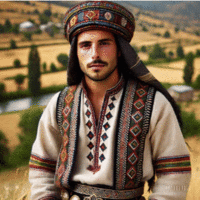
Jogi’s economy has long been based on agriculture, with several important agricultural producers and exporters operating out of the city. The fertile plains of the surrounding area support the cultivation of wheat, oats, and other staple crops. Additionally, the city is home to the Ale of the Night Central Brewery, known for its hallucinogenic beer that has become popular among the region’s pirates. Jogi's agricultural exports, combined with its position along key overland and maritime trade routes, make it a critical part of the Bassaridian economic system.
Culture
Culturally, Jogi is aligned with the traditional Stripping Path, similar to other cities in the Southern Strait. The city’s religious practices are distinct from the Reformed Stripping Path found in the northern regions of Bassaridia. Instead, the people of Jogi maintain traditional worship practices, paying homage to deities such as Apollo, who is revered as the city's patron deity. In addition to its religious significance, Jogi remains culturally tied to its origins within the Maritime Markets, with a continued connection to piracy and smuggling that has shaped its local identity.
Lewisburg
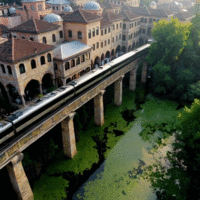
Lewisburg, located in the swampy and heavily forested western interior of Haifan Bassaridia, was originally established as a vital hub connecting the Hammish region of Haifa to the Kingdom of Hamland’s core territories in western Keltia. Over centuries, its strategic location cemented its role as a trade, cultural, and political center. Today, it thrives as a major depot along the Trans-Bassaridia Railway, facilitating trade and transportation across Bassaridia Vaeringheim. However, Lewisburg's culture and identity remain profoundly shaped by the dark legacy of the Order of Rochefort and the Southern Lake Morovia Campaign, which ended the order's influence and ushered in a new era for the city.
History
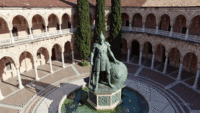
Founded by the Kingdom of Hamland, Lewisburg initially served as a logistical and administrative hub linking the Hammish territories of Haifa with the greater kingdom. It played a key role in facilitating the movement of goods and people, becoming a cornerstone of regional trade networks. Under the Kingdom of Caputia, Lewisburg rose to prominence but also became the epicenter of one of the darkest chapters in the region’s history. The city served as the headquarters of the Order of Rochefort, an anti-Bassarid extremist organization responsible for orchestrating the genocide of practitioners of the Stripping Path during the 36th Era PSSC. This period left deep scars on Lewisburg’s social and cultural fabric, as the Order’s influence entrenched division and persecution. The Southern Lake Morovia Campaign during the 50.40s PSSC marked a turning point in Lewisburg’s history. This brutal and complex military campaign by Bassaridia Vaeringheim sought to dismantle the remaining vestiges of the Order of Rochefort. The campaign combined military force with cultural reintegration efforts, ultimately eliminating the Order’s presence and annexing Lewisburg into Bassaridia Vaeringheim. While this transformation allowed the city to rebuild and thrive, the echoes of its turbulent past still resonate in its cultural identity.
Geography
Lewisburg is located in the swampy lowlands and dense forests of western Haifan Bassaridia, characterized by elevated infrastructure to mitigate seasonal flooding. The surrounding wetlands and forests provide timber, medicinal plants, and a rich ecosystem supporting the local economy. Its strategic position near the western shore of Lake Morovia makes it a critical hub along the Trans-Bassaridia Railway, which connects southern Haifan Bassaridia to northern New South Jangsong. The city’s location ensures its role as a vital link between regions, reinforcing its economic and logistical significance.
Economy
The city's economy is anchored by its position as a major depot along the Trans-Bassaridia Railway. Serving as a conduit for goods moving between Haifan Bassaridia, Bassaridia Vaeringheim Proper, and New South Jangsong, Lewisburg facilitates the exchange of agricultural products, artisanal crafts, and advanced technologies. Its bustling markets and industrial zones reflect its role as a key player in the Bassaridian trade network.
Natural resources from the surrounding wetlands, including timber and herbal medicines, further diversify the economy, while the railway supports continuous urban growth. The integration of Lewisburg into the larger Bassaridian economy after the Southern Lake Morovia Campaign allowed the city to overcome its historical stagnation and embrace modernization.
Culture
The culture of Lewisburg remains significantly impacted by its dark past as the center of the Order of Rochefort and the trauma of the Southern Lake Morovia Campaign. While the city has embraced Bassaridian unity and the Reformed Stripping Path, the legacy of persecution and violence has left lasting imprints. Annual commemorations and festivals honor the resilience of the Stripping Path’s practitioners and the victory over the Order, blending sorrowful remembrance with celebrations of renewal and unity. Monuments and shrines to the Reformed Stripping Path stand alongside preserved ruins of the Order’s former strongholds, serving as stark reminders of the city’s transformation. Many of the city’s cultural traditions reflect themes of resilience and reconciliation, with art, music, and storytelling often addressing the struggle against oppression and the hope for a harmonious future. The city’s cuisine and crafts showcase its diverse influences, incorporating flavors and styles from its Hammish, Caputian, and Bassaridian heritage. However, the dark legacy of its past adds a layer of introspection to its cultural identity, as Lewisburg continues to reconcile its history with its role as a thriving modern hub in Bassaridia Vaeringheim. Lewisburg stands as a symbol of both the atrocities of the past and the potential for renewal and growth, a city forever shaped by its history yet looking toward a unified future.
Minor Cities in Haifan Bassaridia
Thermosalem
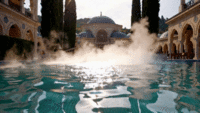
Thermosalem is a serene city renowned for its natural hot springs, a place where wellness and tranquility are deeply embedded in its identity. The city's springs have drawn visitors for centuries, making it a destination for healing and rejuvenation. Surrounded by rolling hills and forests, Thermosalem offers a perfect retreat from the stresses of life, with its economy and culture centered on the benefits of nature and wellness.
History
The history of Thermosalem dates back centuries, originating as a small settlement centered around the city's famed hot springs. These springs were believed to have healing properties, and the site became a pilgrimage destination for those seeking natural remedies. Over time, the city grew as health-focused travelers and settlers came to build around the springs. While other regions were often caught in political upheavals or warfare, Thermosalem remained a peaceful haven, its growth fueled by a dedication to wellness and a reputation as a place of rejuvenation.
Geography
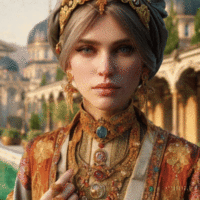
Thermosalem is nestled in a picturesque valley surrounded by gently rolling hills and verdant forests. The city’s landscape is defined by natural hot springs, which bubble up from beneath the earth, creating a network of thermal baths throughout the area. Lush vegetation thrives in the humid climate created by the springs, and the city is crisscrossed by small streams that flow into nearby rivers. The surrounding hills act as a natural barrier, making the city feel secluded and tranquil, with hiking trails and pathways weaving through the scenic countryside.
Economy
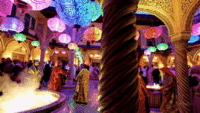
The city’s economy revolves around its natural springs, with wellness tourism forming the backbone of its financial structure. Thermosalem's thermal baths and health retreats draw visitors from near and far, providing services such as spa treatments, meditation, and eco-friendly lodging. Local artisans sell products inspired by the springs, such as natural skincare products, herbal remedies, and handmade crafts. Farming and small-scale agriculture also play a role in supporting the city's needs, with local produce and herbal ingredients contributing to the wellness-focused culture.
Culture
Thermosalem’s culture is intricately tied to its connection with nature and its emphasis on healing, both physical and spiritual. The city fosters a slow-paced, mindful lifestyle, with many residents devoted to professions in health, natural medicine, and wellness. Community life often revolves around meditation, herbal medicine workshops, and conservation efforts, creating a harmonious balance between human activity and the natural environment.
This focus on harmony is celebrated through several significant festivals. Orebellion, observed on Atosiel 44, brings the streets alive with vibrant markets and fire-breathing displays, paying homage to the energetic spirit of Host Star Orebele. Later in the year, Tävrosion on Thalassiel 17 invites contemplative meditation and soft chanting dedicated to Host Star Tä, reflecting the city’s introspective and spiritual ethos. Aprobellium, celebrated on Opsitheiel 58, transforms Thermosalem with glowing red lanterns, acrobatic performances, and the enjoyment of spicy festival drinks in honor of Host Star Aprobelle.
Through these traditions and its daily mindfulness practices, Thermosalem thrives as a sanctuary of renewal, fostering a culture deeply rooted in healing, celebration, and the harmony of life and nature.
Akróstadium
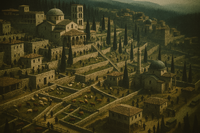
Akróstadium is a small, fortified city originally established as a monastery for initiate officers and commanders of the War League. Built on a strategic hill, the city reflects a deeply martial heritage, with its architecture and traditions emphasizing discipline, strength, and training. Today, the economy is driven by pastoralism, with local ranchers raising Morovian Water Buffalo, South Haifan Camels, and sheep.
History

Founded as a monastery for the training of War League officers, Akróstadium was designed as a place of discipline and military instruction. The city’s role evolved over time, but its martial roots remain central to its identity. The once-monastic center became a hub for strategic military contests and exercises, drawing in recruits and commanders from across the region to train and sharpen their skills.
Geography
Akróstadium is situated atop a prominent hill, overlooking vast plains and rugged landscapes. Its elevated position gives the city a natural defensive advantage and provides stunning views of the surrounding terrain. The hill’s slope is terraced, with fortified walls and rows of buildings leading up to the city’s grand stadium, the heart of its traditional military activities.
Economy

Today, Akróstadium’s economy revolves around pastoralism. The city is home to many ranchers who raise Morovian Water Buffalo, South Haifan Camels, and sheep. These livestock are vital for local commerce, with wool, milk, meat, and hides being traded. Though its military past is ever-present, the city’s shift to pastoralism represents a harmonious blend of tradition and modern livelihoods.
Culture
Akróstadium’s culture is shaped by its deep ties to the Reformed Stripping Path, guided primarily by the Azure Sentinel Sect, a powerful cult devoted to the Empress Goddess Thalassa. The city’s major temple serves as a hub for spiritual guidance, worship, and vibrant festivals, reflecting its role as a center of religious and cultural life. However, Akróstadium’s cultural identity is also strongly influenced by its martial heritage and the traditional Stripping Path, particularly among those who honor Aphrodite as the city’s patron deity. This blending of old and new traditions creates a unique atmosphere where honor, discipline, and reverence for the divine coexist.
The city’s cultural calendar includes notable celebrations that reflect its spiritual and martial roots. Bebekarion, observed on Atosiel 61, brings the community together for communal feasts honoring Host Star Bebeakaus, with each meal opening with a unifying toast that embodies the city’s commitment to harmony and tradition. These gatherings reinforce Akróstadium’s dedication to both spiritual and communal values, balancing its devotion to the Reformed Stripping Path with its respect for historical practices.
Akróstadium’s dual devotion to Thalassa and Aphrodite, coupled with its strong sense of tradition and military pride, ensures its status as a city where faith and honor are intricately intertwined. This unique cultural blend makes Akróstadium a beacon of both spiritual depth and historical legacy in the region.
Sufriya
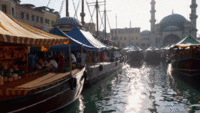
Sufriya is a bustling cultural hub located on the western shore of the Strait of Haifa, strategically positioned south of the former Haifan capital Abeis and near the boundary with the Imperial Federation. The city’s rich history, shaped by its role during the Haifan Civil War and its diverse cultural influences, makes it an essential trade and cultural center within Bassaridia Vaeringheim.
History

Founded during the height of the Haifan Civil War, Sufriya emerged as a vital base for merchants, spies, and pirates operating around the eastern Abeisan Inlet and archipelago. These groups used the city to transport goods, gather intelligence, and plunder ships and sea-ports. Its strategic location along the Strait of Haifa provided easy access for those seeking to control regional trade routes. In the war's aftermath, the city began to formalize its operations and develop into a center of legitimate commerce and cultural exchange, while still retaining the clandestine undertones from its early days.
Geography
Sufriya is situated along the southern coast of the Strait of Haifa, just south of Abeis, the former capital of Haifa, and near the border between Haifan Bassaridia and the Imperial Federation. It occupies a critical point along the eastern boundary of the Abeisan Inlet, giving it direct access to maritime trade routes that connect Lake Morovia with the Southern Strait. The city’s geography, with its coastal location and proximity to both Haifan and Imperial territories, continues to make it a pivotal hub for sea-based trade.
Economy

The city’s economy thrives on its role as a major trade hub, particularly for companies operating out of the General Port of Lake Morovia. Key businesses such as the Plains of Jogi, Ale of the Night Central Brewery, and the Thalassian Granite Export Cooperative use Sufriya as an important transit point for goods passing between the Southern Strait and Lake Morovia. Its ports bustle with ships carrying textiles, foodstuffs, ale, granite, and more, as Sufriya’s merchants manage the flow of goods vital to the Bassarid economy.
Culture
Sufriya is a vibrant cultural mosaic, shaped by the fusion of Haifan and Bassaridian traditions, with additional influence from its Jezeri population. This diversity creates a unique blend of religious, artistic, and spiritual practices, as residents embrace traditions from the Stripping Path, the Reformed Stripping Path, and belief systems originating in New South Jangsong. The city’s position as a hub for trade and interaction with travelers from the Southern Strait, Lake Morovia, and beyond further enriches its cultural identity, making Sufriya a dynamic and inclusive center of commerce and spirituality.
This diversity is showcased in the city’s festivals, which highlight its artistic and spiritual life. Dilëtazorium, celebrated on Thalassiel 10, is a reflective day dedicated to Host Star Dilëtaz, marked by quiet acts of charity and an abstention from loud festivities. Later in the year, Hazamorium on Opsitheiel 23 sees devotees ascend hills to watch the stars under Host Star Hazaméos, interpreting cloud movements as portents of fate. These festivals encapsulate Sufriya’s ability to harmonize maritime significance, spiritual depth, and artistic expression into cohesive celebrations.
Sufriya’s cultural richness and its balance of spiritual traditions, artistic endeavors, and economic vitality position it as one of the most dynamic and diverse cities in the region, embodying the interconnectedness of cultures across Bassaridia and beyond.
Lykopolis

Lykopolis is a city of great spiritual and industrial significance, located northwest of Mylecia in the heavily forested and coal-rich region of the Valley of Haifa. The city is defined by its continuing devotion to the Priestess of Agripinilla and its role as the home of the Mylecian Coal Ports.
Geography
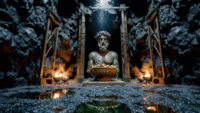
Lykopolis is set in a rugged, forested landscape dotted by ancient and contemporary coal mines. Many of these abandoned mines have been converted into shrines and temples dedicated to the Priestess of Agripinilla, Dionysus, and various regional deities. These sacred spaces host mysterious rites practiced by some of the most ancient Bassarid cults, preserving traditions that have persisted for centuries. The dense forests and scarred earth give Lykopolis a unique character, where industrial activity coexists with deep spiritual reverence.
History
Lykopolis has a profound connection to the Stripping Path, with a longstanding reverence for the Priestess of Agripinilla, once regarded as the High Priestess of the Stripping Path and oracle of the Host Spirit. The city’s religious traditions have always been closely tied to its industrial development, with spiritual authority guiding much of its growth. Although the Priestess’s influence has waned across most of Bassaridia, Lykopolis remains one of the last bastions of her power, where her spiritual guidance continues to shape the city’s identity.
Economy

The city is economically driven by its coal industry, with the Mylecian Coal Ports playing a central role. Established in 33.66 PSSC as part of the Port of Mylecia, the Mylecian Coal Ports are one of the oldest companies featured on the General Port of Lake Morovia. Coal from Lykopolis fuels industries across Bassaridia Vaeringheim, and the city's connection to the broader trade network via Lake Morovia and the Strait of Haifa makes it a key player in regional commerce. Mining and export dominate the city's economy, providing vital resources and employment for the population.
Culture
Lykopolis is a city where industrial heritage and spiritual devotion intertwine, creating a unique cultural identity centered on reverence for Bacchus, the city’s patron deity, and the influential Priestess of Agripinilla. While not the official head of government, the Priestess wields significant power, shaping the city’s social and political landscape. Lykopolis’s cultural life revolves around Dionysian rites, with many festivals and public rituals celebrating the city’s deep connection to Bacchus. The former coal mines, now transformed into sacred shrines, serve as focal points for religious practices, hosting ancient Bassarid cults that carry out their rites in secret, preserving the city’s historical and spiritual roots.
The city’s devotion to Bacchus is evident in its significant festivals, including Dranamorium, observed on Thalassiel 56. This contemplative day is dedicated to Host Star Dranamos and features journaling, spiritual readings, and communal silence, embodying the city’s balance of reflection and reverence. These ceremonies, combined with Lykopolis’s industrial and spiritual legacy, highlight its ability to harmonize economic activity with profound religious traditions.
Lykopolis thrives as a city where history, industry, and faith converge. Its sacred shrines, Dionysian rites, and the enduring influence of the Priestess of Agripinilla ensure its place as a cultural and spiritual beacon in the region, offering a powerful blend of economic strength and spiritual depth.
Major cities in Bassaridian Normark
Ardclach
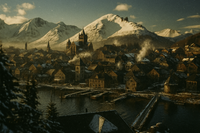
Ardclach, a coastal port city, was originally established during the period of the Grand Kingdom of Normark, the city has maintained strategic importance through multiple political transitions and military developments. Following its surrender during the Lower Jangsong Campaign and subsequent annexation by Bassaridia Vaeringheim, Ardclach was designated as the capital of the newly formed territory of Bassaridian Normark.
Geography
Ardclach is situated on the southern coast of the arctic island of Aderstein. The island is defined by its rocky coastal forests and a mountainous interior. It experiences a Subarctic climate characterized by short, cool summers and long, cold winters with heavy snowfall. The region is frequently subject to blizzards, sea storms, and avalanche risks, all of which have influenced settlement patterns and the development of local infrastructure.
History
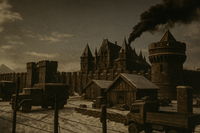
Ardclach was established during the period of the Grand Kingdom of Normark around 21.34 PSSC. The city continued to thrive even as Normark was annexed by Elwynn and later by Natopia, maintaining its status as a vital maritime and economic center. After Normark was re-established as an independent nation, Ardclach was chosen in 44.63 PSSC as the site for a major Nordhær base, reinforcing its military significance. During the ensuing Normark-Cerulea War and in the wake of the outbreak of Northern Keltia respiratory syndrome, the East Keltian Collapse occurred, resulting in the withdrawal of most military equipment by Normark’s former allies. This demilitarization left the city vulnerable during the Lower Jangsong Campaign, and after only a single day of naval and aerial bombardment, Ardclach surrendered. In the aftermath, the city was annexed by Bassaridia Vaeringheim and established as the capital of the newly formed territory of Bassaridian Normark.
Economy
Ardclach’s economy has evolved in response to its strategic coastal location and the challenges of its subarctic environment. Initially, the city developed as a center for maritime trade and resource extraction from the rocky forests and mountainous terrain of Aderstein. In its early period, Ardclach was extensively involved in trade with the Raspur-affiliated ESB Group (Keltia), a relationship that significantly bolstered its economic growth. The establishment of the major Nordhær base also stimulated defense-related activities, including ship repair, maintenance, and logistical support services. However, following the East Keltian Collapse and the subsequent annexation by Bassaridia Vaeringheim, the city’s economic orientation shifted. Trade interests realigned to support the General Port of Lake Morovia, and local industries adopted advanced cold-climate technologies. Today, Ardclach hosts a diversified economy that includes modern maritime shipping operations, specialized manufacturing for cold-weather infrastructure and equipment, timber harvesting, mineral extraction, and a network of small-scale artisanal enterprises, all contributing to its resilient economic base.
Culture
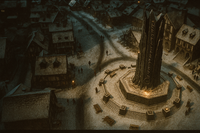
The cultural identity of Ardclach is rooted in its historical legacy and shaped by its harsh natural surroundings. Founded under the traditions of Normark, the city developed a cultural framework that emphasized maritime practices and community resilience. The period during which the major Nordhær base was active left a lasting imprint on the local martial tradition. The events of the East Keltian Collapse and the rapid surrender during the Lower Jangsong Campaign have become integral components of the city’s collective memory. With the subsequent annexation by Bassaridia Vaeringheim and the establishment of Bassaridian Normark, additional cultural influences emerged, resulting in a blend of Normarkian and Bassaridian traditions. Contemporary cultural practices in Ardclach—reflected in festivals, artistic expressions, and communal rituals—continue to emphasize themes of survival, adaptation, and remembrance, thereby preserving and evolving the city’s unique identity.
Riddersborg

Riddersborg is a prominent coastal city on the far northern coast of Keltia, situated to the northwest of the northern mouth of the Strait of Haifa. Serving as a major hub along the Trans-Keltian Express—a vast railway network connecting key northern nations such as Mercury and Moorland—the city has long been integral to regional transportation and commerce. In addition, Riddersborg is home to the University of Riddersborg, established during the era of Elwynn's rule over Normark, which serves as a vital center of learning and significantly contributes to the city's economic vitality.
Geography
Riddersborg is located on the far northern coast of Keltia, near the northern mouth of the Strait of Haifa. The city experiences a Subpolar Oceanic climate, with cool summers and cold winters. Frequent coastal storms, storm surges, blizzards, and occasional flooding are common in the area, necessitating resilient infrastructure and adaptive urban planning. This challenging environment has both shaped the local economy and influenced the development of the city over time.
History
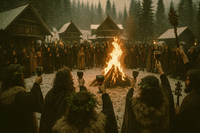
Riddersborg’s historical development parallels that of other coastal centers in Keltia, yet it is marked by distinctive influences stemming from regional conflicts. Following its early establishment as a maritime and trade hub, the city was profoundly impacted by the War of the Harpy. The high level of violence and subversive tactics characteristic of that conflict, combined with Riddersborg’s proximity to Jangsong, transformed the city into a critical battleground for competing ideologies, especially those of the chaotic Stripping Path religion and the political and religious ideologies of Natopia. In the immediate aftermath of the war, Riddersborg came under the influence of the Pallisican Pretender Government of Elijah's Rest, a pretender regime based in Jangsong and supported by the newly established Bassarids. This government’s existence served to prolong the conflict by decades, contributing to a sustained period of heightened political tensions on a global scale.
During the subsequent Lower Jangsong Campaign, Riddersborg experienced intense fighting for 12 days in both the surrounding areas and within the city itself—a battle recognized as the largest in the history of the Bassaridian War League. The determined resistance of Riddersborg’s defenders, shaped by the city's recent experiences during the War of the Harpy, far exceeded that of other cities such as Ardclach, which surrendered after only a single day of naval and aerial bombardment. Ultimately, after the protracted and brutal conflict, Riddersborg surrendered and was annexed by Bassaridia Vaeringheim, marking a significant turning point in its history.
Economy
Riddersborg’s economy has evolved from its origins as a maritime trade center into a dynamic and multifaceted system, significantly bolstered by its strategic position along the Trans-Keltian Express. Historically, the city’s port supported extensive shipping logistics, cargo handling, and vessel repair services, facilitating the exchange of goods across Keltia. The integration of rail transport through the Trans-Keltian Express has further expanded Riddersborg’s economic influence, linking it directly to major markets in Mercury, Moorland, and beyond. Additionally, the University of Riddersborg plays an important role in the local economy, attracting students, researchers, and related industries, thereby stimulating growth in services and technology sectors. Local industries have adapted to the challenging Subpolar Oceanic climate by adopting advanced weather-resistant technologies, enabling robust sectors in fisheries, timber harvesting, and mineral extraction. This blend of maritime, rail, and academic influences has solidified Riddersborg’s role as a resilient economic hub, capable of withstanding both environmental adversities and the disruptive impacts of regional conflicts.
Culture
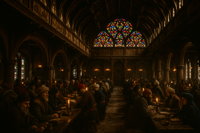
The cultural identity of Riddersborg is a composite reflection of its maritime heritage, wartime experiences, and modern connectivity. Long rooted in centuries of seafaring and trade traditions, the city’s local culture was profoundly transformed by its direct involvement in the War of the Harpy, which instilled a legacy of defiance and resilience. The influence of the Pallisican Pretender Government of Elijah's Rest—and its role in extending the conflict—has left an indelible mark on the collective memory of Riddersborg’s inhabitants. This spirit of resistance was further embodied during the grueling 12-day battle of the Lower Jangsong Campaign, a defining episode in the city’s history. Following its eventual annexation by Bassaridia Vaeringheim, Riddersborg absorbed additional cultural influences from the Bassarid regime. Today, the city's vibrant cultural scene is enriched not only by its status as a major transportation hub along the Trans-Keltian Express but also by its academic contributions through the University of Riddersborg. Local festivals, public art, and commemorative events continually celebrate themes of survival, adaptation, and resistance, reflecting both the city’s storied past and its ongoing evolution in a complex geopolitical landscape.
Major cities in the Ouriana Province
Bashkim
History
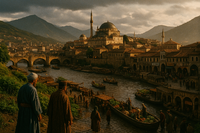
Bashkim’s importance stems from its location at the confluence of the Verdhe River, Sev River and Kesk River. This strategic site fostered a trading post and meeting place for hundreds of years. The name “Bashkim”, meaning “convergence” in Verdhese, reflects both the merging rivers and the merging of peoples and cultures.
For much of its history, the city served as a neutral frontier polity on the eastern flank of Bassaridia Vaeringheim. Merchants from different regions moved freely between its districts, and Bassaridian shrines operated openly while the city maintained its civic autonomy. Bashkim’s neutrality and status as a conduit of spiritual exchange and trade made it a linchpin of regional stability.
In early 51 PSSC, during the Valley of Keltia Campaign, Bashkim’s neutrality was exploited by insurgent groups. Intelligence gathered by the Council of Kings Division revealed that fugitives from the Greater Morovian Independence Initiative and the Order of Rochefort were using the city’s warehouses and guild halls as sanctuaries. Dark-cult operatives even conducted veiled rites under the guise of civic worship.
To end this insurgent occupation, the Bassaridian War League and the Imperial Federation launched Operation Bashkim on 3 Opsitheiel 51 PSSC. A Centuria (about 373 soldiers) supported by Imperial Marines entered the city, aiming to disrupt embedded command networks while minimizing civilian casualties. Heavy rainfall triggered mudslides that hampered logistics, and insurgents laid traps along the approaches. Nevertheless, Bassaridian forces fought through the city’s dense alleyways and eventually secured the central plaza, merchant hubs and inner shrine belt by 11 Opsitheiel. Civil order was restored, shrine governance reinforced and trade corridors re‑established.
After the campaign, Bashkim and the neighbouring cities of Tonar and Ourid were formally secured. The region between the Lacaran Mountains and the Eastern Caledonian Highlands was annexed as a dependency of Bassaridia Vaeringheim under a constitutional amendment. Some of the city’s traditional councils continue to operate informally, but political authority ultimately rests with Bassaridian officials.
Geography
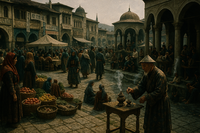
Bashkim occupies a low rise where the Verdhe River, Sev River and Kesk River meet. These waterways provide natural transport routes, making the site a central hub for trade. The broader valley lies between the northern slopes of the Lacaran Mountains and the southern edge of the Eastern Caledonian Highlands, giving the city a temperate high‑valley climate. Fertile river terraces support market gardens and orchards, while the surrounding highlands supply timber and minerals. The rivers also function as natural defensive moats around the historic core of Bashkim.
Economy
The local economy is still built on trade, as it has been for centuries. Bashkim’s position at the junction of three navigable rivers makes it a clearinghouse for agricultural goods from the surrounding valley and manufactured items from Bassaridia’s industrial centres. During its era of neutrality, merchants from neighbouring polities established warehouses and shrines, turning Bashkim into a cosmopolitan marketplace. Although Operation Bashkim disrupted commerce, the campaign’s end saw trade corridors swiftly reopened and linked to Bassaridian logistics routes.
As a dependency, Bashkim’s economy has become closely integrated with Bassaridia Vaeringheim. River‑borne trade remains vital, but administrative and military functions now play a larger role. The city hosts Bassaridian civil servants, Temple Bank auditors and War League detachments, creating demand for services, housing and supply industries. Informal markets continue in the old quarters, where pilgrims and traders from diverse backgrounds meet.
Culture
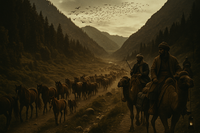
Bashkim remains one of the most linguistically and culturally diverse cities in Keltia. Despite its Verdhese name, the three former official languages of the United Cities of the Vales are still widely spoken, alongside Istvanistani, Alexandrian, Ralgonese, Martino, Norse, Elw, Babkhi, Calbic and many other tongues. This multiplicity reflects the city’s history as a meeting point for traders and pilgrims. Shrines and temples from different traditions coexist, and festivals often blend Bassaridian religious rites with older Verdhese customs.
The Council of the Twelve and the Assembly of the Vales once convened in Bashkim, making the city a centre of deliberative politics. Although those institutions no longer hold formal power, their legacy persists in local neighbourhood councils and in a civic culture that values debate and consensus. Since annexation, Bassaridian administrative and military presence has grown, but Bashkim’s identity as a place of convergence—of rivers, peoples and ideas—continues to shape its social life.
Ourid
History
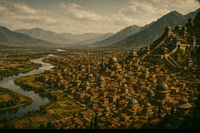
According to records from the United Republic of Borealia, Ourid began as a small urban settlement within Borealia’s federal structure located in northern Keltia. The republic was a multinational, secular federal democracy with its capital at Karenja. In 1702 AN, the Borealian census listed the towns of Ourid and Inola among its urban centres, contributing to a national population of 39,280,117. During this period, Ourid functioned as a lakeside community on Lake Caledonia (Loch Alba), its economy focused on fishing and lacustrine trade.
Over subsequent decades, political realignment and migration drew Ourid southward into the Ouriana Basin of the southernmost Eastern Caledonian Highlands. Its remote location, extensive shrines and proximity to the Ouriana River (which flows from the highlands into Lake Morovia) made it attractive to insurgent groups fleeing defeats elsewhere. Intelligence gathered by the Council of Kings Division identified Ourid as the administrative and spiritual redoubt of a consolidated insurgent bloc: remnants of the Greater Morovian Independence Initiative, revivalists from the Order of Rochefort and associated cultist hierarchies. These factions embedded themselves within the city’s layered shrine systems and ridgeline tunnels, using mountainous terrain and sacred architecture to create a fortress of both ideology and insurgency.
On 8 Opsitheiel 51 PSSC, the Bassaridian War League launched Operation Oceanic. Two Centuriae (about 746 soldiers) spearheaded the assault alongside Moirai strike squadrons and Ptiseis escort wings. Unseasonal heavy rains turned mountain passes into mudflows and landslide‑prone switchbacks; engineers had to reroute heavy armor, stabilize slopes and even employ amphibious configurations to maintain supply lines across frost‑choked river corridors. A diverse suite of combat platforms—Cathartes hoverbikes, Khamsin skirmishers, Gargani quadwalkers, Thalassa and Laya tanks—supported infantry units who swept shrine corridors and ridge‑linked causeways used by insurgents for arms trafficking and ritual transport. Misttalon bombers, Abeis-Minerva strike craft and Chrysos sea bombers conducted sorties against fortified shrine enclaves while Aurantius UAVs provided persistent reconnaissance.
By 11 Opsitheiel, Bassaridian forces had seized outer passes, elevated shrine belts and canyon entry nodes. Combat engineers cleared shrine districts rigged with explosive charges, recovering doctrinal documents and spiritual detonators. Biometric identification led to the capture or elimination of mid‑level Rochefort preachers and G.M.I.I. couriers. Although parts of the central sanctum remained in insurgent hands, the War League severed the city’s outer supply grid and collapsed its inter‑shrine communication lattice. Ourid—once a sanctuary for spiritual syncretism and resistance—stood fractured, with its logistical arteries under Bassaridian control.
When the Valley of Keltia Campaign concluded, Ourid, Bashkim and Tonar were annexed as dependencies of Bassaridia Vaeringheim via a constitutional amendment. Ourid is now administered directly by Bassaridian authorities. Shrine Watch academies continue under Temple Bank oversight, but political authority resides with the Council of Kings Division and Bassaridian civil officials.
Geography

Originally located on the shores of Lake Caledonia during its Borealian period, Ourid’s present site lies in the Ouriana Basin of the Eastern Caledonian Highlands. High mountains encircle the city, with narrow passes and ridgeline tunnels connecting it to neighbouring valleys. Layered shrines built into cliffs and hillsides are linked by causeways and underground galleries. The high elevation brings pronounced freeze–thaw cycles, triggering mudflows and landslides. The Ouriana River—the largest river in the region apart from the sea‑like Strait of Haifa—drains the highland watershed and flows southward into Lake Morovia, passing near Ourid. This river provides water for agriculture and, historically, served as a route for pilgrims and, later, insurgent supply lines. Frost‑choked tributaries feed it from the surrounding mountains, but most movement in and out of the city relies on mountain roads and ridgeline paths.
Economy
During its Borealian era, Ourid’s economy centred on fishing and lacustrine trade along Lake Caledonia. As the settlement migrated into the highlands, the economy shifted toward serving pilgrims visiting the numerous shrines. Insurgent groups later exploited the city’s networks of tunnels and causeways for arms trafficking and ritual transport. Operation Oceanic destroyed clandestine stockpiles and recovered doctrinal codices hidden in shrine complexes.
Today, Ourid’s economy is being integrated into Bassaridia’s infrastructure. Temple Bank auditors oversee shrine restoration and cataloguing, while engineers improve roads and supply lines through the highlands. The Ouriana River irrigates terraced farms around the city, producing highland grains, root vegetables and medicinal herbs. These goods are transported to markets in Bashkim and Vaeringheim. Ourid also functions as a garrison town; War League and Imperial Marines maintain a rotational presence to secure courier channels and agricultural nodes, generating demand for local services.
Culture
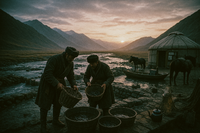
Ourid’s cultural identity has been shaped by three distinct phases: its Borealian roots, its emergence as a highland shrine‑city and its current integration into Bassaridia. During the Borealian period, the town reflected the secular yet multilingual character of the republic. In the highlands, Ourid became a centre of spiritual syncretism. Multiple sects—including mainstream Bassaridian shrines, the Order of Rochefort and other cultic offshoots—coexisted within layered shrine complexes. This mixture produced distinctive ritual music, carved iconography and inter‑shrine festivals, but it also allowed insurgent hierarchies to weaponize sacred architecture.
Under Bassaridian administration, Temple Bank auditors catalogue and cleanse compromised shrines, and reconciliation teams work to restore orthodox practices. Despite the political shift, Ourid remains deeply spiritual; pilgrimages continue under official supervision, and local craftspeople produce ritual masks, prayer scrolls and votive offerings. The presence of the Ouriana River adds a new cultural element—river festivals celebrating the seasonal flood and the life‑giving waters that connect the highlands to Lake Morovia.
Bassaridian Dependencies
Ourianian Dependencies
Tonar
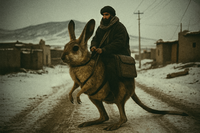
History
Tonar was originally a prosperous town in the northeastern region of the Kingdom of the Union of Caputia. During the immediate post‑civil‑war period, the city’s mixed population included adherents of the Melusinian Faith and the Stripping Path. The Order of Rochefort, newly returned to Caputia after swearing allegiance to Queen Elizabeth I, launched a campaign of forced conversions in Tonar and neighbouring Keybir-Aviv. Grand Master Lee Grantham imprisoned and tortured uncooperative nobles and prominent citizens. The heavy‑handed campaign led to the Yell of Tonar: a policeman was murdered while trying to free a woman resisting conversion, sparking a popular uprising. Negotiations ended the immediate violence, and the Order surrendered those responsible, but forced expulsions of Stripping Path followers continued. The Caputian government responded by authorizing Operation Cobalt, deploying 20 000 troops to suppress sectarian violence. The operation pacified Tonar at the cost of many lives. In the following years the Order’s influence waned; a daring raid near Tonar eventually captured and killed Lee Grantham.
After Caputia’s government collapsed during the Haifan Civil War, Tonar, along with other cities in former Caputia, endured lawlessness and bandit raids. A multinational Humanitarian Mission in former Caputia dispatched peacekeepers to the city; Palesmenian troops arrived days later to restore order.
By early 51 PSSC, Tonar had become a quasi‑independent city‑state in the western Valley of Keltia. Intelligence gathered during Operation Somniant exposed Tonar as a covert node in an insurgent logistics network linked to the Greater Morovian Independence Initiative and Order of Rochefort revivalists. On 61/2/51 PSSC, the Council of Kings Division launched Operation Bebéakáus Ski, a high‑precision airstrike that destroyed six ritual supply sites in Tonar. The strike targeted shrine nodes, chemical synthesis facilities and an underground archive that had supplied components for the Somniant Eidolan. Tonar’s merchant‑religious council lodged a diplomatic protest but took no military action. Surveillance indicated that insurgent activity remained high in the city’s shrine districts, prompting Bassaridian forces to monitor Tonar closely.
On 16/3/51 PSSC, the Sanctum of Returning Waters in Ourid was bombed, killing 66 civilians and War League personnel. A broadcast from Tonar-based insurgent Avenah of the Circle claimed responsibility. In response, the Council of Kings Division executed Operation Bebéakáus Ski II — a sustained aerial campaign against Tonar. Misttalon heavy bombers and Abeis-Minerva strike aircraft obliterated ritual broadcast towers, seminaries and liturgical compounds. No ground forces entered the city, but forward garrisons were established along escape corridors. The strikes reduced Tonar’s encrypted transmissions but did not eliminate resistance entirely. Phase Four of the campaign implemented an active containment regime: Centuriae patrolled the Tonar basin, signal‑jamming towers neutralized ritual broadcasts and targeted airstrikes destroyed rail links connecting Tonar to the west. An Order of Containment placed Tonar under Article X quarantine; shrine activity was proscribed, civil contracts annulled and all movement in and out of the city restricted.
In late 51 PSSC, the Temple Bank convened a Final Doctrinal Tribunal of Tonar. After reviewing forensic evidence from the Ourid bombing and ritual emissions recorded during the containment period, auditors designated Tonar a Ritual Containment Zone under indefinite ecclesiastical quarantine. The tribunal revoked the city’s civil privileges and suspended shrine charters until a future tribunal deems it spiritually compliant. Missionaries are allowed limited engagement along the perimeter, but Tonar remains legally and spiritually isolated.
Geography
Tonar lies in the western corridor of the Valley of Keltia, about 1,128 km west of Vaeringheim. The city occupies a basin in the northern foothills of the Lacaran Mountains, with ridgelines and tunnels linking it to Bashkim and Ourid. High altitude and rugged terrain give Tonar a cool, variable climate. The landscape is dotted with layered shrines, artisan districts and subterranean archives built into cliffs and hillsides. Unlike Bashkim (which sits at a river confluence) or Ourid (which is watered by the Ouriana River), Tonar lacks a major river; its water supply comes from mountain springs and small streams. The isolated geography made the city an ideal refuge for cultists and insurgents, and later a challenge for Bassaridian containment forces. Destroyed rail lines and Article X quarantine now sever Tonar’s overland connections.
Economy
Historically, Tonar’s economy revolved around artisanal crafts and ritual goods. The city’s “deep artisanal and ritualist traditions” produced liturgical instruments, mnemonic catalysts and other religious articles sought across Keltia. Under Caputian rule, commerce was diversified by agriculture and local markets, but forced conversions and sectarian violence disrupted economic life. After Caputia’s collapse, bandit raids and humanitarian crises undermined trade, prompting international peacekeepers to deliver aid.
During Operation Somniant, Tonar’s shrine archives and lithurgical dispensaries became clandestine nodes in an insurgent logistics network; critical components for conjuring the Somniant Eidolan transited through its facilities. The subsequent Bassaridian airstrikes destroyed most of this infrastructure. Under Article X quarantine, commercial activity is effectively suspended. Shrine charters and civil contracts are revoked, pilgrim traffic is banned, and signal‑blocking towers disrupt ritual broadcasts. Local craftspeople and traders remain displaced outside the city’s perimeter.
Culture
Tonar was once known for its vibrant ritual culture. Artisans crafted ceremonial masks, mnemonic tablets and liturgical instruments while scholars taught esoteric rites in shrine‑seminaries. The city’s deep ritualist traditions attracted pilgrims and provided a sense of identity distinct from neighbouring Bashkim and Ourid. However, the infiltration of the Order of Rochefort and the later insurgent coalition weaponized this spiritual heritage. Shrines were converted into command centers and ritual spaces became sites of indoctrination. The Yell of Tonar uprising, triggered by forced conversions, revealed a populace that fiercely defended its religious autonomy. Bassaridian airstrikes and the subsequent quarantine have devastated cultural life; shrines are closed, festivals suspended, and the city’s artisans and clergy live in exile. The Final Doctrinal Tribunal frames Tonar’s future as contingent on spiritual repentance and doctrinal compliance. Until then, Tonar exists as a cautionary tale—an isolated basin where once‑rich culture is preserved only through memory and the hope of eventual reintegration.
Caledonian Dependencies
Fanghorn

History
Situated in the eastern highlands of Keltia, Fanghorn figures prominently in the annals of Normark for the series of operations remembered as the “Fanghorn campaigns”, when the crown resolved to extirpate the intruder Knotaric from a mountain stronghold above the town. The first royal expedition vanished in the uplands, with only a scattered handful of survivors straggling back; a second expedition was planned but postponed amidst concerns that the initial force had been suborned or turned. These episodes embedded Fanghorn in the Normarker imagination as a testing ground of state resolve at the frontier between settled bailiwick lands and the wild fells, and they link the city to the long tradition of highland watch and ward that characterized eastern Østfold. In later decades, governance was regularized under the bailiwick system, and the surrounding district would cycle, as did much of Normark’s periphery, between consolidation and contested autonomy as wider Benacian realignments played out. In the present age, Fanghorn’s local authorities participated in the peaceful integration of the Eastern Caledonian Highlands, beginning with the registry of regional companies to the General Port of Lake Morovia on 159/3/51 PSSC, followed by the arrival of Reformed Stripping Path missionaries on 31/1/52 PSSC. After the deployment of War League elements to Fanghorn on 56/1/52 PSSC, negotiations between the Council of Kings and local officials culminated on 57/1/52 PSSC in the proclamation of the Dependency of Caledonia, recognizing Fanghorn and its sister highland cities as dependencies under the unified banner of the new polity.
Geography
Fanghorn occupies a shelf at the head of a steep valley on the eastern face of the Caledonian massif, where ridge paths and engineered galleries have historically controlled movement between the lakeward lowlands and the interior high fells. The town’s approaches are defined by cliff roads susceptible to rockfall and landslip, while the immediate environs blend conifer upland with river‐cut ravines that once facilitated both timber drift and the movement of watch patrols along the escarpments. As an upland bailiwick of Østfold, the settlement sits within the broader physiographic partition that set coastal trading places and inland highland marches into a single administrative framework, an arrangement that has long conditioned the city’s logistics, seasonal access, and reliance on engineered connections to neighboring bailiwicks.
Economy
Historically, Fanghorn’s economy combined managed forestry, quarrying of cliffstone for regional public works, and a small but persistent hospitality trade oriented to funicular and ridge‑path tourism in calmer times. The modern era has seen formalization of a branded highland textile and botanicals sector (exemplified locally by the house known as Fange Velvet), alongside service logistics supporting shrine traffic and security operations along the ridge roads. Integration into the dependency framework has redirected caravan and bonded‑goods flows toward the General Port of Lake Morovia, while highland artisanal enterprises have increasingly synchronized their registries and labeling with national standards to benefit from export corridors opened by the 51–52 PSSC reforms.
Culture
Culturally, Fanghorn retains the highland rites and seasonal observances that predate incorporation into any wider commonwealth, with local guilds curating a memorial culture around the vanished first expedition of the Fanghorn campaigns. Folklore of watchposts, funicular bells, and ridge lights, once bound to royal duty, now inflects civic festivals and mountain‑rescue volunteerism; ward‑level societies blend upland customs with shrine‑affiliated practices introduced by the Reformed Stripping Path mission circuits after 52 PSSC. The result is a pragmatic liturgical calendar that times fairs, repairs, and transhumance to weather windows as much as to doctrine.
Eikbu
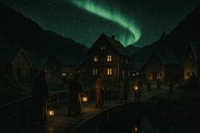
History
Eikbu developed as a high-mountain bailiwick in the eastern marches of Normark, serving as a northern sentinel above Fanghorn and controlling the saddle routes that thread the upper spine of the Eastern Caledonian Highlands. In pre-Bassaridian chronicles the town appears in the same frontier theatre that produced the “Fanghorn campaigns,” when royal expeditions pressed into the high fells and established a chain of watch huts and muster stones along the ridge. During the later era of intrusions and irregular visitations, local wardens in Eikbu coordinated with regional militia to suppress panic, keep beacon discipline, and maintain open passage over the snow roads, a posture that shaped a civic culture of caution, mutual aid, and efficient rumor control. With the regularization of the bailiwick system under the eastern jurisdictions of Østfold, Eikbu’s ward councils codified their long-standing road duties, gallery upkeep, and avalanche response as formal public works. In the 51–52 PSSC integration cycle, Eikbu followed its southern neighbor Fanghorn in aligning ledgers and guild marks with lake-facing trade houses, hosting Reformed Stripping Path mission schools and clinics, and acceding to the articles that recognized the Dependency of Caledonia.
Geography
Eikbu is a mountain city set north of Fanghorn on a periglacial bench below the crest of the eastern highlands. The town occupies a sequence of stone terraces cut into schist and grit, bounded upslope by cornice-forming ridgelines and downslope by hanging valleys whose torrent creeks plunge toward distant headwaters. Permafrost lenses, frost-heave, and talus fans complicate foundations and street alignments, so stair-courts, rock-bolted galleries, and snow sheds dominate the urban fabric. Winter brings rime, whiteouts, and slab risk on the lee faces; summer concentrates meltwater into brief surges that test culverts and retaining walls. Lines of sight are to ridge and sky rather than to any basin, and the town’s orientation—by necessity—has always been to passes, saddles, and the next wayhouse along the spine.
Economy
The economy of Eikbu is characteristic of a high-ridge canton. Guiding, pass-maintenance contracting, and cable-and-tramway services provide year-round work, while compact smithies and ropewalks produce pitons, crampons, hemp lines, and snow-saw fittings for the corridor. Small hydropower wheels on torrent creeks turn looms and saws through the thaw months; goat and reindeer herding on windward meadows supplies hides and smoked meats for caravan depots. Medicinal and dye plants gathered from the krummholz belt feed cottage-scale curing houses whose lots are forwarded overland to market towns such as Fanghorn or on to the fjord depots by way of relay caravans. After registry harmonization in 51 PSSC, invoices from Eikbu’s guilds began clearing under the same bonded documentation used in the lake ports, improving insurance terms for winter convoys and stabilizing prices for ridge gear.
Culture
Highland custom gives Eikbu a spare, practical liturgy keyed to weather windows and road safety. Beacon-tests at first snow, lantern descents along the gallery line at the formal reopening of the pass, and oath-taking for wardens and guides at the ridge cairn remain central rites. Since 52 PSSC the Reformed Stripping Path has overlaid this calendar with mission schools, clinic rotations, and stipend kitchens, yet the parish teachers have generally adopted local forms—recording vows beside the horn-and-slate tablets at the tarn, publishing avalanche notices in both shrine script and the old runes scratched at trailheads. Music, banner work, and stone carving favor antler, knot, and cornice motifs; the civic virtue most prized is the unadorned one the town has practiced since the first watch huts were raised on the spine: keep the way open, share the rope, and bring travelers safely through.
Galvø

History
Galvø is an old foothill bailiwick of eastern Keltia that has long served as the upland companion to the ridge settlements further south and east. In the Normarkian era it was administered among the interior districts of Østfold, supplying timber, stone, and drovers to the regional roadworks and muster rolls that connected the high marches with the northern ports. The town’s watch lists and ward charters record periodic reinforcement during the same frontier decades that set Eikbu and Fanghorn against incursions on the spine, and its councils became known for keeping the saddle approaches open when winter or war pinched traffic along the crest. In the fifth decade PSSC the town entered the Eastern Caledonian integration sequence: local firms regularized their marks and ledgers under the General Port of Lake Morovia on 159/3/51, itinerant teachers of the Reformed Stripping Path opened schools and kitchens on 31/1/52, and, after brief stabilization patrols on the corridor, negotiations concluded on 57/1/52 with Galvø’s recognition within the Dependency of Caledonia.
Geography
Galvø lies in the northern foothills of the Eastern Caledonian Highlands, to the north-west of Eikbu. The settlement is strung across low ridges and benches that step down from the buttresses of the spine toward the broader upland plain. Morainic soils, scattered tors, and frost-heave shape its plan: terrace lanes and stair-courts climb from a central green to neighborhoods perched on rock shelves, while culverts and stone causeways carry meltwater beneath the roads in thaw. Old quarry faces and timber drifts skirt the town’s edge, and bridle paths radiate toward the passes that tie Galvø to Eikbu, Fanghorn, and the caravan alignments leading down to the northern ports.
Economy
The economy is that of a foothill entrepôt with workaday specialisms. Sawmills on the torrent creeks turn spruce and fir from the higher belts; small quarries lift paving stone and walling blocks from the scarps above the town; and drovers’ sheds and wagonshops serve the mule and ox teams that move supplies between ridge and plain. Cottage houses cure dyestuffs and medicinals gathered from the krummholz and heath, forwarding lots to the larger market towns of the corridor. Since the registry harmonization of 51 PSSC the bailiwick’s invoices clear under the General Port of Lake Morovia schedule, which has tightened quality marks, eased insurance on bonded consignments, and financed the periodic re-decking of the causeways and culverts that keep traffic moving when the thaw comes fast.
Culture
Foothill custom gives Galvø an ethos of steadiness and service to the road. The civic year opens with a beacon-lighting on the west bluff and closes with a procession of lamplighters who walk the causeways to thank the engineers and culvert crews for a safe season. Guilds of sawyers, masons, and drovers sponsor the hill fair on the green, and ward societies maintain the wayhouse shrines that offer shelter and hot broth to travelers in blowing snow. Since 52 PSSC the Reformed Stripping Path has added schools, stipend kitchens, and a small clinic, but parish teachers have generally folded new instruction into familiar forms—posting weather notices beside the old trail tablets, blessing tools at the same stone crosses where drovers have sworn road oaths for generations.
Sårensby

History
Sårensby is recorded as one of the most populous bailiwicks of Normark, a status that matched its function as a strategic hinge in the country’s preferred “direction of travel” between mountain and sea. Its local chronicle tracks civic growth through the bailiwick rolls, with population share and guild rosters peaking during periods of regional stability and ebbing during wider Benacian crises. The town figures repeatedly in reconstruction plans and integration commissions tied to Østfold, reflecting its value as a transport and armaments node. In the present period, Sårensby entered the dependency via the common 51–52 PSSC sequence of registry, mission circuits, and diplomatic recognition.
Geography
Situated on firm ground at the edge of marsh and quay, Sårensby is laid out along an esplanade that fronts on an ice‑prone gulf, with rail and road spurs arcing inland to the highlands. Its docks and arsenal yards define the skyline, while residential wards extend along sheltered lanes that avoid the worst of gulf winds. The town’s position—far enough inland to command multiple approaches yet close enough to control a working harbor—has long dictated its strategic relevance.
Economy
The economy blends harbor services, depot logistics, and yard trades connected to the arsenal and drydocks. In recent years, integration with dependency systems has formalized stipend kiosks, bonded‑store procedures, and contractor credentials—administrative details that matter greatly in a town where gate throughput and shift changes set the pulse of daily life. Local syndicates are notable for their technical schools and apprenticeship programs, which dovetail with regional transport operators and the Trans‑Keltian Express branch that historically touched the district.
Culture
Sårensby’s cultural life is martial‑civic and harbor‑facing: ship‑blessing rites at slipways, stipend‑day markets on the esplanade, and commemorations for dockyard incidents and rescues. The town’s shrines support merchant sailor families and arsenal workers alike, and since 52 PSSC have coordinated with Reformed Stripping Path houses to expand clinics and night schools. A robust volunteer‑watch tradition persists, tempered by lessons learned from cyber and aerial threats in the late pre‑dependency period.
Slevik

History
Slevik is a historic bailiwick of eastern Østfold and—by local pride—the birthplace of Waldemar Tarjeisson, a prominent Normarker statesman whose career, in exile and at home, spanned the tumult of the 17th and 18th centuries AN. As Østfold cycled through separation and reintegration, Slevik’s port and guilds provided a durable anchor for coastal commerce and local politics. The town’s modern history includes the formalization of the “Amber Ports” brand for bonded amber and resin exports, and the streamlining of harbor procedures as Normark reorganized its bailiwicks and guard services. Slevik’s participation in the 51–52 PSSC integration sequence followed the regional pattern and culminated in dependency recognition with its highland peers.
Geography
Facing a fjord‑like inlet on the east Østfold coast, Slevik straddles the transition from low drumlin shore to rocky points that shelter its inner quays. The harbor’s natural protection, complemented by signal beacons and ice‑season practices, made it a preferred embarkation point for coastal and lake traffic in calmer eras, and a defensible node in leaner times. The town plan radiates from the quay steps through warehouses to terraced streets and parish greens.
Economy
Harbor services, bonded warehousing, and the handling of resins, fish, and timber define Slevik’s economy. Registration with the General Port of Lake Morovia system in 51 PSSC codified weighing, stamping, and customs routines, while dependency status eased reciprocal recognition of guild certifications. The town’s amber drying kilns and polishing lofts—regulated to modern safety codes—support both export lots and a small domestic craft sector.
Culture
A seafaring civic culture persists, with quay‑front guild chapels and brass bands marking the launch of each fishing and coaster season. Slevik celebrates its connection to Waldemar Tarjeisson through exhibitions and lectures on Normark constitutionalism, while shrine houses and mission halls sponsor literacy and seamanship courses that anchor youth in a town where work and weather are closely joined.
Sjøsborg

History
Sjøsborg is among the classic urban bailiwicks of the old Normark realm, noted in campaign literature and chancery rolls for its command of the northern arctic littoral of Keltia. During the campaign of 1717–1720, the “Sjøsborg battles” underscored the city’s role as a choke-point on the polar sea lanes, with control of the headlands enabling thrusts toward Sårensby and Elijah's Rest while shielding approaches into Østfold. In the subsequent reform era, Sjøsborg’s municipal institutions were consolidated within the Norse fylke model and retained electoral primacy to the Nordisketing. In the modern period of reintegration and coastal standardization, the city resumed its function as a principal arctic entrepôt, administering pilotage, convoy signaling, and bonded quay operations for traffic transiting the Normark–Lindley Passage.
Geography
Sjøsborg occupies a low, permafrost-bound headland on the northern, arctic coast of Keltia, straddling the margin of the Normark–Lindley Passage. The urban footprint climbs terraced rock shoulders above a skerry-strewn roadstead, with ice-scoured coves, tide-rips at the channel narrows, and offshore shoals marked by a chain of beacons and range lights. Inland, drumlinized rises and patterned ground support ward precincts linked by wind-screened lanes; seaward, breakwaters and ice booms moderate pack-ice pressure during winter drift. The city’s setting is purely maritime and polar—there is no lacustrine frontage and no connection to the Morovian basin.
Economy
The Sjøsborg economy integrates arctic port services—ice-class pilotage, cold-chain warehousing, and hull/rigging yards—with fisheries, kelp and resin processing, and coastal convoy logistics. Bonded auction floors and inspectors handle amber consignments, timber billets, and pelagic catches for the polar convoy network; stipend halls, insurers, and registry clerks cluster around the bailiwick chancery. Seasonal ice regimes structure throughput: winter emphasizes ice-pilot services and fuel bunkering for convoy escorts; the brief summer window concentrates quay turns and heavy yard refits.
Culture
Civic life follows a Norse maritime grammar adapted to the polar year: lamp-blessing rites at “first light,” guild processions on stipend day, memorial liturgies tied to the 1720 campaign cycle, and a lantern regatta threaded between beacon towers at the opening of safe navigation. Archives and museums curate bailiwick electoral rolls, pilot logs, and campaign dispatches; parish greens host oath-taking and winter fairs; and technical schools train ice pilots, yard fitters, and radio watchkeepers for the passage.
Storesund
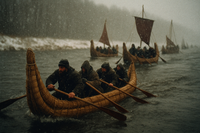
History
Storesund stands with Galvø, Jelsinga, and Slevik as one of the four principal bailiwicks that defined Østfold in its mature constitutional form. Normarkian censuses and league ledgers record Storesund as a populous coastal municipality whose institutions—customs house, bonded exchanges, and dock guilds—anchored the arctic river-sea trade. In the reintegration cycles following early-eighteenth-century conflicts, the city re-established its legal and fiscal baselines and, under modern registry practice, resumed its role as a metropolitan counterweight to Sjøsborg on Keltia’s northern arctic coast, administering intermodal links between inland river lines and the polar convoy network.
Geography
Storesund occupies an estuarine delta on the arctic shore where braided distributaries from the interior meet a shallow, tidally influenced littoral. The urban plan is amphibious: long stone-and-timber quays trace stabilized channels; levees, flood basins, and ice booms manage surge and spring breakup; and a triangulation of lighthouses, range lights, and daymarks governs approaches from the polar sea. Inland wards sit on firmer, slightly elevated ground; reed marshes and permafrost patterned ground define the margins. The site is wholly coastal—no lacustrine frontage or Morovian linkage exists.
Economy
Port logistics and river–sea intermodal services dominate Storesund’s economy, supported by fish processing, sawmilling, boatbuilding for shallow-draft craft, and resin finishing. Customs inspectors and bonded clerks operate along a modernized esplanade that harmonizes stipend, assay, and auction procedures for polar shippers. Railheads and winter roads marshal cereals and timbers from the interior; barge trains and coasters distribute finished goods to coastal bailiwicks under standardized manifests and insurance. Yard trades maintain convoy auxiliaries and delta workboats, while cold-chain engineers, environmental stewards, and pilots round out the skilled labour pool.
Culture
Storesund’s culture is that of a working river-sea port: dockside chapels and guild halls punctuate the levee; river-opening festivals and reed-boat regattas mark the calendar; and club football remains a civic lingua franca, with Storesund FK’s colours visible from the esplanade to the upland wards. The bailiwick’s maritime archives and Østfold studies institutes sustain a literate public sphere, while parish schools, mission hospitals, and technical colleges supply the convoy and delta trades. Public rituals of oaths, lanterns, and bells encode the long-standing compact among shrine, guild, and municipality.
Notranskja
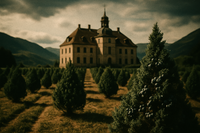
History
Notranskja stands apart among the dependency’s cities for its long pre‑Bassaridian association with Ocia, where it served as an interior district in a vast, thinly populated expanse. Prior to the East Keltian realignments, the region around Notranskja was characterized by dispersed settlements, subarctic climate, and a political geography that left it distant from ocean harbors yet pivotal to land corridors. In the fifth decade PSSC, local communes and market syndicates—foremost among them the White Ruby Communes—registered with the General Port of Lake Morovia on 159/3/51 PSSC, setting the stage for mission circuits (31/1/52 PSSC) and, after negotiations and a limited security deployment, for recognition on 57/1/52 PSSC of Notranskja as part of the Dependency of Caledonia.
Geography
The wider Notranskja belt runs across a cold interior of taiga, muskeg, and stone‑ribbed hills. Winters are severe and long, summers bright and brief, with inland routes threading between lakes and fen. The climate regime, attested in older Ocia surveys, shaped a settlement pattern of nucleated townships linked by winter roads and seasonal ferries, and it continues to condition modern planning for energy, insulation, and logistics.
Economy
Historically reliant on fur, timber, and hardy cereals, Notranskja’s communes modernized around cooperatives that pooled equipment and storage, with the White Ruby Communes setting norms for grain elevators, voucher redemption, and quality control. Integration into the dependency’s trade grid has connected these co‑ops to bonded rail and port services, encouraging crop diversification, peat and biomass experiments, and cross‑season employment in road, bridge, and depot maintenance. Registry within the lake‑port system has also stabilized stipend flows and investor oversight.
Culture
Cultural life in Notranskja reflects the demands of the subarctic interior: communal ovens and bathhouses, winter lecture circles, and mutual‑aid societies that straddle commune and shrine. The mission wave of 52 PSSC seeded Reformed Stripping Path houses that, rather than supplanting the rites of the communes, have served to regularize poor relief, schooling, and medical rotation. Festivals key to the agricultural cycle—ice‑break, first‑light, and harvest—structure the civic calendar, with the White Ruby co‑ops underwriting customary feasts that bind the townships into a coherent region.